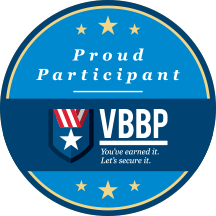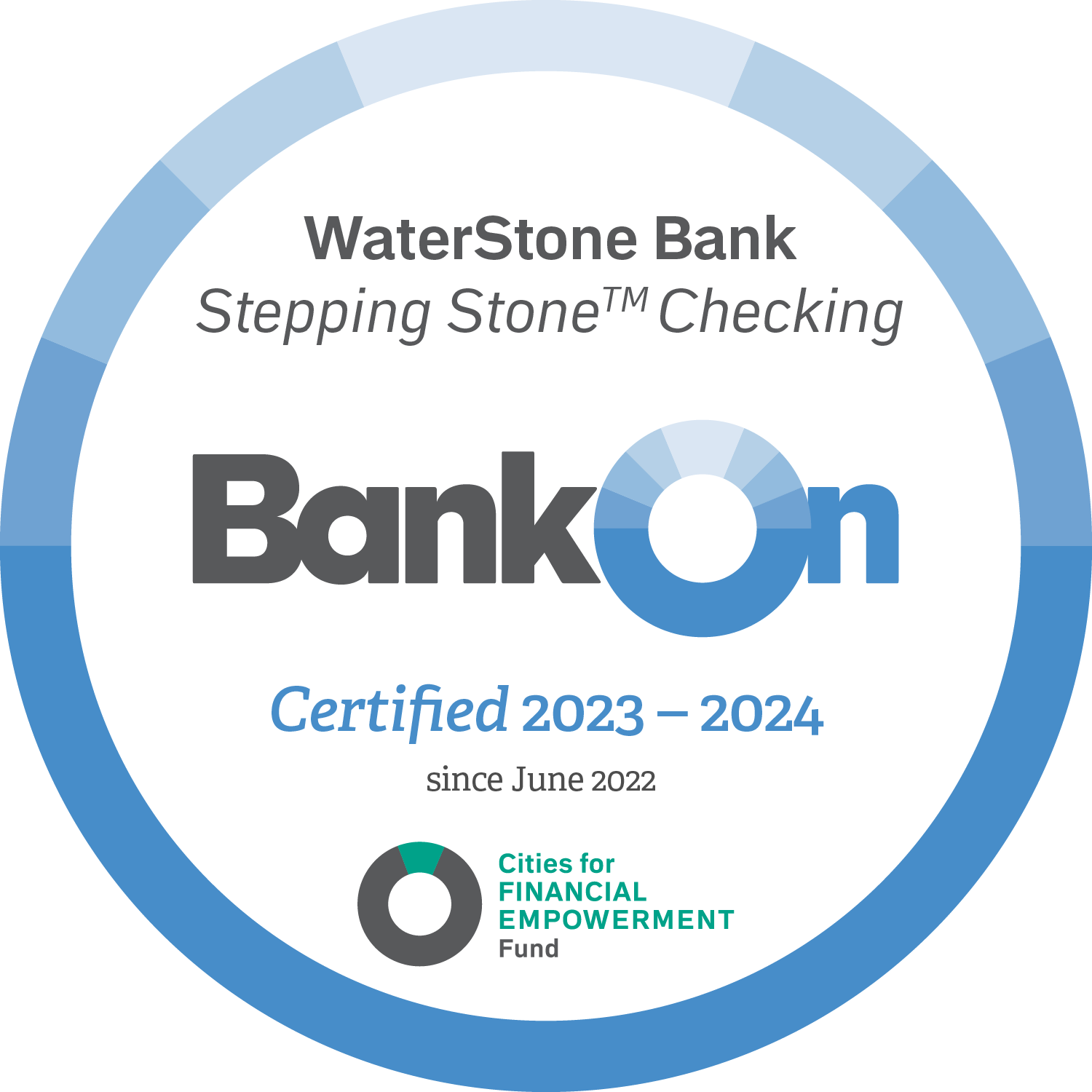Categories
all
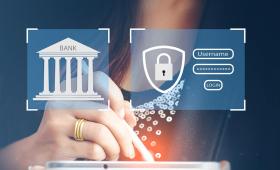
Banking
Posted: April 15, 2024
The digital age has brought us many things: social media, e-books and streaming services. It’s also changed the way we live our lives, from online shopping to food delivery apps, GPS directions to virtual meetings.
One of the most significant—and convenient—innovations of our time is online banking. Online banking has evolved from checking your balance online to connecting bank accounts, whether they’re at the same bank, different banks or third-party apps. The goal of connecting your accounts is to make it easier for you to manage your money, but many people still have questions about the security of linking accounts.
Linking accounts at the same bank
It’s not uncommon to have multiple accounts at the same bank, e.g. checking and savings. It’s simple to link these accounts on your bank’s website or app and makes it easy to transfer funds from one account to another. Some banks also provide incentives for people who link these accounts, like waiving monthly maintenance fees or overdraft fees.
Linking accounts at different banks
Some people maintain financial accounts at different banks; for example, they may keep their checking at one bank and their mortgage at another. It is possible—and perfectly safe—to keep accounts at separate banks but link them so you can easily move money between them. Many banking sites allow users to check information for both accounts in one place, but may have processes in place regarding how transfers can be made.
Linking accounts to third-party apps
Third-party finance apps like Venmo, Zelle, Cash App, PayPal and PocketGuard offer consumers alternate ways to manage their money, whether it’s to transfer money or track and manage spending. Though these apps are secure and safe to use, they do access sensitive information like bank account and credit card numbers. They don’t have the same kind of secure backing found at banks, but some are protected by the Electronic Fund Transfer Act, which protects consumers against unauthorized transactions.
Before you connect a third-party app to your bank accounts and credit cards, do your homework. Make sure the app is reputable and offers protection against unauthorized transactions.
How to link accounts
Linking accounts at the same bank is typically done automatically and simply requires a single sign-in to your bank’s website. Linking external bank accounts requires additional information and may vary by financial institution. In general, it’s smart to follow these steps:
- Gather relevant information, like account numbers, routing numbers and logins.
- Log in to your bank’s website or app and find the option to link or add an external account. The option may be on the dashboard or in settings.
- Select or type in the bank or financial institution you want to link.
- You might need to log in to the other bank you’re linking.
- Complete the verification process, usually sending a small deposit to confirm the accounts are linked.
The safety question
So, is linking bank accounts secure? Banks and credit unions utilize a variety of features to ensure safety, including:
- Transport layer security encrypts data, preventing hackers and cybercriminals from accessing your personal and account information.
- Tokenization involves exchanging data by converting it into tokens, which hide private information.
- Multi-factor authorization requires users to verify their identity using a numerical code sent to via text or email, PIN, fingerprint, or facial recognition.
Even with these safeguards in place, it’s important to take precautions when it comes to sensitive information. Keep passwords and PINs private, use two-factor authentication whenever possible, and research third-party finance apps before linking your accounts.
Still have questions? Contact us for more information.
 3 minutes read
3 minutes read
Finance
Posted: April 9, 2024
As tax day approaches, it’s important to understand the different tax brackets and what that means for you. Your tax rate is determined by your taxable income and filing status, which will drop you into one of seven tax brackets for 2023. Each bracket is assigned a corresponding tax rate; the highest rate, called a marginal rate, only applies to a portion of your income (more on that later). This system means that people with higher incomes pay higher federal taxes, and vice versa.
Federal rates will remain the same until 2025, thanks to the Tax Cuts and Jobs Act of 2017; however, the IRS may adjust thresholds for inflation.
2023 Tax Brackets
There are four main filing statuses when it comes to taxes:
- Single filers
- Married filing jointly
- Married filing separately
- Head of household
Your income based on these filing statuses will determine your overall tax rate for the year.
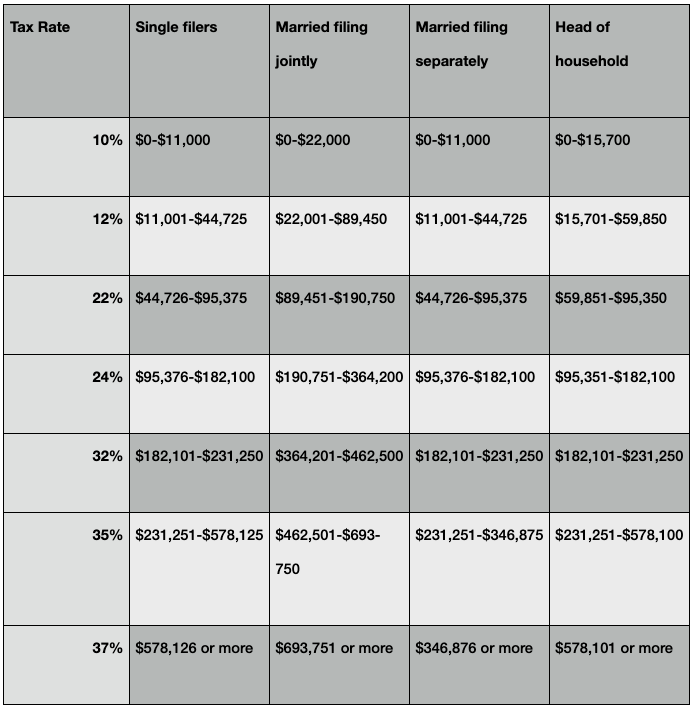
For example, a single filer who made $50,000 in 2023 is in the 22% tax bracket. However, to complicate (but improve!) matters, this person won’t pay 22% on their entire income. Instead, their tax breakdown will look like this:
- $0-$11,000 of their income is taxed at 10% (approx. $1,100)
- $11,001-$44,725 of their income is taxed at 12% (approx. $4,047)
- $44,726-$50,000 of their income - only $5,274 - is taxed at 22% (approx. $1,160; this is the marginal rate)
That adds up to a tax bill of $6,300 ($5,147 plus 22% of the amount over $44,725), or 13% of this person’s taxable income - even though they are technically in the 22% bracket.
So, what is that 13%? The 13% is called an effective tax rate, which is the percentage of taxable income that you actually pay in taxes. To calculate this more easily, divide your total tax owed (line 16) by your total taxable income (line 15) on your Form 1040. The charts below can help give you an idea of what you owe.
Single filers
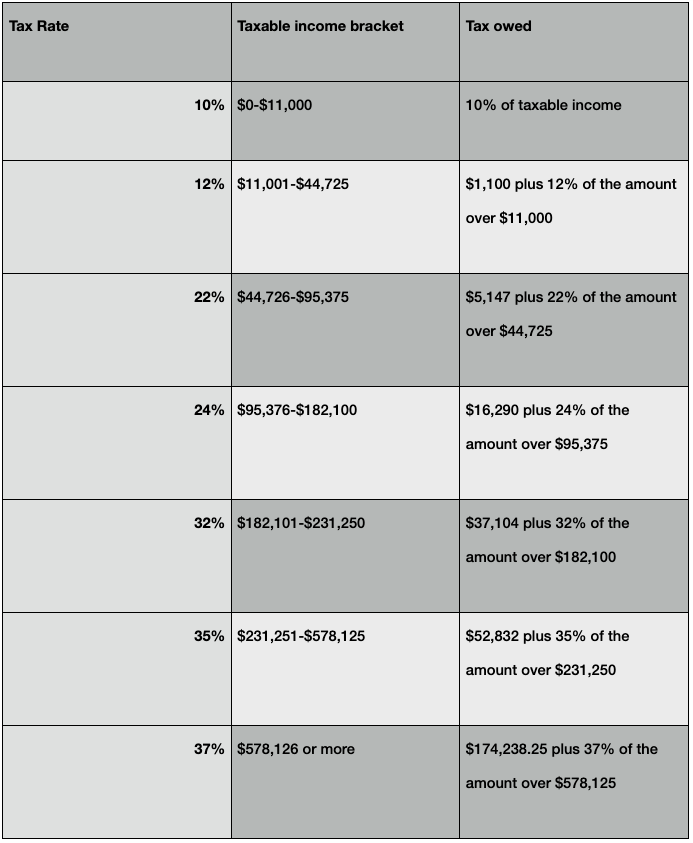
Married filing jointly
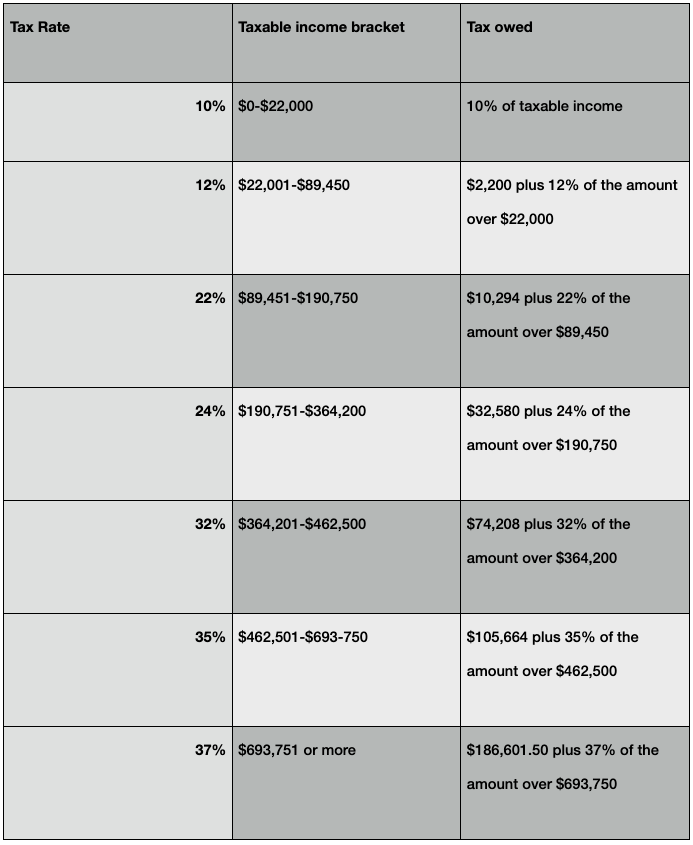
Married filing separately
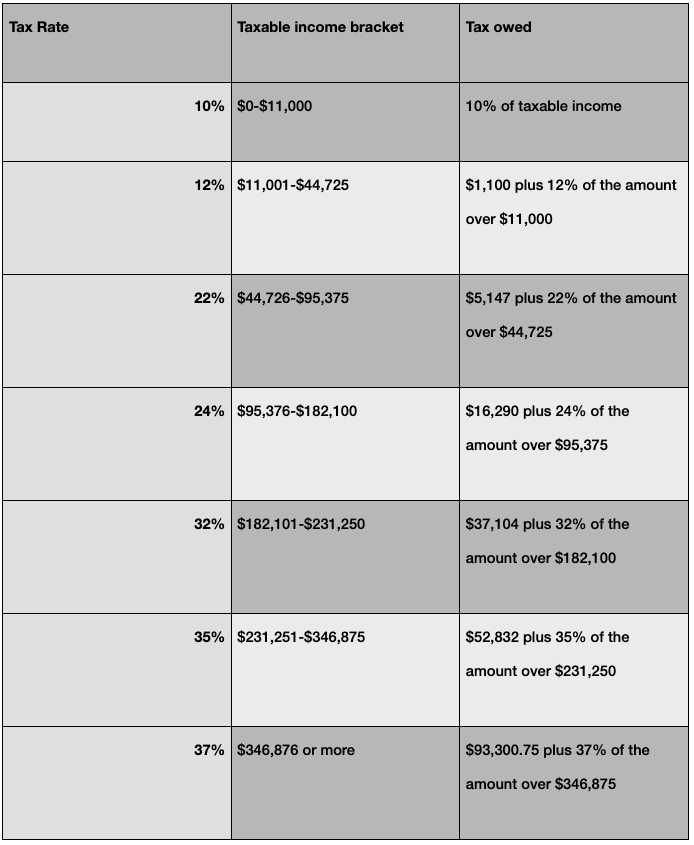
Head of household
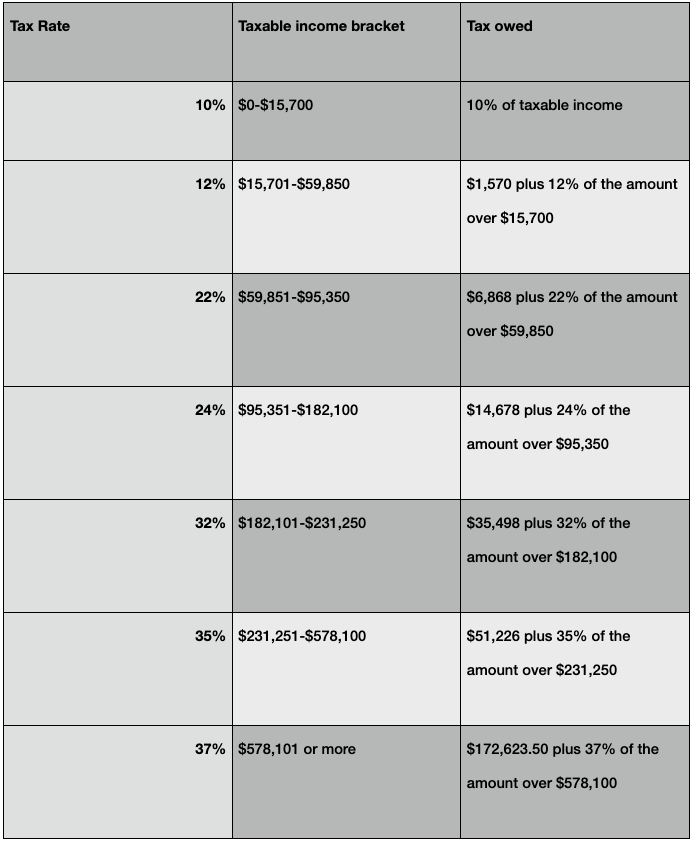
Reducing taxes owed
Finally, there are two ways to reduce your tax bill: credits and reductions. Credits reduce your bill on a dollar-for dollar basis and don’t affect your tax bracket. Deductions reduce how much of your income is subject to taxes. Check out our Delving into Tax Deductions blog for more info!
 5 minutes read
5 minutes read
Finance
Welcome to the world of financial literacy, where the right information can transform your relationship with money and set you on the path to success. In this blog post, we will be reviewing five of Amazon’s top-selling finance books, because whether you’re a seasoned investor or a financial newbie, you can always learn something new. These books’ invaluable insights are reader-approved to help you reshape the way you think about and manage your money.
- The Simple Path to Wealth by J.L. Collins
Author and financial expert J.L. Collins provides a straightforward and practical approach to achieving financial independence in The Simple Path to Wealth. The book emphasizes the power of long-term investing in low-cost index funds and addresses common pitfalls, such as debt, that can hinder financial success. Collins’ conversational style and relatable anecdotes make complex financial concepts accessible to readers of all levels of financial expertise.
- I Will Teach You to Be Rich by Ramit Sethi
In this comprehensive guide that covers everything from budgeting to investing, Ramit Sethi combines financial advice with a touch of humor, making it an engaging read. The book focuses not only on building wealth, but also encourages readers to define—and then design—a rich life for themselves by aligning their spending with their values. Practical and action-oriented, this book is an excellent resource for those looking to take control of their finances.
- The Millionaire Next Door by Thomas J. Stanley and William D. Danko
More than four million copies have been sold since this book was published in 1996. Although the societal landscape looks very different today than when the book came out, the fundamentals behind Stanley and Danko’s research into how ordinary citizens become millionaires remain true. The authors’ deep dive into the habits and mindsets of the “next-door millionaire” reveals that living frugally while prioritizing saving and investing are behaviors that contribute to long-term financial success.
- The Psychology of Money by Morgan Housel
When it comes to money, what you know isn’t as important as how you behave, argues Morgan Housel. Attitudes shaped by experience and societal expectations can play a key role, as Housel shows in this exploration of the different—and often irrational—ways that people deal with financial matters. Anchored by 19 short stories, The Psychology of Money provides a look at the strange outcomes that can result when thoughts and feelings collide with logic, belying the school of thought that finance is purely a numbers game.
- The Intelligent Investor by Benjamin Graham
Regarded as a classic in the world of investing since it was first published in 1949, The Intelligent Investor remains widely acclaimed for its timeless principles for wise investing. Benjamin Graham’s insights, adapted for modern investors by financial columnist Jason Zweig, emphasize the importance of a disciplined approach to investing.
Remember that financial education is an ongoing journey. Each of these books adds a unique perspective to your personal finance bookshelf; together, they form a wide-ranging collection to guide you on the way toward achieving financial well-being. Visit your local WaterStone Bank branch to speak with a banker and find out how we can assist you on your financial journey.
 4 minutes read
4 minutes read
Finance
From essays to applications, there is a lot that goes into preparing for college. Chief among them is the Free Application for Federal Student Aid, or FAFSA, form. It’s smart to complete the FAFSA form as soon as it’s available, because federal funding is limited.
What is FAFSA?
FAFSA is an application for federal student aid, including federal grants, work-study programs, and loans, for prospective and current students. Some states, colleges, universities, and private lenders also use information from FAFSA to determine students’ eligibility for financial aid. You must complete the FAFSA form for each year you plan to apply for federal aid.
Information reported on the FAFSA form is used to calculate the student’s Expected Family Contribution (EFC). This measures a family's financial capacity, determines how much federal aid a student is eligible for, and may be used by your state and schools to determine grant and scholarship eligibility.
When do I need to fill out FAFSA?
FAFSA for the next academic year becomes available on October 1. So, if your student is a rising senior and plans on attending college beginning with the 2025 fall semester, FAFSA will become available on October 1, 2024.
Many colleges have different FAFSA deadlines, so be sure to check each school’s financial aid office. If you’re not sure which schools you’re applying to, that’s OK—just list the ones you’re interested in. Different states also have different deadlines.
Officially, the U.S. Department of Education’s federal deadline to complete FAFSA is June 30; however, the sooner you submit your form, the better. Aim for December at the very latest.
Who should fill out FAFSA?
According to studentaid.gov, “The Free Application for Federal Student Aid (FAFSA) form is the student’s responsibility, but when a student is considered a dependent student for FAFSA purposes, parents have a large role in the application process.”
When filling out the form, it is important to identify who the student’s primary parent(s) are.
- Parents married to each other: report information for both parents on FAFSA.
- Parents who are unmarried but live together: report information for both parents on FAFSA, even if they were never married, are divorced or are separated.
- Parents who are unmarried and do not live together: if a student lived with one parent more than the other for the last 12 months, they should report that parent’s information on FAFSA. If they spent an equal amount of time living with each parent, they should report the information of the parent who provided more financial support over the last 12 months. If the reporting parent has remarried, also report information for the stepparent on the FAFSA form.
Per studentaid.gov, it is important to note that “dependent students are required to report parent information when completing the FAFSA form.” This includes biological and adoptive parents and legal guardians. Stepparents are considered parents if they are married to a biological or adoptive parent and if the student counts in their household size.
Students who were not dependents of their parent(s) or legal guardian(s) for the last 12 months should fill out the FAFSA form with their own information.
What do I need in order to complete FAFSA?
Parents and children should gather the following materials prior to completing the form:
- Social Security number, or Alien Registration number for non-U.S. citizens who are eligible noncitizens.
- Federal income tax returns, W-2s and other records of money earned.
- Bank statements and records of investments, if applicable.
- Records of untaxed income, if applicable.
To get started, one parent and the student must both create FSA ID usernames and passwords, which they will use to sign in. Students must also create a save key, a temporary password that enables them to return to partially completed FAFSA forms.
How do I complete FAFSA?
There are three options when it comes to filling out the FAFSA form:
- Log in at fafsa.gov to complete the form online.
- Complete the FAFSA PDF for the award year you’re applying for. In this case, you must print and mail the FAFSA PDF for processing.
- In some cases, schools may submit the FAFSA form for students.
Technically, the form is the student’s application, so where it says “you” on the form, it means the student.
You may use the IRS Data Retrieval Tool (IRS DRT) to transfer your federal tax return information into the FAFSA form. Once you submit your form, you will see a confirmation page and may also see a link to your state’s financial aid application. You may be able to transfer your federal information into the state application. Parents who have more than one child attending college can transfer their information to their other child/children’s FAFSA form(s).
What happens next?
You will receive a confirmation email that your FAFSA form has been submitted, processed, and sent to schools. You may check your application status online or by phone at 1-800-4-FED-AID.
After your application is processed, the student will receive a Student Aid Report. It is important to review this to ensure your information is correct and complete. Students typically receive federal, state and scholarship aid offers from schools in the winter and spring. studentaid.gov has great resources for understanding and comparing aid offers and what they mean for financing education.
Still need help? Visit Federal Student Aid for more information, tips and frequently asked questions.
 5 minutes read
5 minutes read
Finance
One goal that resonates with many Americans is becoming wealthy, although that means different things to different people—for some, it’s comfort and security, for others lottery-winner-level luxury. Get-rich-quick scenarios aside, for most of us, the key to making that wish for wealth a reality is disciplined saving and investing. In Part I of our Smart Money Goals post, the emphasis was on fundamental approaches to setting yourself up for future financial success. Now in Part II we delve into five tactics to help grow your affluence over time.
- Automate your savings
Accumulating savings is a precursor to investing. To ensure consistent contributions to your wealth-building journey, automate your savings. Through your employer or your bank, arrange automatic transfers of a portion of every paycheck into separate savings or retirement accounts. If your employer offers a 401(k) or similar plan, have your contribution automatically withdrawn from your paycheck and deposited into your account. Financial advisers recommend contributing at least enough to maximize your employer’s matching contribution in retirement plans.
- Reminder to rebalance
Out of sight is not out of mind. Even though your deposits are set up to operate without much input, it’s important to periodically revisit your accounts and adjust them as necessary. Schedule a quarterly, semi-annual or annual fine-tuning session.
- Bump up the savings rate
From time to time, boost your savings percentage, especially when you receive a raise or a bonus. These small increases can pay off over the long term. Take advantage of money market accounts that earn interest. If you won’t need access to your money for several months, CDs can be a good option.
- Invest for growth
While savings accounts offer security, inflation may outpace any interest you earn. For a greater payoff, you can put your capital to work with investments—a good place to start is with the basics: stocks, bonds and mutual funds. Since all types of investments perform differently, and investing carries inherent risk, spreading your capital around into diverse types of investments can be a sound tactic. Attempting to predict what’s going to happen with the stock market is risky. A safer approach is practicing discipline by staying invested in a diversified portfolio, even during downturns.
- Watch out for the fees
Different investments include different kinds of costs—expense ratios, custodian and maintenance fees, and loads and commissions are just a few. It’s worth educating yourself about what types of costs are associated with your investments, and to recognize that these costs that start out as a small percentage can add up fast, especially as your investment grows in value. Choosing lower cost purchases will soften the sticker shock.
Building wealth is a long-term goal: Earning interest and making wise investments puts your money to work for you behind the scenes, while you go on about your life. Strategic financial habits will help you pave the way and weather setbacks on your way to achieving financial success. Visit your local WaterStone Bank branch to speak with a banker and learn how you can start taking steps to building wealth.
 3 minutes read
3 minutes read
Finance
The journey to financial well-being begins with setting clear, attainable goals. These objectives will not only provide a roadmap for financial success but are also the building blocks for future stability. This two-part post covering short- and long-term financial goals begins with five actions that will set you up for financial success in the new year and beyond.
- Emergency Fund: Build or Replenish
Establishing or replacing an emergency fund is a crucial short-term goal. Aim to save enough to cover three to six months’ worth of living expenses. Consider housing, utilities, transportation, insurance and medical costs, among others. This fund serves as a safety net for unexpected expenses or sudden changes in your circumstances.
- Pay Off High-Interest Debt
Prioritize paying off credit card balances or personal loans. Reducing or eliminating debt not only improves your financial health but also frees up money that can be redirected towards other goals.
- Create a Monthly Budget
Develop a detailed monthly budget that accounts for all your income and expenses. Consider fixed expenses such as rent or mortgage payments, as well as variable expenses, such as grocery and food costs.
- Save for a Specific Purchase
Identify a short-term objective to save for, such as a vacation or a new electronic device. Working toward and achieving smaller goals can prove a sense of accomplishment and help you practice disciplined financial habits that lay the groundwork for greater aspirations, such as purchasing a house.
- Establish a Retirement Savings Habit
If you haven’t already, start contributing to a retirement savings accounts, such as a 401(k) or an Individual Retirement Account (IRA). While retirement is a long-term goal, initiating the habit of regular contributions is a crucial short-term step toward securing your financial future.
Remember that the key to achieving goals is setting realistic targets and tracking your progress, recalibrating as needed. For setting long-term financial goals, check out Smart Money Goals Part II.
 2 minutes read
2 minutes read
Finance
Ready or not, April 15 is coming! Whether you work with an accountant or do your taxes yourself, understanding the ins and outs can be a minefield.
Understanding tax deductions
One component of doing taxes that can be particularly confusing is the concept of tax deductions. A tax deduction is an expense that you can subtract from your income, reducing the amount you pay in taxes. Tax deductions lower your taxable income, helping you save money.
Charitable donations are the most common types of tax deductions as they reduce your taxable income by subtracting the amount of money you donated to charity. For example, if your annual income is $75,000 and you donate $3,000 to charity, you will be only taxed on $72,000.
Understanding tax credits
While tax deductions lower your taxable income, tax credits reduce the amount of tax you owe and cut your taxes dollar for dollar. Think about it this way—if you make $100,000 a year and have a tax deduction of $10,000, your taxable income is $90,000. If your tax rate is 25%, that’s a tax bill of $22,500.
Now, let’s say your income is still $100,000 a year, you don’t have any deductions, and your tax rate is 25%. That puts your calculated taxes at $25,000. However, you have a tax credit of $10,000, bringing your actual tax bill down to $15,000.
Tax credits can be either refundable or nonrefundable:
- Nonrefundable: If you don’t owe much in taxes, it’s possible that you won’t be able to receive the full value of your credit. For example, a $500 tax bill and $1,000 credit won’t get you a $500 refund check—it just means you’ll owe $0 in taxes.
- Refundable: Refundable tax credits include the earned income tax credit and the child tax credit. In these cases, if the value of your credit exceeds the amount you owe in taxes, you will receive a refund check.
Standard vs. itemized deductions
You have two options when it comes to tax deductions: standard deductions and itemized deductions.
- Standard deductions: The IRS sets the standard deduction each year, and it’s the easiest option, especially if you’re doing your taxes yourself. If you choose to go this route, your taxable income is automatically reduced by a set amount based on how you file (single, married filing jointly, etc.).
- Itemized deductions: With itemized deductions, you need to list each one of your deductions you’d like to claim ($50 to charity A, $100 to charity B, etc.). Itemizing can be a pain, but it’s worth it if you have enough deductions that will lower your taxable income more than the standard deduction.
Choosing the best option for you
How do you know whether a standard or itemized deduction is best for you? Standard deductions for 2023 are:
- Single: $13,850
- Married filing jointly: $27,700
- Married filing separately: $13,850
- Head of household: $20,800
Charitable donations aren’t the only things that are tax deductible. Other write-offs include:
- Medical expenses: expenses that are more than 7.5% of your taxable income and weren’t covered by insurance
- State and local taxes: the IRS allows people to choose whether or not they deduct state and local sales and income tax
- Student loan interest: even if you don’t itemize, you can write off interest paid on student loans
- Mortgage interest: you may deduct the interest you paid on up to $750,000 of mortgage debt
- Retirement and investing: traditional IRA contributions are tax-deductible, but your deduction might be limited
- Home office deduction: work-from-homers who set up a workspace used only for business can write off work-related expenses, including rent, utilities, and maintenance
The bottom line
So, which deduction is right for you? Most people take the standard deduction, but it can pay off—literally—to add up your itemized deductions before you make the final call. Would you save more by itemizing? Is the effort worth the time and payout, or is it easier for you to take the standard deduction and call it a day?
There’s no one-size-fits-all answer; it all depends on how complex your taxes are in a particular year. When in doubt, consult a tax expert who can point you in the right direction and help you better understand your individual tax situation.
 3 minutes read
3 minutes read
Finance
For many people, December is a time of reflection to look back on the past year and make plans for the new year ahead. Many people also resolve to make positive changes in their lives. In this spirit, the end of the year is the perfect time to take a look at a year’s worth of finances and make adjustments and plans for next year. (It also gives you a head start on tax season, which will be here before you know it!)
We’ve rounded up some top tips to help you check all the boxes on your end-of-year financial checklist.
Analyze your spending
How much money did you spend in 2023? Take a close look at all your accounts, expenses and bills to get a clear picture of how you allocated your spending. Did you take a bucket list vacation, funnel money into a college savings account, tackle a home improvement project, or just go out to eat a couple of times a week?
Also, consider any big life changes like marriage, divorce, a new baby, etc. Major life events can have a huge impact on your financial plan.
Once you have a solid understanding of your 2023 finances, see where you can adjust for 2024. That could mean spending less in certain areas of your life, increasing your regular contributions to a retirement account, or saving for a big purchase, like a new car.
Examine employee benefits
For most companies, benefits open enrollment falls toward the end of the year. This is a great time to review your current benefits, particularly retirement savings. For 2023, the maximum 401(k) contribution was $22,500, plus an additional $7,500 if you’re over 50. The maximum IRA contribution was $6,500, plus $1,000 if you’re 50+.
How did you stack up this year? Did you max out your contributions? Are you at least contributing as much as the employee match? If you can afford to, try to increase your monthly contribution next year. Also, look at allocations; are you satisfied with the ratio of stocks and bonds?
Many employee benefit plans also offer health savings accounts (HSA) and flexible spending accounts (FSA). Did you put any money into these accounts? How much of that money did you use, and what did you use it for? Remember: HSA contributions do not expire, but money in FSAs must be used by the end of the year.
Finally, now is a good time to update your beneficiaries and ensure your money ends up with the people you choose.
Prepare for tax day
April 15 will be here before you know it. Get ahead of the game by identifying any life events like marriage, divorce, births, deaths, and retirement that could affect your withholding status. An accountant can help you review any taxable transactions, deductible expenses, charitable gifts and more that might impact your taxes.
Review investments
Investing is a long game, but it never hurts to look at your allocations and determine if you’re getting the most bang for your buck. Are certain assets under- or over-performing? Are you comfortable with riskier investments, or are you ready for a more steady, conservative approach? Keep in mind that capital gains and investment losses can make a big impact on your taxes. When in doubt, speak to an investment professional who can help steer you in the right direction.
Assess charitable contributions
Charitable contributions aren’t just a nice gesture—they’re also tax deductible. Did you maximize your charitable contributions in 2023? Did you donate any assets, like a pre-owned vehicle? To learn more about charitable contributions and how they impact your taxes, speak with an accountant or tax advisor.
Manage debt
Debt is part of life, but it’s how you manage it that matters. Are you carrying any credit card debt? Student loans? Auto loans? The end of the year is the perfect time to take a close look at your debt, interest rates, loan positions and more. Have you made any progress paying things down (or, even better, off)? Are you able to consolidate any loans or negotiate for lower interest rates in 2024?
The key is to balance your financial goals, and that includes paying down debt.
Consider estate planning
Wills, trusts, and estate planning aren’t always the most comfortable topics of discussion, but that doesn’t mean they’re any less important. The end of the year is a good time to review these types of planning documents, particularly for beneficiaries and trustee designations. You may want to name a corporate trustee or co-trustee who can remain objective when administering a trust.
Ensure you’re insured
Last but not least, examine your insurance policies and coverage. Are you getting the most out of your policies? Are they still worthwhile? Is your coverage sufficient for your needs? As with estate planning, this is a good time to make sure your beneficiaries are up to date.
Still have questions about year-end financial planning? Contact WaterStone Bank for more information.
 4 minutes read
4 minutes read
Finance
The holiday shopping season has arrived, and with it an enticing array of discounts, sales, and specials. Everybody loves a good deal, but how can you be sure you’re getting the most bang for your buck? And how can you ensure you’re not falling victim to some retail mind control? We’ve rounded up some of the most common strategies that retailers use to bring in the big bucks at your expense.
Price Anchoring
Price anchoring is a psychological strategy that involves comparing two similar items, one at a high price and one at a lower price. The higher-priced option is used as an anchor to make the lower-priced product seem more attractive. You see this a lot in infomercials: “This product is normally $250, but if you order in the next 30 minutes, it’s yours for $50!” Avoid price anchoring by shopping around, comparing product prices and reading reviews.
Price Cushioning
Let’s say you’re shopping for sneakers, and you see one pair for $50, and another for $20. Most shoppers will opt for the more expensive pair, as they perceive them as being of higher quality. But if you throw a third pair of shoes into the mix at $35, suddenly that option seems much more appealing! It all comes down to how the options were presented to them. Avoid falling for price cushioning by figuring out exactly what you want and saving for it.
Buy One, Get One
BOGO offers seem like a great deal—after all, you're getting something for a much lower price, if not for free! But really, they’re just a trick of the trade to get consumers to buy two things, when they really only need one. Stores use this strategy to spend more money than you originally planned.
Coupons
Coupons can be tricky. Many times, store-brand items are cheaper than name-brand products—even with a coupon for the name-brand item. Other times, coupons come with a long list of restrictions. Or, what may seem like a great incentive (earn a $10 coupon for a certain amount spent) is just a tactic to get you to spend more at a later date.
Eye-Level Options
Why does it always seem like the best products are right at eye level? Because they are. Stores carefully position items so that the most enticing are at eye level, exactly where you’ll see them. Lower-priced and sale items are positioned below eye level or at the back of the store and are generally more difficult to find. Try to avoid “shiny object syndrome” and hunt for the good deals.
Sensory Appeal
Things like music to listen to, perfumes to smell, food samples to taste, etc. all enhance the senses and create a sense of urgency and desire. This sensory appeal helps people connect with individual products and encourages them to spend more.
Store Layouts
Have you ever noticed that when you walk into a store, there aren’t displays until you get about five steps in? That's because, psychologically, when people walk into a store, they’re trying to orient themselves. They don’t notice products right by the door because their focus is on where to go next. People also tend to move to the right first, which has caused many stores to create strategic layouts and navigational blockers that encourage shoppers to spend more. (Grocery stores and a certain Swedish home goods retailer have this down to a science!) Finally, people often perceive products placed on endcaps to be better deals, but that’s not always the truth. More often, they’re name-brand impulse buys.
Vanity Sizing
Anyone who has gone clothes shopping recently understands that sizing is drastically different from one store to another. You may fit into size 8 jeans at one store, and size 12 at another. This is called vanity sizing. Stores give customers a little ego boost by monkeying around with their sizes so that people keep coming back. There’s no easy way to avoid vanity sizing; instead, try on a variety of sizes at each store and buy what fits. The number is arbitrary!
Point-of-Purchase Displays
Point-of-purchase products are typically displayed throughout the line as you wait for your turn to check out. They’re those bright, shiny objects that you don’t need, but just can’t resist when you see them. Most stores have these, whether they’re last-minute snacks, new nail polish colors, seasonal items, etc.
Credit Card Offers
Many stores offer an immediate discount if you apply for their credit card. But what they don’t mention is the high interest rates that will negate your immediate savings, and how easy it is to rack up a balance. And don’t think that you can get off scot-free by applying for the card and canceling it later. That can actually do long-term damage to your credit score.
Free Shipping
How many times have you gone to check out while online shopping, only to find out that if you spend just $2 more, you’ll qualify for free shipping? Except that you can't find anything on the site that costs less than $10, which is more than the cost of shipping. Now, you could purchase those extra items and return them later, but is it worth it? And will you remember to do so? The retailer is willing to bet you won’t.
Limited Time Only
A sense of urgency and exclusivity encourages consumers to make impulse purchases while they can. After all, what if that cute sweater sells out? Another tactic online retailers use is a “1 item left” tag. This threat encourages you to purchase the item before someone gets to it before you. But in reality, there's no way to know for sure that it’s the only one left.
The age-old phrase is true: If something seems too good to be true, it probably is. Do your research, compare products and understand that some of these “deals” might just be a retailer trying to take you for a ride.
For more financial tips and tricks to save your hard-earned money, check out the WaterStone Bank blog.
 5 minutes read
5 minutes read
Banking
The holidays are here, and with them come tighter belts and tighter budgets. But that doesn’t mean you can’t eat like kings and queens this Thanksgiving! We’ve rounded up our top tips for festive feasting to ensure your day of thanks is delicious without breaking the bank.
Set a budget
Take a look at your food budget and decide what you can realistically afford to spend on your Thanksgiving meal. Where can you cut corners? Are there any foods that people barely touch that you can leave off this year’s menu? These days, many grocery stores have websites with prices listed; do your homework and stick to your list.
Research recipes
Every Thanksgiving table has the standards: turkey, mashed potatoes, stuffing and more. Before you head to the store to stock up, take a close look at your recipes and which ingredients you already have in your pantry. Do you need more cinnamon, or is there a jar hiding in the back of the pantry? Avoiding superfluous spending will help you stay on budget.
Make a list
We’ve all done it: We go to the grocery store without a list, thinking that we know exactly what we need. And how many times have you walked out without a key item, or added extra items to your cart? It’s easy to do! This Thanksgiving, make a list and stick to it.
Shop in season
When planning this year’s Thanksgiving menu, consider in-season, and therefore affordable, fruits and vegetables like apples, cranberries, squash, pumpkin, broccoli and more. Many of these are already Thanksgiving classics, so it’s a win-win!
Stock up where you can
To avoid dropping a chunk of change at one time, stock up where you can. Buy non-perishable items like wine, napkins and canned goods when they’re on sale, and remember that some perishable items, like potatoes, have longer shelf lives than others. Spreading out your spending makes Thanksgiving shopping easier to digest.
Decrease decor
These days, it’s easy to look at social media and think you need to go overboard with your decor, but it’s just not true. Thanksgiving is all about sharing a meal with the ones you love and being thankful for what you have—not trying to prove yourself for faceless followers on social media. Save money this year by repurposing existing decor, doing DIY projects with the kids, or bringing in touches from the outside like pumpkins and flowers from the garden.
Embrace potluck style
It’s usually easiest for the Thanksgiving host to cook the turkey, but that doesn’t mean they should be responsible for all of the sides. Save money this year by making Thanksgiving a potluck event and assigning sides and desserts to your guests. Not only does it save money, but it’s also a great way to try new dishes and flavors!
Love the leftovers
A big meal like Thanksgiving usually results in a lot of leftovers. Reduce food waste by sending leftovers home with guests, creating a casserole with your favorite dishes, adding fruits to muffins and oatmeal, and so on. The possibilities are endless, and there are countless recipes online to help you craft a delicious Thanksgiving leftover recipe that just might become a yearly mainstay.
During this season of gratitude, we’re thankful for customers like you. Wishing you a Thanksgiving filled with happiness and cherished moments with your loved ones!
 3 minutes read
3 minutes read
Finance
Temperatures are dropping, leaves are falling and everybody’s favorite autumn beverage—pumpkin spice—is back. As we begin to spend more time indoors, it’s a great time to think about renovations and home improvement projects to take on during the colder months.
Getting started
So, where to start? First, think about the scope of your project and what you’re trying to accomplish. Are you planning on cosmetic updates, like a fresh coat of paint and some new cozy blankets and throw pillows? Or do you want to install a gas fireplace, replace your kitchen cabinets or finish your basement?
Funding your project
If your renovation project is on the larger side, chances are you may want to leverage your home’s equity to fund it. Your home’s equity consists of the portion of your home that you own outright, whether that was paid in cash or via a mortgage. If you have paid off a significant portion of your home, you can use that equity to fund renovations—basically, using your home’s worth to increase its worth. One way to fund your project is through a home equity line of credit, or HELOC.
HELOCs are lines of credit that can have fixed or variable interest rates. You may access funds and make interest payments for a specific period of time (usually around 10 years); after that period of time ends, a repayment period begins, during which you may no longer access the funds.
Pros and cons of HELOCs
Pros:
- The freedom to use as much or as little money as you need, whenever you need it
- You are only obligated to repay the amount of credit you have used and pay interest on the amount you’ve withdrawn
- Ideal if you’re not sure how much time and money you’ll actually need to complete your renovation project
Cons:
- Interest rates may fluctuate, which means your monthly payments may increase
- You can borrow from a HELOC multiple times and don’t need to start paying back the principal right away, so it can be easy to accrue a balance
- Potential annual fees
- HELOCs factor into your credit report
Factors to consider
Before opting for a HELOC, it’s important to consider whether or not your home improvement project increases your property value and if you’ll see a return on your investment. This can be quantitative or qualitative. Quantitatively, a $25,000 kitchen remodel doesn’t necessarily mean your home’s value will increase by $25,000. However, qualitatively, a remodel may make your everyday life easier and add personal value.
It’s also important to consider your project budget, how much you can realistically afford to borrow, and how long it will take to repay it. If HGTV has taught us anything, it’s that renovations usually take longer and cost more than you anticipate.
Applying for home equity funding
The WaterStone Bank home equity line of credit has no minimum requirements on transactions, allowing you to spend what you need, when you need it. Easier access to your funds means greater financial control, coupled with flexible payment options.
Apply for a HELOC today!
 4 minutes read
4 minutes read
Security
In this day and age, it’s virtually impossible to escape the internet. We live in a digital world, and as great as it can be—information at your fingertips, ease of use, funny cat videos—it also has a dark underbelly. Over the years, scammers have grown more sophisticated and found new ways to access personal information you’d rather keep private. How in tune are you with common information theft scams, and do you know how to avoid them?
Spoofing and phishing
Spoofing and phishing are probably the most common scams—and the easiest to avoid. Email scammers try to catch your eye with an attention-grabbing subject line, whether it’s a problem with your bank account or a can’t-miss sale at your favorite store. When you click a link or open an attachment, the scammer installs malware on your device that can infiltrate your files and steal information like bank account numbers, website passwords and more.
Common email scams include:
- Scams that imitate a person or business you’re familiar with
- An urgent, don’t-miss-it offer
- An “official notice” that encourages you to take action
- Lottery win
- Fake survey
Phone scammers call claiming to be from a legitimate business and ask you to take action. They may request an additional payment so that an essential service, like your power, remains on. Or, they may call and ask you to verify a code that was sent to you via text message from a legitimate business.
How to protect yourself from falling victim to spoofing and phishing:
- Examine each email carefully. Do you recognize the sender, or is there something off about their name or email address? Look for things like a zero instead of an O, or an unusual number of misspelled words.
- Hover over links and images without clicking to see what shows up; does it look like a legitimate website, or does it have a string of characters that make no sense?
- If anything looks strange, err on the side of caution. Contact the supposed sender/caller directly to verify whether or not the email or call is legitimate.
- Most businesses will not call and request codes sent via text message. Anyone who calls should be considered suspicious.
Elder fraud
Elderly people are still the most likely to fall victim to scams. Take, for example, a woman who receives an email from her grandson, who is studying abroad and asks her to wire him money. On the surface, the facts check out; however, it’s possible that the grandson’s email account was hacked and that the email is a scam.
How to protect yourself from elder fraud:
- Double-check everything before taking action. Contact the individual or business that appears to have sent you the email or made the phone call to verify that it was them.
- Anyone asking for personal information should be considered suspicious, unless you are 100% sure that they are legitimate.
Unsecured passwords
There was once a day when we only needed one or two passwords for a handful of websites. Nowadays, you need a password for everything—and, yes, it’s smart to have a different password for each. It’s annoying, but it’s for your own good.
How to secure your passwords:
- Do not keep a doc on your device listing all your passwords. That’s the first thing a hacker will look for.
- Don’t use things like addresses, children’s or pets’ names, or any other identifying details in your password.
- Don’t comment on social media posts that pose a question for which the answer is somewhat personal. It’s an open invitation for scammers to guess your password and hack your social media accounts—or worse.
- Use a variety of letters and characters in an order that doesn’t make sense. Password! is probably the worst password ever. P@$$w0rd! isn’t great, but it’s better.
At the end of the day, an ounce of prevention is worth a pound of cure. If something seems too good to be true, or sounds a little fishy, it probably is. Double-check everything, follow your instincts and don’t keep your passwords in a digital file on your computer.
Remember, WaterStone Bank will never call or email you directly and ask for your personal information. If you have questions or believe you may have fallen victim to a scam, please call our Customer Support Center at (414) 761-1000, or visit your local branch immediately. For more security tips and additional resources, visit wsbonline.com.
 5 minutes read
5 minutes read
Finance
The holiday season is the most wonderful time of the year. From decorating your home and scoring that elusive toy atop your kids’ list, to baking cookies and partying until the ball drops, there is nothing quite like it. But all those festivities add up—literally. Now that Labor Day has passed, the holidays are right around the corner, which means it’s a great time to look at your holiday budget.
Here are our favorite holiday budgeting tips to help you avoid any surprises this season.
Set an overall budget
Take a look at your normal monthly budget and determine how much you can afford to spend on gifts for the holidays this year. Maybe you’ve been saving all year, or maybe it’s a bit of a squeeze. Whatever your situation, figure out how much you plan to spend and then stick to it.
Set a budget per person
Chances are, you’ll probably spend more on gifts for your significant other and kids than you will on coworkers and friends. Break down your overall holiday budget and allocate an amount per person. It’s OK to give yourself a little bit of wiggle room just in case you find a stocking stuffer you know someone will love. Just don’t go overboard!
Avoid impulse buys
As the holiday season approaches, more and more retailers offer discounts and coupons you don’t always see throughout the year. These deals are great, as long as what they’re selling is something that is on your list. But try to avoid buying stuff just because there’s a discount. All those purchases add up!
Shop around
It literally pays to shop around. Unless an item is exclusive to a particular retailer, like an iPad, there’s a good chance you can find it at several different stores. Take a look at different sites to see who has the item on sale, who’s offering a discount, who has it in stock and who can ship it (even better if it’s free shipping!).
Consider non-gift expenses
Budgeting for gift-giving is obvious, but what about other incidental purchases, like replacement lights for the Christmas tree or baking supplies? It’s important to factor these into your budget, too.
Plan for the new year
Reviewing your bills after the holidays can be a bit of a gut-punch. You may find yourself a little strapped for cash in the new year, but planning now will help ease the blow later. Plan to take it easy in the new year by eating in, planning at-home date nights and other inexpensive but enjoyable activities. Your presence is the present!
For other holiday shopping tips, check out these blog posts: Best Tips for Getting a Jump Start on Holiday Shopping and Black Friday Shopping Tips: Is it Worth the Hype. And, if you’re looking for a one stop gift shop, know that your local WaterStone Bank branch is a great resource – from Visa gift cards to foreign currency, or membership for your littles in our Blue’s Jr. Bankers Kids Club.
Ultimately, when it comes to budgeting and holiday gift-giving, it really is the thought that counts. Budgeting is the smart choice and will make your holiday season that much more festive.
 3 minutes read
3 minutes read
Banking
Buying a home is a huge undertaking. There are so many things to consider, from budget to square footage, school district to number of bedrooms. But there’s one thing that stands above the rest and is crucial to making the actual purchase: the mortgage. There are several types of mortgage loans, and we’ve broken each one down to help you make an informed decision.
Fixed-rate loans
Fixed-rate home loans are the most common types of mortgages. Your interest rate stays the same, whether you pay off your home in 15 years or 30. Even if the market rates change, you’re all set—you’ve locked in a rate. However, your overall monthly payment may fluctuate depending on changes to property taxes and home insurance premiums.
If your down payment is less than 20%, many lenders require home buyers to purchase private mortgage insurance (PMI). PMI protects lenders in the event that homeowners are unable to make their monthly payments. It does NOT protect the buyer. However, most buyers are permitted to cancel their PMI once they’ve reached 20% equity in their home.
Adjustable-rate loans
Contrary to fixed-rate mortgages, adjustable-rate mortgages have interest rates that change over time. They start with an introductory period – the length varies by lender. Buyers can count on fixed interest rates that are generally lower than the current market rates.
Then comes the adjustment period, during which interest rates vary over time. Many lenders put caps on how much rates can rise and fall over time.
Conventional loans
Conventional loans are mortgages offered by private lenders. Though it’s possible to get a conventional loan with just a 3% down payment, they lack government backing and usually come with stricter requirements for borrowers, like minimum credit scores of 620 and a debt-to-income ratio of less than or equal to 50%.
FHA loans
Federal Housing Administration (FHA) loans are government-backed loans that are offered through private lenders. These types of mortgages help buyers with lower credit scores purchase homes. However, it’s important to note that people who opt for an FHA loan need to pay mortgage insurance premiums up front, as well as a monthly mortgage insurance premium. Unlike PMI, you can’t cancel these over time; you must continue to pay them until your home is paid in full.
VA loan
VA loans come straight from the Department of Veterans Affairs and are offered exclusively to U.S. veterans, active-duty military and, in some cases, surviving spouses. Borrowers must provide a certificate of eligibility and meet other qualifications.
USDA loan
U.S. Department of Agriculture (USDA) loans are great options for people who plan to buy homes in rural areas. Properties must meet USDA requirements and borrowers must meet USDA income limits.
Nonconforming loans
Most mortgages are conforming loans, which are almost immediately purchased by Fannie Mae or Freddie Mac. Nonconforming loans, like jumbo loans, are high-value loans that exceed the Federal Housing Finance Agency’s loan limits. They’re more common in expensive metropolitan areas and have stricter requirements for borrowers.
Which loan is best for you?
The type of loan that is best for you depends on your financial situation, like how much money you can put down on your house, what amount you prequalify for, your credit score and much more. Meet with our Residential Mortgage Loan Officer, Peter Salamone, to learn more about the right option for you. Give him a call at 414-459-4579 or email him at petersalamone@wsbonline.com.
 4 minutes read
4 minutes read
Finance
Going off to college is an exciting time—newfound independence, solo decision-making and lots of fun. But with this new stage in life comes new responsibilities. No one is looking over your shoulder to ensure you do your homework, you don’t have to check in with mom and dad before you go out, and nobody is managing your spending—which is precisely why you, as a student, need to.
Budgeting may not be glamorous, but it is an important part of being an adult. And the earlier you learn how to create and stick to a budget, the better off you’ll be in college and beyond. Here are our top tips for budgeting as a college student.
Keep track of your spending
Make a list of your fixed expenses, like your cell phone bill, rent, internet—anything that is the exact same amount each month. Then, take a look at your variable expenses, like eating out, going to the movies, and any other expense you can’t necessarily predict. It’s important to know where your money is going, what you can afford, and where you can cut corners.
There are lots of digital tools and apps to help track your finances and make it easy to budget.
Set goals
We wouldn’t be surprised if you haven’t thought much about your long-term financial goals, beyond getting a job and supporting yourself after graduation. Setting goals can help create a blueprint for your future, including paying off student loans, saving to buy a car or house, or just moving out of your parents’ house.
It’s possible your goals may change over time, but the earlier you start making them, the better.
Consider credit
The concept of credit can seem like walking a tightrope—you don’t want to rack up a big credit card bill, but building credit is important. A healthy credit score will serve you well in the future, when it comes time to buy a house. Start by choosing a credit card wisely; pay attention to fees, interest rates, and incentives. Then, make a herculean effort to keep your balance as low as possible—don’t order pizza willy-nilly, don’t go on any unnecessary shopping sprees. In addition to keeping your balance low, it’s also crucial to do your best to pay your bill on time every month (and paid in full, if possible).
It’s easy to put things on a credit card here and there, but you’d be surprised how quickly the balance grows.
Get a job
Many college students are eligible for work-study programs through their school. If you weren’t able to land a spot on campus, try looking nearby at a coffee shop, grocery store or any other business that offers part-time hours to students (there are always a ton near college campuses!). Keep some money to have fun with, and sock away the rest. You’ll be glad you did someday!
Live below your means
This is true of life in general. Many people have a champagne appetite on a beer budget, but the smart ones don’t spend money on things they can’t afford. As a rule, you should bring in more money than you spend. Overspending can lead to burst budgets and high credit card balances.
Apply for scholarships
If you already have scholarships through your school or outside sources, that’s great! It never hurts to keep looking, though, especially after you choose a course of study. Many scholarships are directed toward students in specific programs, so it pays off—literally—to keep an eye on things.
Save, save, save
Whenever you can save money, do! Every little bit counts, and you’ll be glad you did if and when times are tight. Plan ahead and you’ll be better set for your future!
And, if you’re looking for a checking account, savings account, or simply advice on the next steps in your financial journey, schedule an appointment, or stop by one of our convenient locations. At WaterStone Bank, we’re here just for you.
 3 minutes read
3 minutes read
Security
Many people use a computer on a daily basis for a variety of tasks such as online banking, working, and storing sensitive information. Recently, scammers and hackers have been intensifying their methods of obtaining your information fraudulently, making it harder to recognize before you become a victim. Staying vigilant online and being aware of certain scam tactics allows you to effectively protect your personal information, computer, and finances.
What is a Virus?
A virus is a small piece of malicious software that is connected to real programs or e-mail attachments. Viruses are virtually undetectable until the user downloads and opens the attachment. The computer becomes infected very quickly -- sometimes without the user even knowing, and all the data stored is now visible to the hacker.
What is Malware?
Malware is a certain type of virus that performs a variety of unwanted functions on the user's computer when infected. When malware is downloaded, pop-up ads may be shown, your e-mail may be spammed with unsolicited messages, and your internet activity may be logged and recorded for the hacker to discern.
What is Ransomware?
Ransomware is similar to malware in the sense that it can be unknowingly downloaded onto a computer by opening unsolicited e-mail attachments, downloading pirated software, or even viewing websites with embedded malware. Once ransomware is downloaded, the stakes intensify as it loads an encryption code onto the computer, ultimately locking access to either certain data or the computer itself. The hacker responsible will not remove the encryption until a ransom fee is paid. Businesses with weak cybersecurity systems continue to be the highest target of ransomware attacks, resulting in temporary or permanent loss of sensitive information, as well as extensive financial losses.
What are some preventative measures to take when recognizing scams?
Staying vigilant and recognizing warning signs is your best defense against scammers. Knowing how these scams work and the signs to look for will enable you to act before it's too late. Additionally, there are some extra precautions you can take to ensure comprehensive computer security.
- Always pay close attention to unknown attachments and e-mail messages and report any suspicious messages immediately.
- Avoid downloading pirated music, movies, and video games.
- Back up your computer data regularly, preferably to an external disk or hard drive.
- Do not click on unsolicited links or ads in e-mail messages or unsecured websites.
- Utilize anti-virus and anti-spyware software. Make sure they are set to automatically update and run regular scans.
- Carefully read End User Agreements before clicking accept. Be aware of the phrase "Third party software may be installed".
- Report all fraudulent activity to The Federal Trade Commission or The FBI Internet Crime Complaint Center, even if a scam was only attempted.
Remember that WaterStone Bank will not call you directly and ask for your personal information. If you have any questions or believe you may have fell victim to a scam, please call our Customer Support Center at (414) 761-1000 or your local branch immediately.
 3 minutes read
3 minutes read
Security
As businesses across the country continue to adjust their operations, many companies are maintaining remote work setups for their employees.
Working remotely presents new challenges for any team, especially when it comes to security. In order to protect your company's confidential information as work extends beyond the traditional office space, keep these guidelines in mind.
1. Secure your home networks.
Home internet networks don’t usually have the same rigorous security settings as office networks. As a remote employee, it is crucial to properly secure your home networks with encryption and password protection. Home networks should also have a unique name that doesn’t contain any personally identifying information.
Additionally, consider that if multiple devices are connected to your home network, such as streaming services, phones and other family members’ laptops, this could slow down internet speed during the workday.
2. Avoid using work devices for personal tasks.
As employees adjust to working remotely, the lines between work life and home life might start to blur. You should refrain from using work-issued devices for personal activities like checking social media, watching streaming sites, online banking, or online shopping. To keep sensitive company information and passwords secure, remote employees should only use their personal devices for these activities.
For extra protection, make an effort not to reuse your personal passwords on work accounts and follow best practices for creating secure passwords.
3. Take extra precautions with confidential information.
If you work with sensitive data such as bank account numbers, social security numbers or other personally identifying details, it's advisable to securely store physical documents in a locked cabinet at the end of each workday. Keep laptops, phones and other work devices password protected, and remember to log off whenever you walk away from your screen.
Sensitive information should only be accessed from a work-issued device—ideally from a secure VPN (virtual private network) or a company-approved cloud service, rather than a local device. Always communicate with your company's executives and IT department to determine what software is best for you.
 3 minutes read
3 minutes read
Finance
Any time you start a new chapter, it can feel overwhelming—especially if you’re a recent grad and just starting out in life as an independent adult.
Managing your finances can also seem intimidating when you’re first starting out. Between budgeting, saving, and investing, it’s easy to feel adrift amid all the information and advice.
Whether you’re recently out of school or you’re simply turning over a new leaf in life, a few simple steps can help put you on a path to financial security. Here are some key places to focus for anyone just starting out—or anyone ready for a new financial beginning.
- Start saving early for retirement.
Retirement may feel like a lifetime away, but the earlier you start saving for retirement, the better.
A recent survey found that 70 percent of retirees would tell their younger selves to start saving earlier, and for good reason: There are lots of benefits to saving early in your career, like being able to make post-tax contributions to a Roth IRA and take advantage of compound interest, which is when your initial investment grows exponentially as interest accumulates over the decades.
Even starting small—think $20 a paycheck—adds up to a solid savings. Online retirement savings calculators can help you visualize how a small investment in your early 20s can eventually grow into a large nest egg by the time you retire.
- Build up your emergency fund.
You never know when life will throw a wrench in your plans. From car breakdowns to temporary unemployment, there are countless situations that could arise when you least expect them.
Make sure you’re ready for the unexpected by starting to build up an emergency fund. There are lots of ways you can contribute to an emergency fund, including automatic deductions from your paycheck—a great way to “set it and forget it” and hold yourself accountable to saving—or lump-sum contributions, like depositing your yearly tax refund into savings.
- Create a budget.
Tracking your spending, tabulating expenses, and calculating monthly income may not seem too exciting. But the benefits of budgeting are plentiful, from helping you save and achieve your money goals to putting you in the driver’s seat of your finances.
A sense of control over your financial situation is crucial for starting out on the right foot as you get established. A budget can help you understand what you can comfortably afford and which purchases are out of reach. This ultimately empowers you to make informed decisions about your spending and avoid trouble down the road.
Luckily, there are lots of free tools online to help you create a budget, so you don’t have to start from scratch. If you’re not sure how to get started, search for tools and worksheets that lay out the basics of budgeting.
- Use credit wisely.
You may be wary of credit cards, especially if you’ve witnessed how credit card debt can become crippling. But “credit” isn’t a dirty word—it’s important to use it wisely as a tool in your financial quiver.
Opening a credit card that you pay off in full each month can help you build a good credit score, which will help you if you ever want to qualify for loans and competitive interest rates in the future. This becomes important if you ever hope to purchase a car, a home, or make other large investments.
Credit cards can also offer practical benefits and perks, like cash back on purchases or rewards on gas and travel expenses. Just be sure to avoid opening a card that charges an annual fee, and don’t use credit cards to make purchases you can’t afford.
 4 minutes read
4 minutes read
Banking
Congratulations! The kids are grown and have moved out, and you’ve officially achieved empty-nester status. This is a great time to start planning for the next chapter of your life, whether that means downsizing, retirement, or both. However life may look, below are some essential tips to help empty nester navigate the downsizing journey with confidence.
Take a fresh look at your budget
Now that your kids have left the nest, your monthly budget likely looks very different (Has that grocery bill gone way down?). It’s a good time to take a fresh look at your budget and determine what your monthly expenses look like. Several may decrease, like utilities, and you may be able to cut some costs (like that streaming service that only the kids used).
But that doesn’t mean every expense will decrease. You may find that you spend more time going out to dinner, traveling, or taking up new hobbies. Or, your kids may still need financial assistance from time to time. Try to work these costs into your budget so that there are no surprises.
Pay off debt and keep saving
If you find that you have extra money each month, do your best to pay off debt first. There's some debate about how to go about this; some people start by paying off the balances that carry the highest interest rates. Others use the waterfall method and pay off smaller balances first, then put that money toward the next bill.
It’s also smart to start funneling as much money into savings, a 401(k), or IRA. The more you save now, the better; you’ll be glad you did when you retire.
Plan for retirement
Speaking of, retirement probably isn’t too far off. Hopefully, you’ve been contributing toward a 401(k) or IRA. Take a look at what percentage of your income goes toward retirement and consider increasing it, if you’re able. Individuals are permitted to contribute $6,500 annually toward an IRA; people age 50 and older may contribute an extra $1,000 each year.
Downsize your home
Whether or not to downsize your home depends on where you see life going. Do you anticipate having grandchildren and hosting big holiday celebrations? Or are you ready to scale things back and move into a condo? Consider what living situation is right for you, like access to medical care, weather, taxes and more.
Create an estate plan
Most people draw up estate plans when they start having kids, and most don’t look at them carefully afterward. This is a great time to review your plans and make changes depending on where life has taken you. You no longer need to worry about who will serve as guardian of your children, but you may want to think about how to split your assets among your children, who will serve as the executor of your estate and who will benefit from insurance policies.
Think about what’s next
If you’re not already retired, think about how long you’d like to continue working. Perhaps you and your partner would like to plan your retirement so that you stop working at the same time. Consider the financial ramifications; can you afford to retire? Will you need to take on a post-retirement, part-time job? How will you fill your time after you retire? Thinking about this will help you plan for the future.
Give yourself some grace
Becoming an empty nester is a big life change. Some people are ready for it, and some grieve their baby birds flying the coop. Be kind to yourself; spend more time on your hobbies, make new friends or plan a date night. Things are different, but different is good. And remember—you’ll always be a parent. Your kids will always need you.
However the planning for your next stage of life may look, WaterStone Bank is here just for you when it comes to your finances. Give us a call, schedule an appointment, or stop into one of our branch locations.
 3 minutes read
3 minutes read
Banking
You can do all the right things—make and stick to a budget, watch your spending, put money into savings—and unexpected expenses will still crop up. But with a little planning, you’ll be better prepared for whatever life throws at you.
Create an emergency fund
An emergency fund is something you can rely on when the going gets tough. There’s no set amount to strive for, but most people try to have three months’ worth of expenses socked away for a rainy day. Make a goal and try to save money each month. Better yet, use online banking to set up automatic deductions from checking into savings.
Take a closer look at your spending
Make a list of all of your monthly expenses: rent/mortgage payment, gasoline, internet, cell phone and so on. What can you afford to cut back on—or cut completely? Is there a certain streaming service you only use once in a blue moon? Can you rent audiobooks from the library rather than purchasing them with a paid subscription? It doesn’t have to be forever, but little cuts here and there can make a difference in the long run and help you save.
Take on a side hustle
We’re not saying you need to juggle two full-time jobs, but a side hustle can help you bring in a little extra income. Maybe you love making jewelry—can you sell your creations on Etsy? Are there any freelance gigs you can take on? How about pet sitting or dog walking? Put any extra money you earn into your emergency fund so it’s there when you need it.
Negotiate with credit card companies
If you carry a credit card balance, you already know that interest rates can be a beast. Contact your credit card company to ask about lowering your interest rate or monthly payments and erasing late fees. It won’t eliminate your debt, but it’ll make things easier to manage until you’re back on your feet.
Look into short-term loans
Short-term personal loans can help cover your expenses and tide you over in the short term. They are not meant to be a long-term solution and should be paid off as soon as possible. Review the loan terms carefully and double-check the fees and interest rates—some of which may be significant.
Ask your employer about a paycheck advance
Some employers offer paycheck advances for work you’ll do in the future. Contact your human resources department to find out if it’s something your company offers.
Shop for insurance
Insurance is a great safeguard in an emergency. Take some time to review your policies and shop around. Could you pay less for the same—or better—coverage with another company? Do you really need that extra life insurance policy? Shopping around is a great way to reduce your spending.
The bottom line
No matter how you choose to prepare for unexpected expenses, it’s important to take whatever money you save and funnel it into your emergency fund. Every little bit counts, and you’ll be surprised how quickly it adds up. And if or when the day comes that you need to dip into your savings, you’ll be glad you began saving when you did.
Schedule an appointment today to meet with a banker and discuss the best options for your emergency fund. At WaterStone Bank, we’re here just for you!
 3 minutes read
3 minutes read
Finance
Road trips are a mainstay of the summer vacation circuit. The great part about living in the Milwaukee area is that you’re within driving distance of tons of favorite locations across the Midwest. In Wisconsin alone you have “Up North,” Door County, Madison and, of course, Wisconsin Dells. But you’re also within an easy drive of other happening cities like Chicago, Minneapolis/St. Paul, St. Louis, Nashville, Mackinac Island, Niagara Falls and many more.
But, if you’re looking to leave the Midwest in your rear-view mirror, you’re in luck. There are plenty of road trips across the country that make for an excellent adventure.
- Route 66: The original route spanned 2,448 miles from Chicago, going through Missouri, Kansas, Oklahoma, Texas, New Mexico and Arizona before ending in Santa Monica, California. These days, you don’t have to drive the full stretch, but there are plenty of things to see and do along the way, wherever you choose to begin and end.
- Kentucky Bourbon Trail: With 37 distilleries to choose from, this is a great road trip for bourbon connoisseurs. Each distillery tour takes about 90 minutes, so unless you’re determined to visit them all, it’s probably best to pick a few. Pace yourself!
- The Lincoln Highway: The Lincoln Highway was the first transcontinental road for cars in the U.S. It crosses 13 states, beginning in New York City and ending in San Francisco. The route isn't what it was 100 years ago (many roads don’t exist anymore), but it’s easy enough to follow. Highlights include Times Square (New York), the Ten Millionth Model T (Ohio), Abraham Lincoln’s log cabin (Indiana), Lincoln monument (Wyoming), “the loneliest road in America” (Nevada) and the original Donner Pass—yes, those Donners (California).
- Columbia River Highway: About 75 miles long, this scenic highway runs from Oregon’s Troutdale to The Dalles. A highlight is Multnomah Falls in the Columbia River Gorge.
- Blue Ridge Parkway: A great budget road trip, this route spans 469 miles and passes through Virginia and North Carolina along the Blue Ridge Mountains.
- Great River Road: This collection of roads span 10 states (Wisconsin, Iowa, Illinois, Missouri, Kentucky, Tennessee, Arkansas and Mississippi) and ends in Louisiana. Stops along the way include St. Louis, MO; Elvis Presley’s home, Graceland (Memphis, TN); and New Orleans, LA.
- Pacific Coast Highway (PCH): OK, this one might be on the more expensive side, but what it lacks in budget-friendliness, it makes up for in spectacular views. The 1,650-mile PCH, also known as Highway 1, begins in San Francisco and winds along the California coast before reaching its final stop of San Diego. Must-see cities along the way include Monterey, Carmel-by-the-Sea, Big Sur, Solvang and Los Angeles.
Whether your travels take you near or far, your WaterStone Bank account is just a click away with Digital Banking. Wherever you’re headed this summer, we wish you safe travels!
Sources: The Travel, Lincoln Highway Association,
 2 minutes read
2 minutes read
Security
Over time, online scammers have become more sophisticated. It used to be easy to identify a scam—like the Nigerian prince who emailed everyone, asking for money. Now, online scams are easily disguised and have hoodwinked even the most tech-savvy folks. So, how can you protect your information and avoid falling victim?
A great starting point is to understand the most common scams and how they operate, as each type is engineered to gather information in a different way. Some of the most common scams include:
Phishing scams: Phishing scams are generally emails that appear to be from reputable sources, like banks, or online shopping sites. They trick you into clicking a link in the email, which installs malware on your device. Sometimes, scammers take things a step further and hold your information hostage, demanding a ransom payment for the safe return of your data. Tip-offs that an email might be a phishing scam include an urgent tone, misspelled words, and over-the-top threats, like financial consequences.
Pop-up scams: Also known as scareware, pop-up scams are fraudulent messages about fake antivirus software, tech support, and other services that claim your device or personal information has been compromised. When you click the link, hackers install malware that steals your information. Signs of scareware include popups that are difficult to close, urgent messaging, and software companies that sound made up.
Online shopping: These days, most people shop online more than they do in person. Cyberthieves create fake websites that look nearly identical to existing retailer sites. When you make a purchase, they record your credit card and banking information. Keep a sharp eye for anything on the site that looks iffy, like misspellings, odd logos, and strange products, and always double check the site’s security. The best and easiest way to know if a site is secure is by looking for “https“ instead of “http” in the URL. The “s” indicates that the website has an SSL/TLS certificate, which encrypts the data making it more secure.
Grandparent scams: Elderly people are particularly vulnerable when it comes to online scams. We heard a story of a woman who received an email from her grandson, who was studying abroad and needed money. She got as far as the bank before the teller smelled something fishy, contacted the grandson’s parents, and found that all was well. The moral of the story is to always double check your loved one’s well-being before transferring money.
Romance scams: Ah, one of the many joys of online dating. It’s almost too easy to catfish or be catfished; unfortunately, some scammers use online dating to defraud others by luring them into a false sense of security. Tip-offs include a potential partner who lives out of state, a relationship that moves very quickly, and someone who asks for money and/or personal information. A healthy dose of skepticism goes a long way. If it sounds too good to be true, it probably is.
QR code scams: QR codes made a major comeback during the COVID-19 pandemic, enabling people to scan a code wherever they were to access information on their device. Scammers took this a step further by creating QR code stickers and placing them over legitimate QR codes. When you scan the false QR code, it installs malware on your device. If you’re out at a bar, restaurant, or other place where you might scan a QR code, double-check that it hasn’t been tampered with. Or, do some extra clicking and search up the information yourself.
Gift card scams: Out of nowhere, you get a call from the energy company letting you know that your power will be turned off for lack of payment, which sounds odd—you always pay your bill on time. Then, the caller requests you purchase gift cards and submit the numbers as payment for your bill. No company will ever ask you to do this. When in doubt, call the company the scammer claims to be from and verify it’s a scam.
Texting scams: In addition to robocalls, robotexts have become more prevalent. Many are obvious—URLs that contain an intelligible string of characters and come from an unfamiliar source—but others appear to be reputable, like a code from your bank asking to verify your identity. The texts themselves may be fine but remember that no one will ever call you asking for that code. It’s for your eyes only—never believe anyone who calls and claims they need the code.
These are but a few of the many scams doing the rounds. Be smart and stay vigilant. If something looks fishy or sounds too good to be true, it probably is. When in doubt, always verify the source by checking the website URL, researching the funny-sounding company, or calling your bank. At WaterStone Bank our Customer Support Center Team is just a call away and can be reached at 414-761-1000. We’re here just for you!
Do your part to stop scammers in their tracks by reporting online scams to the FBI’s Internet Crime Complaint Center and help keep yourself—and others—safe.
Source: Norton.
 4 minutes read
4 minutes read
Finance
It’s a phrase we’re all familiar with: You shouldn’t put all of your eggs in one basket. This is particularly important when it comes to personal finances. To get the most out of your money, it’s crucial to diversify and keep your assets in the types of accounts that benefit you most.
Which eggs belong in which baskets?
Choosing where to put all of your funds is called “asset allocation,” and it’s an important part of money management. But how do you know which funds should go where? Here’s a quick guide:
- Equities: Younger investors typically put money into equities, while retirees favor bonds and money market accounts. It’s generally good to have a 50:50 split of bonds and stocks; heavily investing in equities is risky, as the stock market tends to fluctuate.
- Bonds: When you invest in stocks, your portfolio will increase and decrease as the market fluctuates. Bonds, on the other hand, are more predictable, as they pay out at regular intervals.
- Cash assets: Money market accounts, savings accounts and certificates of deposit all fall into this category. They’re conservative places to keep your money, as their interest rates are usually pretty low.
- Commodities: Commodities can be risky and should be a small portion of your portfolio. Their value fluctuates greatly depending on the world economy.
How should you divvy up your eggs?
When it comes to retirement planning, the first thing you need to calculate is how much you need to save on a monthly basis. From there, you can decide what types of accounts to utilize. It’s wise to speak with a financial adviser, who can help tailor an investment plan that aligns with your goals. WaterStone Bank Investment Services can help you navigate the way forward.
If you choose to take control of your investments and create your own plan, the first thing you should do is establish a timeline. At what age do you realistically think you can retire? What does retirement look like for you?
Try to save as much as you can each month for retirement. Younger investors can afford to put a higher percent of their money in equities, with the remainder in bonds. People of retirement age should aim for about 35% in equities and 65% in bonds.
As far as cash assets go, it’s wise to have about six months’ worth of money in savings in case of an emergency. Job markets can be unpredictable, water heaters can go on the fritz, and cars sometimes require unexpected, expensive repairs. Having cash on hand will help put your mind at ease and prepare you for the unexpected.
Still have questions about investing and what’s best for you? Let WaterStone Bank Investment Services help.
 4 minutes read
4 minutes read
Banking
Spring has sprung, and everyone knows what that means: It’s time for spring cleaning! In addition to dusting the bookshelves and scrubbing the floors, it’s also a great time to give your finances a spruce up. And just like tackling housecleaning, it’s smart to focus on one area of your finances at a time. But where to start?
Tidy up your budget
Now is the perfect time to take a long, hard look at your budget. Make a list of everything going out, everything coming in, and estimated amounts for things like groceries and gas. A lot can change in a year; where can you make adjustments? Perhaps you got a raise or promotion and can afford to put a little extra into savings. Or, maybe you rarely use a particular streaming service and can save $15 a month by canceling your subscription. This is your opportunity to make positive changes that will set you up for success in the year ahead.
Scrub down debt
We’ve all had debt at some point, whether it’s student loans or a credit card balance from that trip to Cancun. Take a look at balances, interest rates and minimum monthly payments to help inform your payoff plan. Some people advise tackling your smallest debts first; others recommend getting on top of your debts with the highest interest rates.
Polish how you pay your bills
If you don’t already take advantage of automatic bill pay, you are missing out. Automatic bill pay means never having to worry about a missed payment, because it’s already sorted; the money is deducted from your account on the specified day each month. It’s perfect for bills that are the same amount each month—things like internet, streaming services, or student loan payments.
Sort through your papers
Or, ditch paper altogether. These days, most people take advantage of online banking. But if you don’t yet receive e-statements and paperless billing, sign up for them now. Instead of having to wait for a statement or bill to arrive in the mail, it will show up in your inbox as soon as it’s available. It’s a great way to keep track of your accounts and balances and ensure things are paid on time. Plus, it’s less paper floating around your house that you’ll have to sort through later.
Clean up your credit score cobwebs
Take advantage of your free, yearly credit report and go through it with a fine-tooth comb. Errors can impact your score and make it difficult to get a loan or mortgage. As Benjamin Franklin said, “An ounce of prevention is worth a pound of cure.” Stay on top of your credit score now, and you’ll be in good shape for the future.
Digitize your dinero
Jump on the online banking bandwagon! Online banking makes it easy to check your balance, pay bills on the go, deposit paper checks and more. Plus, it’s safe and secure, so you’ll have peace of mind knowing that your personal information and finances are protected.
Still have questions about sprucing up your finances? Stop by one of our 14 convenient locations or schedule an appointment to meet with one of our personal bankers.
 4 minutes read
4 minutes read
Banking
Mother’s Day gift-giving doesn’t have to break the bank (though we don’t know a single mom who would turn down jewelry!), but it is nice to give Mom something more than a card. Here are some of our favorite wallet-friendly Mother’s Day gift ideas to get you started.
Gifts for moms with green thumbs
Whether your mom loves getting her hands dirty digging in the garden or prefers to enjoy the scenery from the comfort of her porch swing, plants and flowers will remind Mom of you every time she sees them. Pick out a colorful floral hanging basket she can proudly display on the patio, a bonsai tree she can tend to throughout the year, or new gardening tools so that she can continue her favorite hobby.
Gifts for moms who need a break
Maybe all Mom wants this year is a day to herself. And that’s OK! Treat her with a gift card to her favorite spa or put together a basket with everything she needs to relax at home, like a scented candle, bubble bath and a satin eye mask. Then, take the kids to the playground and let Mom have a few precious hours to herself.
Gifts for moms who are foodies
Mom shouldn’t have to cook on her special day. Whether you help the kids make breakfast in bed, take the family out for brunch or have a romantic dinner at a special restaurant, make sure she knows just how much you appreciate everything she does. Even better: take over cooking duties for a month. And maybe clean the house while you’re at it!
Gifts for moms who crave quality time
Sometimes, the best gift you can give is your time. Spend the day with your mom doing one of her favorite things, whether it’s grabbing a hot dog at the ballpark, checking out a new art exhibit, or going for a bike ride and a celebratory scoop of ice cream. Your mom will appreciate the time and effort you put into planning her special day, and we guarantee she’ll cherish the quality time spent with you.
Gifts for moms who are hard to shop for
Ensure Mom gets exactly what she wants this Mother’s Day by giving her a gift card, whether it’s to a local restaurant, one of her favorite stores or a prepaid Visa that she can use wherever she chooses. WaterStone Bank prepaid Visa gift cards can be loaded with as little as $10 or as much as $1,000. It’s a great way to show how much you care.
Moms are superheroes who deserve to be celebrated every day, not just on Mother’s Day. This year, show the mom in your life just how much you love her by giving her something that comes straight from the heart.
 2 minutes read
2 minutes read
Finance
February is National Financial Aid Awareness Month, and navigating financial aid can often feel like a minefield. But before you grab your helmet and armor, it helps to do some reconnaissance work and understand the different types of aid available to students.
Grants
Grants cover all funds that don’t need to be repaid, providing a student finishes their schooling. Federal grants include Pell Grants, Federal Supplemental Educational Opportunity Grants (FSEOG), Teacher Education Assistance for College and Higher Education (TEACH) Grants, and Iraq and Afghanistan Service Grants. Grants are typically awarded based on need.
Scholarships
Scholarships are awarded to students based on merit, talent or other factors, like interest in a particular field of study. Nonprofit and for-profit organizations, as well as educational institutions, all offer scholarships.
Federal Loans
Loans must be paid back—with interest—and are arguably the most complex of the financial aid equation. When a student completes the Free Application for Federal Student Aid (FAFSA) as part of their application for financial aid, they may be offered federal loans as part of their aid package. Federal loans include:
- Direct subsidized loans: loans eligible to undergraduate students based on financial need
- Direct unsubsidized loans: loans eligible to undergraduate, graduate and professional students that are not based on financial need
- Direct PLUS loans: loans for graduate and professional students to pay for expenses that aren’t covered by grants, scholarships and other financial aid
- Direct consolidation loans: these allow you to combine all of your federal loans into a single loan, which is then managed by a loan servicer
With federal subsidized loans, the government pays the interest on the loan while the student is still in school; once a student has graduated, they are responsible for paying the interest. The amount of money a student receives in a federal loan varies, but it’s smart to start with federal loans before looking into private student loans.
Personal Loans
Private loans are dispensed by financial institutions like banks, credit unions and other lenders. The lender sets the terms for repayment, interest rate and more. Depending on the lender, interest rates can be variable or fixed, and could be higher or lower than federal rates. Private loans aren’t typically subsidized and cannot be consolidated, but they can be refinanced as needed.
When taking out a private loan, it’s important to ask the following questions:
- When will payments come due?
- How long do I have to repay the loan?
- What is the interest rate? Is it fixed or variable?
- Do I need a credit record or cosigner?
- What are my options for postponing or lowering payments?
- Are there any prepayment penalty fees?
- Will I be eligible for any loan forgiveness programs?
Prior to accepting a loan, whether federal or private, it’s important to understand the loan's terms and conditions to ensure that you have all the facts at your disposal. Knowledge is power—the more you know, the better off you’ll be when it comes to do battle with financial aid.
Still have questions? We invite you to with one of our bankers to discuss your borrowing needs and learn more about personal loans.
Source: Federal Student Aid (studentaid.gov.)
 3 minutes read
3 minutes read
Finance
As soon as the clock strikes midnight on a new year, it also starts counting down to April 15—tax day. Whether your taxes are straightforward and you file them yourself or engage the help of a tax professional, it pays—sometimes, literally—to file your taxes early.
Avoid processing delays
The last few years, the IRS has had its work cut out for them come tax time. In June 2022, they issued a report to Congress that said they had a backlog of 21.3 million unprocessed paper tax returns, an increase of 1.3 million from 2021. Filing early—and electronically—helps to avoid these processing delays and gets your refund to you faster.
Net a bigger refund
It’s important to remember that any refund you receive isn’t “free” money—it’s money you have overpaid in taxes throughout the year. Ideally, you want a tax return as close to $0 as possible, but you also want to ensure that you receive any money owed to you. Data from the IRS shows that people who file their taxes early usually receive larger refunds—as much as $400 on average. It’s tough to say exactly why early filers receive bigger refunds; it could be because they’re expecting a refund and are motivated to file earlier. Or, it could be because they have more time to claim credits and deductions.
Pay any money you might owe
In the unfortunate event that you wind up owing money to the IRS, filing early gives you extra time to make a plan, come up with the money you owe to the IRS, and make the payment by tax day.
Obtain information you need for the year ahead
If you expect some big life changes in the year ahead—for example, you plan to buy a house—filing your taxes early gives you extra time to obtain information and forms you might need in the months ahead.
Prevent identity theft
In this digital day and age, it is all too easy for scammers to steal your identity. Your taxes are connected to your social security number, so when you file early, you ensure that a scammer can’t use your social later on. According to an IRS report, between 2015-2019, they stopped online scammers from making off with more than $26 billion (yep, “billion” with a “B”) through identity theft and tax fraud.
Ensure time with a tax professional
It’s not unusual to need help with your taxes from an accountant or other tax professional. The closer you get to tax day, the busier these people are. To ensure you get time with your taxes, it pays to start early.
Avoid the need for an extension
Nine times out of 10, waiting until the last minute to do anything results in a scramble. Waiting to do your taxes—and then discovering they are more complicated than you thought—might result in needing an extension or having to consult a busy tax professional.
Reduce stress
There is nothing like the feeling of accomplishment you get when you cross something big off your to-do list. Filing early is one less thing you have to do later on and eliminates so much of the stress that comes with doing your taxes. File early, get that refund and move on with your life. And, if you’re looking for a way to grow your refund, our personal bankers are here to help. Give us a call at 414-761-1000 or schedule an appointment at one of our convenient locations.
Sources: Ramsey, Intuit TurboTax.
 3 minutes read
3 minutes read
Community
Random acts of kindness are small, selfless actions that help brighten someone else's day. These gestures can be as simple as holding the door open for someone or leaving a kind note for a coworker. Not only do these actions make the person on the receiving end feel good, but they also have a ripple effect that spreads positivity throughout the community.
Practicing random acts of kindness has been shown to have several benefits, not just for the recipients of the kindness but for the giver as well. It has been linked to increased happiness and overall well-being. This can promote a sense of connection and empathy, which is especially important in today's fast-paced and often isolated world. It also promotes mental health and well-being which is essential for survival.
Sometimes it can be difficult to come up with ideas for random acts of kindness. To help you get started, here are 8 ideas that you can do in your community:
1. Leave gifts or treats for your mail carrier, delivery driver or trash collector.
These service providers are often outside for most of their days, making it especially hard to efficiently work during the cold winter months. Leaving baked goods, small snack bags, or a water bottle to help them get through their day exudes positivity and allows them to complete their workday feeling good.
2. Volunteer in your community.
Believe it or not, there is a volunteer opportunity for almost any interest! Cuddle with cats or walk dogs at HAWS, spend a few hours gardening at The Women’s Center, or even build affordable homes with Habitat for Humanity. With countless community driven organizations in just Southeastern Wisconsin, you’re destined to find a volunteer opportunity that fits your schedule and hobbies.
3. Donate to a local charity or organization.
Don’t have the time to volunteer at the moment? No problem! Many local charities and non-profit organizations accept monetary donations online, as well as donations of new and in-season supplies.
4. Pay for the person behind you in the drive-thru.
What seems like a simple gesture could go a long way in adding some positivity to someone else’s day. Be the person to start the pay-it-forward chain!
5. Help a stranger carry groceries or heavy items to their car.
We’ve all been there – struggling to carry those jugs of milk and cases of water to your car after grocery shopping. Next time you see someone having a hard time with their groceries, offer to carry them, or even load them up.
6. Pick up litter and garbage at a park or public place.
Do your part to not only influence positive environmental health, but also make these public places enjoyable and beautiful again by picking up trash.
7. Donate your old clothes.
Cleaning out your closet is a great way to declutter, but it is also a great way to give back to people in need! Organizations like St. Vincent De Paul and The Salvation Armytake clothing donations which they then sell to raise money to offer services and support to many communities. Their prices of donated goods also reflect an affordable way for less-fortunate families to be able to buy and wear new clothing.
8. Support a small business.
Many of us choose large chain businesses or restaurants to do shopping with because of convenience. Instead, patronize a locally owned business or restaurant. These small steps are essential to the success of the community.
 3 minutes read
3 minutes read
Finance
Weddings are notoriously expensive: The average couple spends close to $30,000 on their nuptials these days.
But one of the most important events of your life doesn’t need to be the most expensive. Savvy fiancés can save on a wedding by splurging only on their top priorities and keeping costs low in other areas.
Here are some of the easiest ways to keep costs down when planning a wedding.
- Get married in the offseason.
If you’re undeterred by Wisconsin winters, you could save big by planning your wedding for January instead of June.
Fall is by far the most popular—and the most expensive—time of year to get married, according to data from The Knot. On the other hand, December, January and February tend to be cheaper, as long as you avoid holiday weekends, such as New Year’s Eve and Valentine’s Day.
- Look beyond Saturday nights.
If you’re flexible on the day of the week that you celebrate, you could save lots of money on vendor fees and venue rentals by getting married on a Sunday or even a weekday.
Just remember, getting married on an off day might make it harder for some of your guests to attend—especially those who work the next day or need to travel to be at your wedding.
- Shop smart for wedding attire.
One episode of “Say Yes to the Dress” might leave you wondering how you’ll afford a wedding dress. Luckily, finding the perfect attire doesn’t truly require a limitless budget.
Check local bridal shops for sample sales and off-the-rack sales. Buying a dress off the rack instead of to-order means you get to leave the shop with your dress in hand, plus you score a deep discount on the retail price.
You may also want to consider hand-me-down wedding apparel from parents or family members, which can be both economical and meaningful. If you’re aiming for a timeless vintage look, skip expensive formalwear shops and head to local thrift stores or online boutiques to start your search.
- Pick your priorities.
One of the fastest ways to rack up a huge bill for your wedding is by making every detail a priority. If you’re willing to compromise, you could save a lot of money.
Do your research to see how wedding costs break down across categories. The reception venue and catering tend to be the most expensive line items, eating up more than half of many couples’ budgets. Then you can easily spend thousands of dollars on flowers alone, and thousands more on photography, videography, and a band or DJ.
Talk with your partner to decide which elements matter most on your wedding day. If your heart is set on catering from your favorite food truck, find savings elsewhere by choosing simple centerpieces, silk flowers over fresh flowers, or digital invitations over paper.
The key is to keep your list of top priorities short and find room to compromise on other wedding expenses.
 3 minutes read
3 minutes read
Banking
Talking money with your partner can feel tricky. Maybe you grew up in different financial situations, or perhaps you were raised with opposing attitudes about money.
When you’re managing money with a partner, communication is key. Here are a few tips to help navigate finances with a significant other.
- Be open and honest.
People don’t just bring their emotional pasts into a relationship—they also bring their attitudes around money, which reflect their values in life.
Set aside shyness when it comes to discussing money with your partner. Talk honestly about your habits: Are you a saver or spender? Do big purchases make you nervous? How much debt do you have from student loans, credit cards and other sources? How much do you each earn?
If you’re not sure where to start the discussion, look online for scripts and conversation starters to help ease into the topic.
- Set the stage for a recurring conversation.
Talking about money with your partner isn’t a one-and-done task. Regular check-ins can help the two of you stay in sync and fend off potential conflict, especially if you share a home and all the expenses of daily living.
Consider scheduling a monthly check-in to review your budget and reflect on the past 30 days then plan for the month ahead. If the thought of a monthly money meeting with your partner sounds unappealing, make it an event you’ll enjoy. Pair the chat with a coffee date or a treat at home to create a laid-back environment. Choose a setting where you’re both at ease to talk openly about your spending, saving and goals.
- Create clear expectations.
Don’t make assumptions about who pays which bills. Even splitting all your shared expenses 50/50 can lead to tension and inequity, especially if one partner earns significantly more than the other.
Set expectations in advance to avoid hurt feelings or fights when the bill arrives. Expectations are key, whether you’re dining out at a restaurant or paying utilities for the month.
- Consider meeting with a neutral third party.
If you and your partner are struggling to see eye to eye on finances, enlist the help of a professional. You might start with a financial advisor at your bank, or you could look into couples counseling with a therapist who specializes in issues around money. A therapist or coach can help you navigate sticky situations and conversations about finances with kindness and compassion.
 2 minutes read
2 minutes read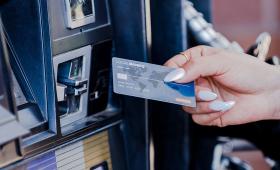
Finance
For some people, the idea of using a credit card is downright frightening.
It’s not uncommon to be afraid of credit. After all, you may have heard horror stories about people who rack up debt at high interest rates.
But a credit card can be a valuable financial tool if you stick to a few best practices. Before your next purchase with plastic, learn how to make the most of a credit card without running into a scary scenario.
- Open your first credit card account early.
It may seem counterintuitive, but the sooner you get a credit card, the better—as early as your teen years.
In general, the minimum age to open a credit card is 18 years old. Many experts say that’s exactly when you should open your first account. Starting an account early allows you to begin establishing good credit from a young age. This can be useful later in life when good credit can help you rent an apartment or take out a loan for a car or home purchase.
Some credit cards for young adults and first-time cardholders offer built-in protections. Look for cards with low credit limits, for example, which can help you avoid the temptation to spend more than you can afford.
- Pay bills on time.
One of the most important factors in establishing a strong credit score is the practice of paying bills on time. By paying at least the minimum balance on your credit card every month, you’ll stay on track—but if you can, it’s best to pay the full balance. More on that below.
- Strive to pay off your balance each month.
When you receive a credit card statement at the end of the month, you’ll see a minimum payment due. In some cases, the minimum is less than your entire balance.
But if you only pay the minimum and you don’t pay the full balance each month, you could end up owing interest or fees in the future. In some cases, this can lead to snowballing debt that becomes hard to manage.
Instead of paying the minimum, aim to pay off your entire credit card balance. That way, you’ll stay on track and avoid accruing debt. You can even make credit card payments early for extra peace of mind.
- Treat your credit card like a debit card.
For some people, it helps to think of a credit card like a debit card.
Would you ever use your debit card to buy something that costs more than you currently have in your account? The answer is no (at least not on purpose)!
Before you make a purchase with credit, ask yourself if you would be able to afford that purchase today with your debit card. While credit cards provide some advantages that debit cards don’t provide, you want to avoid using credit to make purchases you can’t truly afford to pay back.
If you’re in the market for a credit card, WaterStone Bank has a multitude of options to fit your needs. Check out the options via wsbonline.com, or contact our Customer Support Center at 414.761.1000.
 3 minutes read
3 minutes read
Finance
Whether you’re an adventurous foodie or you prefer a menu of comfort food, dining out can be a delicious way to spend time with loved ones or celebrate an occasion. Eating in restaurants can also get expensive if you don’t keep the habit in check.
Fortunately, you don’t have to forego your favorite restaurants when you’re on a budget. Try a few of these tips to save money the next time you dine out.
- Join loyalty programs.
From fast food chains to local mom-and-pop spots, many restaurants offer punch cards and points programs to reward customers for their loyalty. If you’re a regular at your favorite coffee shop or restaurant, ask if they offer a loyalty program. Over time, your patronage could translate into freebies and discounts.
Bonus tip: Some restaurants offer free desserts (or even free meals) for birthdays. You can check online or call ahead to inquire about birthday deals at your favorite spot.
- Stop in for specials.
It pays to take advantage of restaurant specials, and you’re more likely to find them during off-peak hours.
Dining out on a weeknight or during happy hour can be one of the best ways to find deals and specials that save you money. Even fine-dining restaurants may offer weekday specials that make a splurge destination into an affordable night out. Happy hours can provide steep discounts on adult beverages that tend to lead to high restaurant bills—more on that below.
To find specials, check your favorite restaurants’ websites or social media profiles or call ahead.
- See if you’re eligible for discounts.
Keep your eyes peeled for savings available to various groups: Senior discounts, teacher discounts, veteran discounts, kids eat free, and so on.
Many restaurants also offer discounts and specials on national days. National Cheese Curd Day, for example, falls on Oct. 15.
- Choose your beverages wisely.
One of the easiest ways to save money on your restaurant bill is to sip tap water instead of alcohol, soda or novelty drinks. The markup on beverages can quickly add up, especially if you’re dining in a group. Tap water is free, and it’s never a bad idea to stay hydrated.
- Don’t skimp on the tip.
If you’re dining at a sit-down restaurant, expect to tip a minimum of 15 percent of the pre-tax total, according to the Emily Post Institute. Skipping the tip is not a viable way to save a few bucks—it only takes wages out of your server’s pocket.
 2 minutes read
2 minutes read
Finance
The holiday shopping season is in full swing, and Black Friday—the Friday after Thanksgiving—remains one of the most anticipated shopping holidays of the year.
But is it worth the hype?
The answer depends. Here are a few tips for navigating the Black Friday shopping rush, whether you’re browsing in-store or online.
- Don’t wait until Black Friday to score deals.
Many stores begin offering their best prices of the year on Thanksgiving Day; others start even earlier in October. You can also look ahead at which deals are coming by searching online in advance. Planning ahead can take the guesswork out of holiday shopping and help you stay within your budget.
Related article: Best tips for getting a jump start on holiday shopping
- Skip the store for most deals.
Unless you cherish the ritual of waking up early and waiting in line at the store, you no longer need to stand in the cold to snag the best Black Friday discounts.
With the exception of some special doorbusters that might require an in-person purchase, nearly all Black Friday deals are available online. By shopping online, you also avoid the headache of arriving to the store to discover that your must-have items are sold out.
- Look into price matching.
More retailers than ever have adopted price-matching policies to keep customers from shopping with competitors for better prices.
If you’re nervous about making a big-ticket purchase—after all, the price might go down on Cyber Monday—check out the store’s price match policy. Target, for example, offers price adjustments if an item you purchase after Oct. 6, 2022 goes on sale for a lower price before Dec. 24, 2022.
Many retailers also share lists of competitors whose prices they are willing to match if you find a better deal at another store.
- Buy now or wait until Cyber Monday?
Cyber Monday arrives a few days after Black Friday with the promise of deep discounts. So should you sit tight and wait until Monday for lower prices?
Probably not. Black Friday and Cyber Monday deals tend to be about the same, although experts point out that Cyber Monday can sometimes come with better deals on clothing.
If you do purchase an item earlier in the season and you find a lower price on Cyber Monday, see if the retailer will offer a price adjustment.
 2 minutes read
2 minutes read
Finance
Whether you wait until December to hum along to “Winter Wonderland” or you start playing holiday tunes in October, one thing is for certain: The holiday season is approaching quickly. Do you have a plan for this year’s holiday shopping?
Finding gifts for everyone on your list can feel like a full-time job—and an expensive one, too. Here are a few tips to get an early jump on holiday shopping and find deals in the process.
- Look ahead at Black Friday and Cyber Monday deals.
Study up on this year’s deals before Black Friday and Cyber Monday arrive. From there, you’ll know which discounts to wait for and which gifts to buy sooner.
Many retailers publicize their deals weeks (and even months) in advance. A quick search for Black Friday discounts brings up several lists compiling bargains from both online and brick-and-mortar retailers. Just remember: While Black Friday and Cyber Monday can bring steep discounts on some items, other goods—like clothing and furniture—might not be such a bargain.
If you’re worried about overspending, remember to stay focused on the gifts you need to pick up. If you have a wandering eye, avoid browsing online or shopping in-store without a list. Mega sales can be tempting if you struggle with impulse spending.
Related article: Holiday Budget Ideas
- Use online tools to score deals.
Leave no coupon code unturned, and don’t forget to check your email to find extra opportunities to save money.
Around the holidays, retailers offer a dizzying number of coupons and codes for online savings. You can usually find these in your inbox if you subscribe to updates from your favorite stores.
If you’re shopping online, use third-party price trackers and shopping apps to make sure you’re getting the lowest price and taking advantage of every available discount. Some apps even apply coupons for you, which can save you time scouring your inbox for codes.
- Place gift orders ASAP.
Over the last few years, supply chain disruptions and shipping delays have created headaches for many holiday shoppers. If you want to be sure to receive gifts before the end of December, don’t wait too long to place your orders. Experts say the 2022 holiday season is already shaping up to be another hectic year for the shipping industry.
If you do wait too long to place an order, visit the store in-person to pick up a gift for a time-sensitive gift exchange—or opt for a gift card for a gift that won’t get bogged down in shipping delays.
 3 minutes read
3 minutes read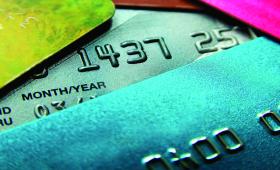
Security
A debit card can be an excellent tool in your wallet. It’s easier than writing a check and safer than carrying cash. Plus, a debit card can provide some accountability if credit cards make unnecessary shopping too tempting—with debit, you can only spend the money you have.
But using a debit card can also present some risks. In 2020, debit card users in the U.S. lost a total of $117 million to fraud.
Wondering how to avoid debit card fraud? Follow these tips to protect yourself the next time you swipe your debit card.
- Safeguard your account information.
One of the best ways to prevent debit card fraud is to be careful with your account information. That includes keeping your account number and PIN private. Avoid using an obvious PIN that’s easy to guess, like your birthday. And don’t keep your PIN number written down in your wallet.
You can also see if your debit account offers multi-factor authentication, which adds extra layers of security to prevent unauthorized users from accessing your account details and making purchases. The Federal Trade Commission also recommends cutting up old cards and safely disposing of old account statements and ATM receipts.
- Use a credit card for online purchases.
Most experts agree that credit cards are a safer bet than debit cards for online shopping. If fraud does occur on a credit card, it can be easier to zero fraud liability, which means you won’t be on the hook for paying back any fraudulent charges.
- Cancel and report lost cards.
If you lose your wallet, don’t delay canceling your debit card and reporting it missing to your bank. The sooner you report a card lost or stolen, the better: Your maximum losses increase the longer you take to report a missing card.
For example, if you report a card missing within 48 hours of noticing unusual charges, your maximum liability is only $50, per FTC guidelines. That maximum increases to $500 if you wait more than two business days but less than 60 calendar days to report a stolen card.
- Beware of ATM “skimming.”
Skimming is a technique that criminals use to record bank account data from a shopper’s debit or credit card. To prevent a skimming scam, the FBI suggests avoiding card readers and payment terminals that look crooked, damaged or unusual in any way.
Skimming is mostly used to steal data from cards with magnetic strips; a card with chip technology is less vulnerable to skimming, according to the FBI.
- Act quickly after you notice unusual charges.
Unfortunately, debit card fraud can still occur even if you’re vigilant about keeping your account information safe. If you notice any unusual or fraudulent activity on your account, reach out to your bank ASAP to cancel your card and begin next steps to recover your losses.
And don’t forget about the power of the SecureLOCK Equip app, you can ensure your WaterStone Bank Debit Card never gets used without your knowledge. Turn it off or on whenever you want and set the card to only work where you are. You can set a limit on the transaction amounts and receive instant alerts every time your card is used. Get complete and total control over your Debit Card by downloading the free SecureLOCK Equip app today!
 3 minutes read
3 minutes read
Finance
Airfare can be a major drain on your wallet, especially if you’re traveling around the holidays with the family in tow.
Even as fuel prices surge and it becomes more expensive to fly, there are ways to save. Here are a few tips to help you find affordable airfare as you start planning your winter getaway.
- Set price alerts for specific flights.
Flight prices can be unpredictable. The same flight pattern might cost $200 more if you book your return on a Saturday rather than a Friday.
That variability can be mind-boggling. But instead of constantly checking prices for your desired flights, try using online tools that search across multiple airlines for the best deals.
Set price alerts with a flight price tracker like Google Flights, Kayak, or another search engine. Price alerts allow you to monitor prices for flights on specific dates. You can also set alerts for flexible dates to receive notifications whenever flights to your desired destination are cheaper than usual.
Keep in mind that flights from Southwest Airlines, a popular airline with travelers on a budget, don’t appear in flight search engines such as Google Flights. You will need to check directly on Southwest’s website to find the best deals for your dates and destinations.
- Use online services to watch for deals in advance.
If your travel dates or destinations are flexible, you can subscribe to services that scour the internet for the cheapest airfare. Subscriptions like Scott’s Cheap Flights and Dollar Flight Club send email alerts any time a hot flight deal becomes available from your home airport.
Many of these services charge a subscription fee; some offer a free version that provides fewer features and deals.
Before you purchase an airfare subscription, shop around to compare features and decide if it’s worth the premium price tag. If you travel often, the cost of a yearly subscription could be worth it if it helps you save hundreds of dollars on airfare. If you’re only planning a single, domestic flight, you might not get as much value from a paid airfare deal subscription.
- Be flexible.
Flexibility pays when it comes to booking affordable airfare—especially around the holidays. If you’re willing to travel on the holiday (for example, booking a flight on Thanksgiving Day), you’ll likely find cheaper airfare than you will on the days immediately before or after.
If your schedule allows, you can also sometimes save by booking last-minute flights. You can also potentially save money by flying out of a different airport—for example, booking flights out of Chicago or Madison instead of Milwaukee. Just remember to factor in the cost of transportation if you decide to book from a different airport.
If your travel destination requires the use of foreign currency*, make WaterStone Bank your one stop shop. Visit our Franklin/Hales Corners, Oak Creek/27th Street, Wauwatosa/State Street, or Waukesha branches to take advantage of this service. Best of all, we’ll accept exchanges of unused foreign currency for United States dollars. Contact Customer Service at 414.761.1000 (toll-free at 888.686.7272) for more information and to learn about the 50-plus currencies we offer for exchange.
*WaterStone Bank (WSB) offers foreign currency exchange services of more than 50 currencies at five WSB locations: Franklin/Hales Corners, Oak Creek/27th Street, Wauwatosa/State Street, Germantown/Menonomee Falls, and Waukesha. Fees will be waived for Student, MVP and HERO program customers up to two times annually. The currency exchange rate used at WSB may differ than the daily rate of exchange and are subject to daily fluctuations. A $20.00 fee is assessed for orders and return orders; fee is subject to change at any time. Currency orders placed and not picked up within 10 business days are subject to a return fee and any depreciation. Please see a WSB banker for more details.
 3 minutes read
3 minutes read
Finance
For years, retirement may have seemed like a faraway milestone. But if you’re looking toward retirement in the next several years, now is a good time to make sure you’re on track financially before arriving at the next chapter in life.
Ready to get your finances in order before your golden years? Here are a few key steps to take.
- Get a snapshot of your overall financial picture.
When retirement is a distant dream, many people take a set-it-and-forget-it approach to saving. Some people max out their IRAs each year like clockwork; others make automatic payroll deductions to an employer-sponsored retirement savings plan. But now that retirement is close, it’s time to take your savings strategy off the backburner. Before long, you will likely begin dipping into the funds you’ve set aside.
Assess your financial position with online tools like WaterStone Bank’s Retirement Planner Calculator. This calculator can help you determine how long your savings will last into retirement while taking many factors into account, such as pay increases, the rate of return on your investments and the rate of inflation.
Other tools, like the Retirement Income Calculator, can help you visualize what your lump retirement savings will look like when split into monthly payments.
Explore the rest of WaterStone Bank’s financial calculators to start looking at how your savings stack up against your needs in the future.
- Optimize your investments.
If you’re used to making high-risk, high-reward investments with your retirement savings, now may be the time to shift to a more conservative strategy—think low-risk bonds and high-yield savings accounts instead of hedge funds and crypto.
Also, take note: If you’ve invested any of your retirement savings in target-date funds, those investments will automatically begin to shift toward a more conservative strategy as you get closer to retirement age.
As retirement nears, it’s important to protect the money you’ve saved and the interest you’ve earned over the years. A financial professional can help ensure your investment strategy is appropriate for your stage in life.
- Bolster your nest egg.
Consider contributing as much as you can to your retirement accounts, then start thinking outside the box about other ways to save.
One way to save more is by making catch-up contributions to your 401(k) plan after you reach age 50. Not all plans allow catch-up contributions, so ask a plan administrator for details about your plan’s rules.
If you aren’t already contributing to an IRA, now could also be a good time to open one, if you qualify. You can also look beyond retirement accounts into other retirement savings options, like traditional brokerage accounts, Health Savings Accounts and high-yield savings accounts. Every little bit you save can provide peace of mind and security when you’re ready to retire.
- Work with a financial professional.
Preparing for retirement is no small feat. But when it comes to managing your money, an investment professional can help. Reach out to the team at WaterStone Investment Services for one-on-one guidance to make sure you’re situated for a secure future in the years to come.
 3 minutes read
3 minutes read
Finance
After years of teaching your children the value of a dollar, the teenage years offer a unique opportunity for kids to put financial concepts into practice.
High school is an excellent time for kids to get to know banking products and learn the basics about credit. A strong understanding of key financial ideas can help set your child up for success later in life.
Looking for ways to cultivate financial responsibility in your teen? Here are a few tips to help you get started.
- Encourage teens to open a checking account.
Before your teen clocks in at their first job, make sure they have a checking account where they can safely deposit and manage their earnings.
Some checking accounts offer features specifically for teens, like WaterStone Bank’s Student Checking Account. This type of account empowers your child to get comfortable with digital banking. Using a debit card also helps teach financial responsibility as kids learn that swiping plastic doesn’t mean “free money.”
Plus, student-tailored accounts can offer peace of mind for parents with safety features like overdraft protection and ATM fee reimbursement.
- Learn about loans.
If your teen will be applying to colleges, help them understand what it means to take out student loans.
Review the differences between private and federal student loans, and use online loan repayment calculators to help bring the numbers to life. Let teens see how much their monthly payments could be for different amounts of loans.
Then, help your child put those numbers into context: How does a monthly loan payment compare to a car payment, for example? How much might they expect to spend on rent? How could taking student loans today impact their finances later in life?
Related article: Financial Lessons for Teens and College
- Give teens confidence with credit.
Many teens—and adults!—are fearful of credit cards. But credit is a powerful tool when used responsibly.
Consider encouraging your teen to open a credit card with a low limit. Explain that a credit card doesn’t offer “free money”—instead, they should plan to pay off their credit card bill in full each month to avoid accruing interest.
Look for a student-focused credit card that offers perks or cash back. And remember, you might need to open the account with your child, since they don’t have a credit history of their own. This also creates an opportunity to impart on the importance of building a good credit score and credit history from an early age.
 3 minutes read
3 minutes read
Finance
If you don’t keep up with financial news, you may not pay much attention to the federal funds rate. But changes to the Federal Reserve’s interest rate can have a big impact on your daily life and budget.
But first: What is the federal interest rate?
The Federal Reserve—known as the Fed—is the central bank of the United States. The Fed is responsible for setting policies to support the U.S. economy and overseeing the country’s banks and financial institutions.
The Fed also sets the rate at which banks borrow and loan money. When this rate fluctuates, it can impact rates for consumers on all kinds of financial products, from savings accounts to stocks.
Here are some ways the latest increase in the federal funds rate might impact you.
Loan interest rates
If you finance a big-ticket purchase, the interest on your loan can add up quickly. And as the Fed has increased interest rates in 2022, mortgage lenders have followed suit: Interest rates on mortgages are steadily rising.
A few percentage points may not sound like a lot, but if you take out a mortgage at the median home price in Milwaukee (around $195,000 in August 2022), a 30-year mortgage with a 6 percent fixed rate will cost about $1,169 per month; that’s compared to $822 a month for a mortgage with an interest rate of 3 percent.
The Fed’s rate increase is also affecting other types of loans, including auto loans and private student loans, which means you may see higher interest rates on those and other loans.
Interest on personal bank accounts
Although the cost to borrow money tends to increase as the Fed raises rates, there is one silver lining: You’re likely to earn more interest on your savings.
That boost can be good news as you earn a higher interest rate on the money in your savings or checking accounts. You’re also likely to enjoy higher interest rates on high-yield savings accounts and certificates of deposit (CDs).
Credit card interest
A higher federal interest rate generally means a higher APR on your credit card, which could hurt if you aren’t paying your balance in full each month. Be sure to pay credit card bills on time to avoid racking up extra interest payments.
Related article: Best Practices When it Comes to Paying Off Credit Card Debt
Stock investments
As the Fed increases interest rates, stock prices across many sectors tend to decrease, which means your investments may take a hit. But this isn’t true across the board: Higher interest rates can sometimes boost stock values in some sectors and businesses.
The final word on the Fed’s rates
Financial institutions and markets respond in different ways to changes in the federal interest rate. If you’re unsure about your best options right now for loans, savings accounts or other financial products, work with a WaterStone Bank personal banker or a trusted financial professional. Schedule an appointment online today. We’re here just for you!
 4 minutes read
4 minutes read
Finance
Maybe you dream of saving enough money to afford a down payment on a house. Maybe you’re working towards paying off your credit card debt. Or perhaps you hope to send your child to college one day and help them avoid taking out lots of loans.
Whether your goal is to save for a bucket-list vacation or a comfortable retirement, following through on your financial dreams requires motivation and discipline. Here are four ways to stay driven and avoid losing steam as you work toward achieving your dreams.
- Break big goals into small steps.
If you’re only looking ahead to your biggest and most ambitious goals, it’s easy to start feeling discouraged. Instead of getting lost in the big picture, try reframing a large goal by breaking it into smaller, short-term steps that are achievable.
The satisfaction of achieving small wins can provide a critical mental boost that keeps you motivated and working toward your bigger goal. For example, if you’re saving for a down payment, you might be aiming to set aside a large amount—say $10,000—in a defined amount of time.
Try breaking that goal into smaller monthly or weekly savings targets. That could be $20 a week, $2,000 a month, or anything in between.
As you reach small goals on the way to larger goals, you’ll feel a sense of pride in your accomplishments as you go.
- Schedule a financial review.
Don’t let the word “review” intimidate you—checking in regularly with your goals and your accounts is an important step that can help you reach your goals.
Whether you perform an annual check-up with a trusted financial advisor or a quarterly check-in with yourself, scheduling a routine review of your finances will help you evaluate your wins, your shortcomings and your opportunities. A review can motivate you to stay on track, and it provides an opportunity to reassess your goals and make sure they still align with your dreams and values.
- Revisit your “why.”
It can be tough to save toward your financial goals, especially if it requires passing up other opportunities—as you save toward a family vacation, for example, you may have to forego a few weekend getaways.
In moments when you’re feeling discouraged, re-focus on the “why” behind your goals. This could mean looking at pictures of your dream vacation destination to remind yourself what you’re saving towards, or it could be reminding yourself that once you’ve paid off your debt, you’ll have space in your budget for saving and activities you enjoy.
- Celebrate your wins along the way.
Reaching your financial goals takes hard work and perseverance, and that’s worth celebrating. Don’t forget to pause and acknowledge your achievements on the way to reaching your goals, whether that means simply recognizing that you’re making progress or dipping into your “fun money” budget for a celebratory treat.
 3 minutes read
3 minutes read
Finance
Impulse spending used to require taking a trip to the store. But these days, it’s not just display windows or the Target dollar section that have us opening our wallets to buy items we never knew we needed—it’s also ads on Instagram, emails from retailers and the lure of Amazon.
Impulse spending every once and a while might not hurt your budget, but over time, the habit can become expensive. Here are a few tips to help keep impulse spending in check.
1. Sleep on it before you buy.
If you’re prone to late-night scrolling, you might also be in the habit of late-night spending. Instead of following your whim any time you want to make a purchase, follow a simple rule: Wait until the next day. A little bit of time and space can help you think more clearly if the item is a want or a need.
2. Create barriers to online ordering.
If your credit card information is saved on all your favorite store websites and your phone is full of shopping apps, it can be easy to make mindless purchases. Make it more challenging to shop online by deleting your saved payment info and shopping apps.
When you need to take extra steps to complete a purchase, you’re more likely to pause and consider whether you really need something or if it’s just an impulse buy.
You can also try limiting discretionary purchases to cash-only: Research shows that people spend less when they pay with cash.
3. Get strategic with your shopping.
Another way to tame a wandering eye while shopping online is to search for the specific item you need instead of browsing by category; this can help you avoid the temptation of online window shopping. One study found that shoppers who browse by category instead of searching for a specific item are more likely to get derailed and spend more.
When you head to an in-person store, stick to a list—don’t add any items to the cart unless they’re already on the list.
4. Watch for signs of compulsive spending.
Many people indulge in the occasional impulse purchase without experiencing any lasting harm. But if your spending feels out of control and causes issues in your life, you could be struggling with compulsive buying behavior. A mental health professional can help get to the root of your spending habits and develop strategies and coping mechanisms to work through urges to shop.
 2 minutes read
2 minutes read
Finance
These days, the average cost of a weeklong vacation for just one person hovers around $1,500—and the price only goes up for larger families.
But summer vacation doesn’t have to come with a high price tag. There are countless ways to savor the season without stressing over the cost. Here are a few ideas for low-cost, high-impact summer fun.
1. Staycation.
With gas prices reaching record highs, you might be putting your summer road trip plans on hold. To save money, stay closer to home and plan a staycation instead—there’s an abundance of culture and nature to explore in Milwaukee and in the suburbs, or get a bit further out of town with a day trip to a Wisconsin state park. It’s never too late to discover a new destination right in your neighborhood.
2. Backyard camping.
Camping is an option for an affordable getaway, but you don’t even need to book a campsite or hop in the car to sleep under the stars. Set up a tent in your backyard, throw some wood into a firepit, try a campfire recipe and then roast gooey smores for dessert. Enjoy your meal by lantern light for the full effect. (No judgment if you sneak back inside at bedtime!)
3. Local festivals and concerts.
Southeast Wisconsin comes alive in the summer with a plethora of festivals and outdoor events. Pack a picnic for a free concert at a park or walk through one of many neighborhood makers markets or block parties.
In addition to free events, some events that charge admission—like Summerfest—run promotions and discounts that make it possible to attend on a budget, even with the whole family in tow.
4. DIY waterpark.
Set up the slip ‘n slide, turn on the sprinkler and fill up the water balloons to convert your backyard into a waterpark oasis without paying waterpark prices. For a more elaborate project, create a DIY splash pad and get creative with household items to turn your home into a destination for summer fun.
5. Think outside the box.
If you’re still stumped on how to have low-cost fun this summer, look to the internet for long lists of ideas to stoke your imagination, from date night inspiration to kid-friendly entertainment. Planning a summer filled with fun, affordable activities can be as simple as taking a hike on a new-to-you trail or spending a rainy day rediscovering the local library.
 2 minutes read
2 minutes read
Finance
Wedding season is upon us, which means it's time to celebrate - and time to brush up on the etiquette for gift-giving. Before you show up to the ceremony, here's what you need to know about wedding gift-giving at any price point.
1. Set your budget.
You may have heard different guidelines about how much to give at a wedding, like giving a gift equal in value to what you estimate the couple spent per person. While these rules of thumb can provide general guidelines, they aren’t hard-and-fast rules. Instead, it’s better to look closely at your budget to determine what you can comfortably afford and what you want to spend.
You may also spend more on some wedding gifts than others; for example, you might splurge on a large gift for a close friend but spend less on a gift for a coworker. When in doubt, the Emily Post Institute suggests letting your affection for the couple guide your budget.
2. Gift from the registry? Gift card? Cash?
Buying a gift off the couple’s registry is a surefire way to know you’re giving them exactly what they want. Registries also offer convenience: In many cases, you can purchase gifts online and they’ll be shipped directly to the couple’s home.
But just because the couple has a registry doesn’t mean you have to use it. It’s perfectly acceptable to give cash as a wedding gift, or a gift card, such as one of the retailers on the registry or a prepaid option like the WaterStone Bank Visa® Gift Card.*
3. Send your gift on time.
Don’t wait too long to give a wedding gift. The Knot suggests sending your gift no later than two months after the wedding—but sooner is better. Plus, with the prevalence of online gift registries, it’s easier than ever to send a hassle-free gift.
No need to lug a food processor or duvet cover to the reception hall. Simply buy your gift off the registry and ship it straight to the couple.
4. Give from the heart.
If you’re on a strict budget, don’t stretch yourself thin to afford a wedding gift. There are other ways to show your love and appreciation for the couple without breaking the bank.
Consider chipping in on a group gift with friends or purchasing something small off the couple’s registry. If money is extra tight, simply writing a heartfelt card can be the perfect gift. Ultimately, it’s the gesture that counts—not the amount you spend.
*USE DOMESTICALLY EVERYWHERE VISA® DEBIT CARDS ARE ACCEPTED
WaterStone Bank Visa Gift Cards are issued by Pathward®, N.A., Member FDIC, pursuant to a license from Visa U.S.A. Inc. No cash access.
 3 minutes read
3 minutes read
Finance
It’s normal for the cost of living to creep up a little bit each year, but when prices start to surge more dramatically, that’s a telltale sign of inflation—and in 2022, inflation is costing the average U.S. household nearly $300 extra each month. You might be feeling the pinch at the gas pump, the grocery store or even your favorite online retailers.
Although the forces behind inflation can be complicated, there are some simple ways you can minimize the effect of inflation on your budget. Here are a few tips to help you weather rising prices.
1. Cancel unused subscriptions.
It’s easy to find yourself paying for countless subscription streaming or delivery services, but how many do you use on a regular basis? Cleaning up your subscriptions is a quick way to free up extra wiggle room in your monthly budget and find savings as prices rise elsewhere.
2. Consider inflation-linked investments
Treasury Inflation-Protected Securities—or TIPS for short—can be a worthwhile investment for some people, especially during times of inflation.
The value of these securities goes up as inflation rises and decreases with deflation. The terms on TIPS range from 5 to 30 years, and the minimum purchase is only $100, making this an accessible form of investment.
I bonds are another type of investment with interest rates linked to the rate of inflation, which makes them attractive to investors looking for ways to hedge against inflation.
3. Shop smarter online and in-store.
As food prices rise, you can save money by taking the time to comparison shop and track down coupons (either paper or digital) before you head to the store for groceries and everyday necessities.
Larger purchases are also becoming more expensive: The cost of major appliances and other electronics has jumped in the past year, so it pays to bargain hunt before you buy.
For online purchases, you can subscribe to emails from your favorite retailers to stay up-to-date on sales and promotions; consider using shopping apps that help you find the best deal before you order online.
4. Get strategic with investments.
Now might be a good time to hedge against inflation by investing strategically in areas like real estate or commodities. Just remember that no investment offers guaranteed gains—there’s always a risk of loss.
 2 minutes read
2 minutes read
Finance
The cost of gas is always fluctuating, which means you never know when you might see a price increase for your commute, your weekend road trips or your daily errands.
But even as gas prices surge this spring, there are plenty of easy ways to save money on gas. Here are some of the simplest tricks to help you spend less at the pump.
1. Consolidate your trips and errands.
Be purposeful when driving to errands. Is there a grocery store along your route to work? Can you run to the post office on the way to pick up your kids from school instead of making a separate trip?
Plan your errands in advance and avoid last-minute dashes to the store as much as possible. Over time, your efficiency will translate into savings on gas (and will add fewer miles to your odometer).
2. Use apps to find the best deals near you.
Smartphone apps like Gas Buddy make it easy to find the lowest prices at the pump. Many apps allow you to plug in your zip code or search for gas deals en route to your destination, which can help you avoid overpaying for gas. Some apps even let you earn cash back on gas in the form of gift cards or discounts on future purchases.
3. Take advantage of gas points and loyalty programs.
If you stick to certain gas chains, you can save money with loyalty programs. These free programs reward you each time you fill up, and you can join multiple programs if you like to switch around between different chains. When you sign up for a rewards account, take a look at the program details—you may be eligible for other perks like rental car discounts and extra savings for military members.
Some grocery chains, including Kroger and other national and regional stores, also offer gas reward programs.
4. Consider walking, biking or public transit.
Driving might be inevitable when you’re going long distances or facing frigid Wisconsin weather, but you may be surprised how easy it is to opt for other methods of transportation for day-to-day needs.
If you live in a city with public transit, look into the bus or train routes to map out convenient alternatives to driving. Consider walking to the store instead of driving, if you can, or try biking to work to enjoy a little exercise and fresh air on your commute.
5. Plan a staycation instead of a road trip.
You don’t need to drive far to conquer cabin fever. Skip the road trip vacation this year and find fun in your own backyard. Book a reservation at a restaurant you’ve always wanted to try in your hometown or take the kids to a museum they’ve never visited—with the money you save on gas, you’ll be able to splurge a little on your staycation.
 2 minutes read
2 minutes read
Finance
If you’re expecting a tax refund this year, you might be dreaming of all the ways you can use the extra cash—but don’t be too quick to spend your return. After all, your tax refund isn’t just free money: It’s money you overpaid the government during the previous tax year.
Here are some of the best ways to “spend” your tax return. (Spoiler alert: You may not want to spend it at all!)
1.Pay off high-interest debt.
If you have credit card debt, student loans or unpaid medical bills, consider using your tax refund to pay down your debts. Start with the debts that carry the highest interest rate. That way, you’ll spend less on interest over time.
2. Put extra money away in a retirement account.
In addition to the contributions you make to an employer-sponsored retirement plan, you can also open an Individual Retirement Account (IRA) to save more toward your future.
Even if retirement is decades away, now is the time to plan: The more you save for retirement today, the more your investment will grow so that you have a healthy nest egg later on. When this year’s tax return arrives, set the money aside in a traditional or Roth IRA.
3. Contribute to your child’s 529 plan.
Use your tax refund to save for your child’s education by making a tax-deductible contribution to their 529 college savings account. If you haven’t started an account yet, it only takes a few minutes to open one online. In Wisconsin, you can open a 529 savings plan through Edvest or Tomorrow’s Scholar.
4. Top off your emergency fund.
The average American has about $5,000 in emergency savings, which may not be enough to cover even a month of expenses, depending on your lifestyle and family size. If your emergency savings account could use a boost, set aside your tax refund to save for a rainy day.
5. Indulge in a smart splurge.
Some people plan each year to use their tax returns toward a family vacation, a down payment on a new vehicle or another big-ticket purchase. “Fun money” is an important component of your overall financial health, so if your debt is manageable and your retirement savings are maxed out, it might make sense to use your return to treat yourself this year.
 3 minutes read
3 minutes read
Finance
Hoping for a big tax refund this year? Not so fast—a large refund isn’t necessarily a good thing. In fact, for many people, a smaller refund is preferable to a massive check from the government.
Here’s what you need to know about tax refunds and why bigger isn’t always better.
What determines the amount of my tax return?
When you receive a tax refund, you’re getting paid back for money you overpaid the government from your earnings during the previous year. If you owe money after filing your tax return, that means you underpaid the government.
If you’re employed full-time, you fill out a W-4 form that’s used to determine how much money will be withheld from each of your paychecks for tax payments. If you’re self-employed, you pay your estimated taxes each quarter.
When you don’t withhold enough on your W-4 form—for example, if you don’t claim all of your tax dependents—you’ll end up paying more than you actually owe toward your taxes.
Why wouldn’t I want a big tax refund?
If you routinely receive a fat refund check after filing your taxes, it means you’re overpaying on your taxes throughout the year. While your refund might seem like a nice windfall come February or March, it’s ultimately money you could be keeping in your pocket all year long, rather than receiving it later on in the form of a tax refund.
In most cases, a big refund indicates you aren’t taking all of the withholdings and tax deductions you’re eligible for. You can fix this by adjusting your tax withholdings with your employer. It’s also a good idea to adjust your withholdings after some major life changes, like getting married or divorced, having a child or taking on a second job.
How do I update my tax withholding?
Fill out a new W-4 form to submit to your employer. When in doubt, your employer’s human resources department can point you in the right direction.
If you’re self-employed, review the IRS’s guidelines for calculating your estimated quarterly tax payments to make sure that you’re taking all of your eligible deductions.
 3 minutes read
3 minutes read
Finance
By the time spring break rolls around, many of us in Wisconsin are ready for a reprieve from the Midwest winter. Fortunately, there are plenty of ways to plan a spring break escape on a budget, and some options don’t even require booking a plane ticket.
Here are a few tips for planning your affordable spring break trip.
1. Avoid traveling to popular destinations during peak times.
Many spring breakers have the same idea: Beeline to the beach in late March. But if you’re flexible on timing and open to a unique destination, you could save money.
Look into destinations beyond the beach that may offer more affordable accommodations and flights. For far-away destinations, do your research to determine the best time to score a deal on flights—some experts swear by last-minute deals, while others emphasize the importance of tracking flight prices well in advance to jump on early savings.
2. Weigh the pros and cons of all-inclusive resorts.
All-inclusive resorts can be an attractive option for frugal travelers. By paying up-front for all your food, drinks and on-site entertainment, you never have to worry about a surprise bill throwing a wrench in your vacation budget.
On the other hand, an all-inclusive may not be worth it if you don’t think you’ll take full advantage of everything the resort has to offer; maybe you’re planning a lot of excursions away from the property, or you’re not much of a drinker. Look closely at the price differences and consider your travel priorities to determine whether an all-inclusive resort makes sense for your budget and your travel preferences.
3. Plan a getaway closer to home.
Maybe a warm-climate destination isn’t feasible this year for logistical or financial reasons. But that doesn’t mean you have to stay stuck at home. Many indoor waterparks across the state and the region offer a drivable destination where your family can enjoy a taste of summer fun without requiring a long-haul flight.
Watch for deals and promotions that might be available for reservations made during the week (rather than weekends), deals for early booking or last-minute deals. You can also opt for a daytrip to a nearby destination to avoid paying for an overnight stay.
 2 minutes read
2 minutes read
Finance
Cold midwestern winters almost always mean higher home energy bills. If you’re looking for a few ways to save money this season—and throughout the rest of the year—here are a few tips to help keep your energy use in check.
1. Change your heating habits.
Did you know that your furnace is responsible for nearly one-third of the energy used in your home? A few changes to your heating routine can go a long way in helping you save money this season.
Heating tips from We Energies include:
- Install a programmable thermostat so that you can easily control the temperature in your home and avoid running the heat when you don’t need it.
- >Install weatherstripping in your windows and doors to cut back on draftiness and prevent cold air from leaking indoors.
- Regularly change your air filter to keep your furnace running efficiently.
2. Use appliances wisely.
From your refrigerator to your washing machine, all of your large appliances use a lot of energy. Luckily, there are quick changes you can make around the house to reduce the cost on running your major appliances.
Switch to washing clothes in cold water, let dishes and laundry air dry instead of running the heat setting or using the dryer on every load, and make easy changes like unplugging old, unused refrigerators in the garage or basement to instantly start saving money.
3. Switch to energy-efficient lighting.
Changing out your lightbulbs is an easy task that could save you more than $200 a year, according to the Office of Energy Efficiency & Renewable Energy.
The key is to opt for LED bulbs with ENERGY STAR certification instead of incandescent bulbs. LED bulbs not only use less energy, but they also last much longer than traditional bulbs, which means you won’t need to change the lights in your lamps and light fixtures as often.
4. Upgrade to an energy-efficient water heater.
It costs an average of $400 to $600 to run your water heater each year. If you’re in the market for a new water heater, consider purchasing a more efficient unit that can help you save money on your monthly energy bill.
 2 minutes read
2 minutes read
Finance
Roses, chocolates and a dinner reservation for two might be the traditional ways to celebrate Valentine’s Day, but they aren’t the only ways.
If you’re aiming to plan a budget-conscious celebration this year, here are a few ways to spark romance on Valentine’s Day without breaking the bank.
1. Skip the restaurant and plan a meal at home.
Many restaurants offer special prix fixe menus on Valentine’s Day, and these menus often come at a special—and steep—price point.
Instead of making a reservation, turn to your favorite recipe books and food blogs to come up with your own menu for an indulgent meal at home. You can still splurge on a higher-end cut of protein if you like—it will cost less to cook at home than what you would pay at a restaurant.
If you and your partner both love to cook (or if you’re both equally uneasy in the kitchen), making dinner together can be a romantic team effort. Or you can offer to handle the culinary heavy lifting and cook for your partner.
Make the occasion feel a little more special without spending extra by using the special occasion dishes and glasses that are usually reserved for guests—or embrace the casual date night and enjoy dinner together on the couch (pajamas optional).
2. Rethink the roses.
It’s not your imagination: Florists tend to increase the price of roses on Feb. 14. But it is possible to find flowers for a reasonable price, even on the holiday.
Your local grocery store or Trader Joe’s are two options for finding more affordable flowers. Instead of buying a bouquet of exclusively roses, you could also select a bouquet with just a few roses mixed in.
And instead of paying extra fees for floral delivery, pick up flowers yourself if possible and arrange a bouquet in your own vase.
3. Embrace new or unconventional traditions.
Who says you have to celebrate on Feb. 14? Push back your Valentine’s Day celebration (or observe the holiday a little early) to avoid paying full price on flowers, gifts and meals at crowded restaurants—then hit the sale aisle to pick up a discounted greeting card and box of chocolates.
If you and your significant other aren’t too attached to the date, you can celebrate your love for each other any time while saving some money in the process.
 2 minutes read
2 minutes read
Finance
Whether your furry friend is a cat or a dog, or you gravitate toward pets that aren’t furry at all—amphibians, anyone?—pets inevitably require a little extra room in your monthly budget. From food and grooming to unexpected vet visits and overnight boarding, the costs of pet ownership can add up over time.
But if you have a pet, you likely already know that the benefits of animal companionship are truly priceless—and those benefits are usually worth the extra money you end up spending on their care.
Here are a few reasons pet ownership might be a good fit for you, despite the added expense.
1. Pets offer humans a mental health boost.
Affection and companionship are two commonly cited benefits of pet ownership, but research also finds that owning a pet can lower cortisol levels and reduce stress.
One study even found that pets are just as effective as human best friends when it comes to coping with the negative feelings associated with rejection.
2. Owning a pet can improve your health.
The benefits of pet ownership aren’t just emotional. Research has found a link between owning a pet and lower heart rate and blood pressure. Taking your pup for regular walks is also a great way to stay in shape!
3. Pets can be especially impactful for children and seniors.
If your kids are pestering you for a pet, there may be good reason to seriously consider their request: Pet-child relationships can help children develop non-verbal communication skills, compassion and empathy, which also translates to their human relationships, according to the American Academy of Child and Adolescent Psychiatry.
Plus, pets can teach kids responsibility when each family member takes ownership of their own chores and tasks to care for the animal.
For older adults, pet ownership can help when it comes to establishing a new routine in the retirement years, in addition to all the mental and physical benefits of animal companionship.
Finding room for a pet in your budget and your heart
If you would love to have a pet but you’re concerned about the cost, remember that different kinds of pets come with different expenses. While dog supplies and care expenses can escalate quickly, you may find that a smaller pet (even a fish!) is the right fit for your family and your budget.
 4 minutes read
4 minutes read
Finance
There’s the snowball method, the avalanche method, debt consolidation, and countless other ways you can pay down your credit card debt. But choosing the best debt repayment strategy for you doesn’t mean you have to commit to one approach—and what works for one person may not be right for you.
Before you go all-in on a plan to pay down your credit card debt, here are a few best practices to keep in mind and create a more personalized strategy.
1. Determine which debts to pay down first.
Two of the popular debt repayment tactics offer very different approaches: With the avalanche method, you pay down debts with the highest interest rates first. With the snowball method, you begin paying down your smallest debts and work your way up to the largest balances.
The snowball method can provide some psychological benefits—it feels great to enjoy a quick win and pay down a whole debt right away—but the avalanche method ultimately helps you save money over time, since you’ll accrue less interest. Both methods have their pros and cons, but if you’re not sure where to start, consider prioritizing the debts with the highest interest rate.
You can also reach out to your credit card company and ask them to lower your interest rate. It will likely take some persistence, but advocating for yourself can go a long way in helping to reduce your payment burden.
2. Create a budget.
You already know that budgeting can help you stay on track with your monthly expenses and goals. It’s also important for paying down credit card debt.
Include your debt payments in your monthly budget. You can also set up autopayments to your credit card accounts each month so that you’re consistently paying down your debt and avoiding the temptation to spend that money elsewhere.
Struggling to find room in your budget for credit card payments? Look for ways to reduce your monthly expenses, or check out a few of these easy ways to grow your budget.
3. Get into good financial habits to avoid future debt.
While you pay down debt, you can also begin establishing good habits to prevent additional credit card debt in the future. The first step: Pay your credit card bill in full each month.
Avoid charging more than you can pay back each month, and don’t lean too hard on credit cards for your discretionary expenses. Over time, building good habits will both bolster your credit score and help you emerge from credit card debt.
 2 minutes read
2 minutes read
Finance
Cryptocurrency—or “crypto” for short—is ubiquitous these days in news headlines. But what exactly is cryptocurrency, and how does it work?
Below, we’ll walk through the basics of cryptocurrency, from blockchain to Bitcoin.
Cryptocurrency 101
Cryptocurrency is a digital form of payment. The name comes from the encryption technology used to secure the virtual currency, according to Investopedia.
Many forms of cryptocurrency work using blockchain technology—a database that securely stores decentralized data, which offers extra protection compared to traditional databases.
In conversations about crypto, you’ll also hear the words “coin” and “token,” which refer to two different components of cryptocurrency: Coins are like cash and can be used to make transactions; tokens are digital assets that can be traded. Non-fungible tokens (NFTs), for example, are one type of token that have attracted widespread attention.
Some benefits of using crypto include speedy transactions, low or no transaction fees and ease for international payments. But crypto is also vulnerable to scams, and the currency doesn’t come with the same legal protections as credit and debit cards. Some critics are also wary of crypto’s erratic fluctuation in value and point out that some aspects of the cryptocurrency infrastructure may be vulnerable to security threats.
Types of cryptocurrency
While Bitcoin might be the most recognizable name in cryptocurrency, it’s far from the only player. There are thousands of different cryptocurrencies available, including Solana, Ethereum, Cardano, Binance Coin and others.
Getting into crypto
If you’re considering investing in cryptocurrency, experts suggest doing your homework first. This relatively new form of technology is still uncharted territory in many ways, so you’ll want to have a good understanding of the risks and benefits before investing large sums of money in crypto.
When you’re ready to buy cryptocurrency, you can go through a broker or an exchange to place your order. Not all retailers accept cryptocurrency as a form of payment, but some—including Starbucks and Overstock.com—have started allowing customers to pay in crypto.
 2 minutes read
2 minutes read
Finance
The holidays are a time for spreading warmth, good cheer and—in some cases—a little bit of extra cash or gifts to the people providing important services in your life.
Curious about the proper etiquette for tipping around the holidays? Here are some guidelines for who should receive gratuity and how much you should tip before the end of the year.
1. Hairstylists
A 15 to 20 percent tip is already standard, but around the holidays, consider doubling your usual tip amount.
2. House cleaners
It’s a good practice to tip house cleaners around the holidays, and the amount depends on how often they visit your home—a tip could run anywhere from $50 for the occasional house cleaner to a full month of pay for live-in help.
3. Postal carriers
Postal employees aren’t legally allowed to accept cash tips or gift cards, per U.S. Postal Service policy. But you can show appreciation for the neighborhood mail carrier with a thoughtful gift valued at $20 or less.
4. Child and senior care providers
This one depends on your relationship with the provider. The Emily Post Institute suggests a generous cash gift for a live-in nanny and more modest gifts for your regular babysitter and day care staff.
For home health care and nursing home employees, a thoughtful gift is appropriate, as long as their employers allow gifting. If you’re sending a holiday gift to a large group of providers, consider something sharable, like a fruit basket or breakfast treats.
5. Other people to tip around the holidays
Landscapers, doormen, dog walkers, personal trainers, delivery drivers—you may want to consider tipping each of these individuals, along with anyone else who regularly provides services for you throughout the year.
When in doubt, refer to the Emily Post Institute’s guidelines for determining who to tip and how much to give. Also consider the customs and traditions for tipping where you live, and ask friends and family what they recommend. You can also ask at the establishment (e.g. the salon, day care center, etc.) if you aren’t sure whether tipping is customary or even allowed.
Ultimately, the decision to tip or not depends on your relationship with the service provider and, of course, your budget—a heartfelt, homemade gift can be just as meaningful and appreciated as a cash tip.
 4 minutes read
4 minutes read
Finance
It’s important to help kids establish good financial habits from a young age. One of the best first steps is opening a savings account for your child.
When should you open your child’s account? Sooner is probably better—research shows that kids establish money habits by the time they’re just 7 years old!
Teaching kids to be savvy savers and spenders
Your child’s savings account will grow with them throughout their life and serve as a valuable tool for learning the basics of saving and spending as they grow.
In the earlier years, they can use their savings account to set aside money from birthday gifts and allowance. Eventually, they can use the account to deposit earnings from their first jobs.
Another way to instill financial literacy from a young age is by teaching your children the “save, spend, share” method. When they receive money, kids set aside a certain amount to “share” or donate to a charitable cause. The rest can be split between their savings account and spending money.
Involve kids in the process by asking them to choose where they want to donate money and helping them weigh the pros and cons of spending on small purchases versus saving up for larger ones.
Savings accounts just for kids
Which savings account is the right option for the youngest savers? In general, it’s best to find an account that doesn’t come with fees or balance requirements.
At WaterStone Bank, kids ages 14 and under can join the Blue’s Jr. Bankers Club* and master the art of saving while having fun. With no minimum balance or monthly fees, and only $25 to open an account, this is a great option for children—plus, for every account opened, WaterStone Bank makes a donation to Children’s Wisconsin.
The Blue’s Jr. Bankers Club features a mobile app where kids can track their account balances, set savings goals and get comfortable with the concept of digital banking. The app also features engaging games, activities and videos that keep kids having fun while learning the basics of saving and spending.
Learn more about the Blue’s Jr. Bankers Club or visit a branch near you to open an account for your child.
*For children 14 & under only. The Annual Percentage Yield (APY) effective as of 10/14/2021 is .01%. At our discretion, we may change the interest rate on your account at any time. Minimum balance to open account is $25.00. Limit one per customer and is not valid with other offers. No minimum balance required to earn disclosed APY. Fees may reduce earnings. Donation made by WaterStone Bank SSB (WSB) will be made to Children’s Wisconsin for the amount of $10.00, the donation special will be available for the entire year of 2021. For tax reporting purposes, a 1099 form may be issued at yearend. See the Account Disclosure for more information. Contact your banker for more details.
 4 minutes read
4 minutes read
Finance
You may have heard about trust accounts or trust funds, but what exactly is a trust? And how do you know if you need one?
Below, we’ll walk through the basics of trusts, including how they work and some of the most common trust arrangements.
Defining trust accounts
A trust is an account in which the creator grants another party—the trustee—authority to hold assets that benefit a third party, known as the beneficiary.
There are many types of trust accounts, but the general definition of “trust” refers to the unique fiduciary relationship between the parties involved.
Types of trusts
You might think a trust account is only for wealthy families, but trusts come in many forms and can be a useful tool for lots of people—not just the rich and famous.
In estate planning, a trust may be appealing if you want to spell out how your assets will be allocated and managed after you die. Creating a trust can also prevent your assets from going through probate after you pass, which can save your family a headache down the road.
There are two main types of trust accounts: revocable and irrevocable.
A revocable trust, also known as a living trust, is the more flexible trust arrangement. You can make changes to the terms of the trust whenever you want by changing beneficiaries and allocations, according to Investopedia.
The terms of an irrevocable trust, on the other hand, are permanent as soon as they are set in place. But irrevocable trusts offer a considerable tax advantage for some people by decreasing the amount owed in estate taxes.
You can also look into other types of trusts to set aside funds for targeted causes, like trusts specifically designed for education expenses, children with functional needs or charitable trusts.
How to create a trust account
An estate attorney can help you determine what type of trust best suits your goals, and they can also help establish the necessary paperwork and accounts.
Still not sure if a trust is right for you? Keep in mind that the fees when creating a trust can add up quickly, so one rule of thumb is that individuals with a net worth of at least $100,000 are good candidates for opening a trust, along with people who have highly specific wishes for how their assets are distributed after they die.
 2 minutes read
2 minutes read
Finance
Online shopping is the ultimate convenience, and if you know where to look, it provides plenty of opportunities to save money.
Looking for some savings strategies to add to your repertoire? Don’t miss these steps before you check out on your next online order.
- Sign up for emails and loyalty programs at your favorite stores.
If you tend to shop from the same stores and brands, stay up-to-date on sales and promotions by signing up for email alerts.
The emails can become a little overwhelming, but it might be worth managing a busier inbox for access to the latest coupon codes. If you use an email provider like Gmail, you can also wrangle retail emails in a dedicated section for promotions.
Signing up for reward programs is another way to save money online. Many retailers reward customers with points or credits on each dollar you spend, and those points can translate into coupons and store credit. If you’re active on social media, follow your favorite stores to watch for sale and promo code announcements.
- Keep using your paper coupons.
If your preferred stores still send coupons in the mail, there’s a good chance you can use those coupons toward online purchases. Take a look at the fine print to see if there is a coupon code listed for online purchases. In most cases, you can enter the coupon code at checkout to apply the discount to your online order.
- Shop online during sales and watch for price drops on big-ticket items.
Instead of joining the crowds at the store on Black Friday, you can often score the same deal online during major shopping events—or score exclusive online deals on shopping holidays like Cyber Monday and Amazon Prime Day.
You can also use a third-party price tracker like camelcamelcamel to look up the price history on an item before you buy it on Amazon. The service can send you alerts when the price drops on an item you’re watching.
- Use a shopping app that scours the internet for deals.
If the thought of missing out on a deal gives you serious FOMO, download a browser extension that searches for every available coupon code each time you check out.
Some of the most popular tools include Honey and Ibotta, which identify the optimal combination of coupon codes to get you the best deal possible. The best part? Most of these coupon apps are free.
Even as you’re scoring deals while shopping online, don’t forget the basics of staying safe on the internet, especially when entering your sensitive information and credit card numbers.
 2 minutes read
2 minutes read
Finance
You may be familiar with the idea of using a Health Savings Account (HSA) to set aside tax-deductible money for medical expenses. But for older adults, there are extra benefits that can make an HSA account especially attractive.
A refresher on HSAs
Before you open an HSA, make sure you’re eligible to do so.
These tax-advantaged savings accounts are exclusively available to people covered by high-deductible health plans. For 2022, that means any individual plan with a deductible of at least $1,400 or $2,800 for a family.
An HSA offers three enticing tax advantages: You set aside pre-tax money that isn’t subject to federal income tax when you spend it on qualified expenses, plus your savings grow tax-free. You can use HSA money to pay down your deductible or to offset other covered medical expenses, like prescription drugs and dental care.
The funds in your HSA also roll over each year, which means you don’t have to use it or lose it before the end of the year. This also provides a way to slowly build up the savings in your HSA during years that you don’t exhaust the funds.
Benefits for older adults
As you get older, the perks of your HSA become even sweeter.
After age 55, you can make catch-up contributions to your HSA on top of the regular contribution limits. The amount allowed for catch-up contributions varies from year to year; check the latest documentation to see how much you can put aside in your HSA.
Once you enroll in Medicare, you’re no longer eligible to contribute to an HSA—but if you have a healthy amount stocked away, you can continue using your HSA funds well into retirement and while you’re covered by Medicare. You can use HSA funds to offset the cost of anything from copays to medical equipment that isn’t covered by insurance, like hearing aids.
Another perk of an HSA as you age: HSA money generally can’t be used to pay for health insurance premiums, but if you’re enrolled in Medicare, you can use your HSA money to pay premiums for Medicare Part B, Part D and prescription coverage.
Open an HSA today
Ready to open an HSA at WaterStone Bank? A bank representative can help you determine your maximum yearly contribution so that you can make the most of your HSA savings well into retirement. By opening your HSA at WaterStone Bank, you’ll also receive checks and a debit card for easy access to your funds when you need them.
 2 minutes read
2 minutes read
Finance
If you’re scared of credit card debt, you’re not alone: One-third of Americans say they’re afraid of maxing out a credit card, and one-third of millennials say their greatest fear is having credit card debt.
But when used wisely, credit cards can offer benefits that you simply won’t find with cash or debit cards. Once you understand the fundamental principle that credit is not free money, there are several reasons you may prefer to pay with a credit card the next time you go out or make a purchase.
1. Paying with credit can build your credit score.
You may have heard horror stories about people who cratered their credit scores by abusing credit cards. But the opposite is also true: If you use credit carefully, it can bolster your credit score. By maintaining a track record of responsible credit usage, you’ll see your credit score increase in the months and years to come.
The key, according to Experian, is to always pay your credit card bills on time and keep a low credit utilization ratio, which is the amount of credit you use compared to your credit limit. For example, if your credit card limit is $10,000, avoid using more than about $1,000 (or 10 percent) of your credit in a given month.
2. Credit card purchases can earn you cash and other benefits.
These days, there’s a rewards credit card for every type of person: Do you want to earn cash back on all your purchases? How about miles toward your next international flight? Or what about a card that rewards you at a higher rate for purchases in certain categories, like groceries or gas?
If you regularly use your credit card for day-to-day purchases, you can quickly rack up cash or rewards that translate into free flights, hotel stays or gift cards to your favorite retailers.
3. Credit cards offer extra safety features.
Most debit cards can’t compare to credit cards when it comes to safety and fraud protection. Credit cards aren’t linked directly to your checking account, and they tend to offer technology that helps prevent fraud, along with policies that ensure you won’t be on the hook for any fraudulent charges. Carrying a credit card is also less risky than traveling with large amounts of cash, which you can’t easily recover if it gets stolen.
If you’re uneasy about using credit cards, start with baby steps: Even a few small purchases that you pay off in full each month can gradually build credit and earn you rewards.
 2 minutes read
2 minutes read
Finance
This year’s update to the Child Tax Credit means that many parents around the country are receiving advance monthly payments for a portion of their credit, instead of waiting to receive the benefit in a lump sum after filing taxes. The change also significantly increased the amount of the tax credit from $2,000 per child to as much as $3,600 per child.
If you’re eligible for the Child Tax Credit, the monthly payments—which are deposited right to your bank account—can be a game changer as you manage child care expenses and household budgeting. The monthly payments started in July 2021 and are scheduled to go through December 2021; it’s not clear yet whether the credit will be extended into 2022.
In the meantime, how should you spend your monthly credit to make the most of the boost to your bank account? Here are a few ideas to consider:
- Offset family expenses.
Many families have struggled to make ends meet in the fallout of the COVID-19 pandemic. The monthly Child Tax Credit payments can help you stay afloat with child care costs, school supplies and other expenses, whether your dependents are toddlers or teenagers. You may also want to use the money to pay down “toxic” debt, such as credit card debt or high-interest loans.
- Invest in your children’s education.
If you’ve been meaning to open a 529 plan or start saving for college, the monthly child tax credit offers a great way to grow your child’s educational nest egg. When your monthly payments arrive, transfer the money right into your child’s 529 plan or a separate account earmarked for education expenses.
- Don’t touch it—because you might have to pay it back.
In some cases, the government might send too much money for some families’ monthly Child Tax Credit payments. If this happens to you, you may be required to pay back some or all of your credit. This can occur if you earn significantly more in 2021 than you earned on your 2020 tax return. If you’re concerned about overpayment, you can opt out of the monthly payments altogether.
Questions? To learn more about the advance Child Tax Credit payments, including your eligibility and to update your bank account or mailing address, visit the IRS website.
 2 minutes read
2 minutes read
Finance
You already know how important it is to start saving early for retirement. But do you know how much you need to save to ensure you’ll be able to live comfortably throughout your golden years?
Unfortunately, there is no easy answer for how much you need to save for retirement—that amount is highly individual and depends on your expenses and your lifestyle. But there are a few ways to estimate how much you’ll need as you work toward setting yourself up for a financially healthy retirement.
1. Plug your information into a retirement savings calculator.
Online calculators can help you project how far your savings will take you in retirement. These calculators take into consideration how much you already have saved, when you expect to retire, and other personal financial information, like your anticipated expenses during retirement.
2. Consider how long you’ll live.
It may seem morbid, but it’s important to look at the data about the average lifespan for men and women when you’re considering how much money you’ll need in retirement.
It’s a good idea to budget for a long retirement—if you only save enough money to live comfortably to age 75, you could end up outliving your savings.
3. Look beyond retirement accounts.
There are plenty of rules of thumb that offer simple guidelines on how much to save for retirement. Some say to save 10 times your income by age 67; others suggest you can get by with eight times your annual salary.
But ultimately, predicting how much you need for retirement requires a more nuanced evaluation of your overall financial picture.
Look beyond IRAs and 401(k) plans to evaluate your other savings and investment accounts, Health Savings Accounts, and debts: Will you continue paying a mortgage into retirement? What Social Security and healthcare benefits will you be eligible for upon retirement, and when will those benefits become available? All of these factors influence how much you’ll need to save up.
If you’re feeling overwhelmed as you look ahead to retirement, a financial professional can help make sure you’re on the right track. Stop into your local WaterStone Bank branch or contact us today to learn more about strategies for retirement savings.
 3 minutes read
3 minutes read
Finance
It’s too early to know whether your child will someday become a skilled tradesperson, an entrepreneur, a scientist or any other career of their dreams.
But one thing is for certain: Education can be expensive, and it’s important to start saving up now. Here are a few tips to help you save toward your child’s education, whether you’re planning two years or 18 years into the future.
1. If you can, start early—really early.
Expecting a child? Start researching college savings plans before your baby arrives.
Get to know your options for saving and investing. It might be too early to open a 529 account when you’re still pregnant—more on those below—but if you’re feeling motivated, you can open a separate savings account with money earmarked for education.
2. Choose tax-advantaged investments.
One of the best ways to save up for your child’s education is with a 529 plan. These investment accounts allow you to reduce your taxable income as you save. When it comes time to make a withdrawal, funds can be used toward tuition, room and board, books, computers and other eligible expenses. Grandparents and other relatives can also contribute to a 529 plan—any adult over the age of 18 can open an account, according to the Wisconsin 529 program.
You may also want to consider savings bonds for college savings. These accounts offer some tax advantages, but they generally offer lower returns than 529 investments, according to U.S. News & World Report.
3. Use calculators and formulas to see how your savings stack up.
How much do you ultimately need to save? It’s hard to say for certain: The cost of higher education varies widely, from relatively affordable community colleges to universities where tuition can exceed six figures in four years.
Some financial experts offer simple calculations to provide benchmarks for saving goals. One method is to multiply your child’s age by $2,000 to see how much you should have saved so far; that amounts to $6,000 for a three-year-old child.
You can also find comprehensive college savings calculators online that account for inflation and current college expenses, like room and board and tuition.
4. Don’t count out loans and financial aid.
As a parent, you want the best for your child. But depending on your financial situation and your child’s goals, you may not be able to fully cover the cost of their education. Luckily, there are loans and other types of financial aid to help fill the gap.
When your child is ready to start applying for programs or colleges, investigate all of the financial support options available. Federal and private loans are one option, but be sure your child understands what their monthly payments will look like when it comes time to pay back the loans.
Scholarships, grants and other forms of financial aid can also offset the cost of education, whether your child is eligible for a merit-based scholarship or a need-based tuition grant.
 2 minutes read
2 minutes read
Finance
This year’s school supply list finally hit your inbox (or mailbox), and among the washable markers and binders, all you can see is dollar signs.
School supply expenses can add up quickly, but there are plenty of ways to save money on back-to-school essentials. Follow these tips to keep costs down as your family gears up for the new school year.
1. Look through your current stash before you buy.
Notebooks with just a few pages of scribbles, binders from last year ready to be emptied, unused glue sticks—you may be surprised how many school supplies you already have on-hand. Enlist the kids to help sort through last year’s supplies and see how many items you can cross off your list before you head to the store.
Don’t forget to take advantage of hand-me-downs, too. Older kids may grow out of some items as their classes change, which means you can reuse that expensive graphing calculator for the next student in your family instead of splurging on a new one.
2. Clip those coupons.
These days, many retailers offer mobile apps with digital coupons, which makes it easier than ever to browse for deals and savings. Look through the apps or the newspaper ads before you go to the store to see which retailers are offering the best discounts.
You can also do your comparison shopping without leaving the house—you might find a better deal online for certain supplies, which could save you a trip to the store altogether.
3. Ask for price adjustments.
When it comes to big-ticket purchases like electronics or sports equipment, get to know different retailers’ policies on price matching and price adjusting.
If you find a better price on an item you’ve already purchased, some retailers will honor the lower price if you reach out to customer service within a certain amount of time. Retailers may also be willing to match a competitor’s price if you find the same item for less at another store.
4. Wait for clothing to go on sale.
Tempted to overhaul your kid’s wardrobe before the first day of school? Hold off just a little bit longer to take advantage of serious savings: Clothing typically goes on sale in September after school is already in session, according to Consumer Reports.
 2 minutes read
2 minutes read
Finance
We all know we’re supposed to see the doctor every year for an annual physical, but have you given your financial health a check-up lately?
The best way to improve your financial health is by regularly evaluating your accounts, your budget, and your financial goals. Here are a few tips to get you started today.
1. Shore up your savings.
Do you have enough money in savings to offset a $1,000 emergency? Only 39 percent of Americans can answer “yes,” according to a 2020 poll by Bankrate.
If you aren’t already making regular contributions to your savings account, start now. Your rainy-day savings are a key component of your financial health: You never know when you might need to pay an insurance deductible, an unplanned house repair, or unforeseen medical bills.
Even starting small by saving $20 a week adds up to over $1,000 in one year. You may also want to consider CDs and money market accounts that offer higher interest rates to make your savings go even further.
2. Update your budget.
Don’t just set it and forget it: Your budget should evolve as your income and expenses change. If you’ve gotten a raise, taken on a side gig, added new monthly payments, or welcomed a new member to your family, it’s time to revisit your budget and make sure it still aligns with your income and expenses.
Reassessing your budget is also a great way to identify costs you can cut, like streaming services you no longer use. You may even find opportunities to save money by switching cable or insurance providers or shopping around for lower insurance rates.
3. Defeat your debt.
The best strategy for eliminating debt is to first pay down the debt with the highest interest rate. In many cases, that means prioritizing credit card debt, payday loans, private student loans, or other debts that tend to carry higher interest rates.
If you can, pay more than the minimum each month to work down high-interest debts more quickly—and to avoid accruing more interest.
4. Plan out your “fun money.”
Saving, budgeting, and debt management are all important, but they’re not exactly fun for most people. Keep yourself motivated to continue making wise financial decisions by setting aside 5 to 10 percent of your monthly income for “fun money.”
Adding entertainment and leisure to your budget will ensure you have enough funds set aside for all your favorite activities, whether that’s tickets to a baseball game, a nice dinner with friends, or a trip to the spa.
 2 minutes read
2 minutes read
Banking
Saving is critical to your financial security and wellbeing. You never know when you might need to tap into your savings to offset an unexpected expense. Plus, saving is a great way to build toward goals like purchasing a home or booking a vacation.
But there is no one-size-fits-all solution when it comes to saving. In addition to a traditional bank savings account, you might also be curious about certificate of deposit accounts (CDs) and money market accounts, which accrue interest at higher rates than a savings account.
Here are a few pointers to help you decide which account is right for you.
Savings accounts
A savings account is an important part of everyone’s financial portfolio. These accounts have low minimum balances and minimal or zero fees. At WaterStone Bank, we also offer a special savings account for kids with no minimum balance and only $25 required to open an account. It provides a great way for kids to start learning good financial habits early on.
Compared to CDs and money market accounts, saving accounts earn less interest, but they come with fewer requirements and make it easy to access your money any time you need it.
CDs
CDs are an excellent option if you want to earn more interest than a traditional savings account offers but you aren’t comfortable with the volatility of the stock market. They’re also ideal for savers with a longer horizon who can afford to set some money aside for a while.
A CD requires keeping your money in the account for a set period of time, which can be anywhere from one month to several years. CDs come with a fixed interest rate, which means your rate is locked in for the term of your CD.
The interest rates, minimum balances and terms vary across products. At WaterStone Bank, you can open a CD account with as little as $100. You can also compare the current rates for CD accounts on our website.
Money market accounts
A money market account is an excellent option for savers that are looking for higher interest rates than savings accounts but don’t want to set money aside for a set period in a CD.
Money market accounts have lower interest rates than CDs, but they also offer more flexible terms and easier access to your cash. At WaterStone Bank, your money market account can even be used for overdraft protection on a linked checking account.
Ready to open the account that fits your needs? Visit your local WaterStone Bank branch or call (414) 761-1000 today.
 2 minutes read
2 minutes read
Finance
Buying a car is a major purchase, but even after you drive off the lot, your recurring auto expenses can start to add up each month.
With some careful comparison shopping and good driving habits, you can find ways to save money on car-related costs. Here are a few tips to help you decrease your auto expenses.
1. Buy a reliable car.
When it’s time to invest in a new ride, you can save yourself money down the road by prioritizing reliability over flashiness.
Websites like Consumer Reports and auto trade publications offer reliability ratings and detailed reviews for every car on the market. By opting for a tried-and-true car, you’ll be less likely to face unexpected repairs in the years to come.
Remember to ask about the warranty and any service deals available—the warranty may cover maintenance and repairs for a set period of time or number of miles, and some dealers offer free oil changes and other perks in your first year of car ownership.
2. Compare auto loan rates.
Shop around to compare your options on auto loans. After doing your research, you can choose the financing option with the lowest interest rate or best incentives.
Many car dealerships and auto manufacturers offer their own in-house financing options, but you can also take out an auto loan through your bank or credit union. If you’re in the market for a loan, be sure to ask about financing deals or specials you may qualify for; there could be savings for recent graduates, veterans or customer loyalty.
3. Shop around for insurance.
Auto insurance is a necessity for every driver, but prices vary widely from company to company. Instead of going with the first option you find, collect a few different quotes to see which insurer offers the most competitive rates. You may also qualify for discounts if you have a clean driving record or if you bundle your insurance with policies for your home or other vehicles.
The level of coverage also drives the price: In general, the higher your deductible, the lower you’ll pay for insurance. But if you choose a plan with a high deductible, remember that you’ll spend more money out of pocket for repairs if your car is damaged or in an accident. It may be worth it to spend a little more for a plan with a lower deductible.
4. Monitor your fuel efficiency.
Every car advertises its average miles per gallon, but your personal driving habits can also impact your fuel efficiency. Research shows that aggressive braking, accelerating and speeding can significantly lower your gas mileage.
To improve your fuel efficiency, the U.S. Department of Energy suggests avoiding these habits, in addition to removing excess weight or cargo from your vehicle, using cruise control when you can and limiting the amount of time your car spends in idle. Over time, the fuel savings will add up.
 2 minutes read
2 minutes read
Finance
Congrats, grad: You’ve completed college and now you’ve landed a job!
Transitioning from school to full-time work is a big life adjustment. It’s also an important time to start laying the groundwork for your financial future.
Before you cash your first paycheck, here are a few helpful reminders when it comes to managing your money.
1. Understand what will be deducted from your pay.
If you have some work experience, you likely already know that taxes, social security contributions and other deductions will be taken out of each of your paychecks.
Plus, now that you’re working full time, you may wish to contribute to other work benefits that come out of your paycheck, like health insurance. Remember to plan your budget according to your net pay—the amount you take home after taxes and deductions—rather than your gross pay.
2. Create a budget.
It’s crucial to understand your fixed and flexible expenses so that you can create a budget that works for you. A budget ultimately helps you plan realistically and meet your financial goals, whether you’re saving for a vacation or paying down debt.
Start by making a list of all your nonnegotiable monthly commitments like car payment, auto insurance, rent, utilities and student loan payments. Don’t forget to factor in groceries, gas, bus passes or other expenses that may vary each month. From there, you can determine how much money you’ll have left for savings and discretionary spending at the end of each month.
3. Open a rainy-day savings account.
You never know when you’ll need to tap into your emergency fund to offset an unexpected expense. Start saving now by setting aside a portion of each paycheck in a separate savings account, and don’t touch that account except in emergencies.
You can set aside a percentage of each paycheck—perhaps 5 or 10 percent—or choose a dollar amount. Whether you put away $50 per paycheck or $500, the savings can quickly begin to stack up, leaving you with a cushy nest-egg when you need it.
4. Don’t wait to save for retirement.
Retirement may seem like a distant dream, but the earlier you start saving, the more you’ll have accrued when that day arrives.
If your employer offers 401(k) matching, take advantage: Aim to contribute the maximum that your employers match so you can make your savings go further. Even if your employer doesn’t pitch in, now is the time to start putting aside money for the future. Thanks to the interest you earn over time, a little bit of retirement savings today will amount to a serious chunk of change over the next several decades.
 2 minutes read
2 minutes read
Banking
Owning a business can be incredibly rewarding. It also comes with additional responsibility: As a business owner, you need a system in place to stay on top of expenses, taxes and all the financial considerations that go into running your enterprise.
Establishing a separate bank account for your business is a crucial first step. This will help you create a clear line between your personal and business finances.
Why create a dedicated business bank account?
It’s important to keep your personal and business finances separate. When business and personal expenses mingle in the same accounts, it can lead to a major organizational headache. By keeping your accounts separate, you’ll save yourself time when preparing your taxes and determining the profitability of your business.
You may also want to create multiple business bank accounts to keep funds organized. A dedicated business credit card also makes it easy to keep tabs on your spending.
Tools for managing business accounts
Whether you’re running a single-member LLC or a large corporation, there are accounting tools available to help all types of business owners with bookkeeping.
Tools like QuickBooks and FreshBooks allow you to track and categorize expenses. You can also use these tools to generate reports that analyze profitability and estimate your upcoming tax payments. Many accounting programs also come with extra features like invoicing and payments.
Prices vary for different types of software. For most business owners, the cost is easily justified by the time you save. (Plus, the cost of accounting software is deductible as a business expense!)
You can compare accounting software online to determine which tool best fits your budget and your priorities.
Getting started with business accounts
If you’re ready to take the next step and open a business checking or savings account, get in touch with a representative at your local WaterStone Bank Branch or call (414) 761-1000. We also offer business credit and debit cards and business lending services.
 3 minutes read
3 minutes read
Finance
When it comes to creating a budget, there is no one-size-fits-all solution. Your budget is unique to you: It factors in your income, expenses, and goals for the future.
But there are some general budgeting guidelines you can refer to when creating your own budget. These common categories might not perfectly mirror your own expenses and priorities, but they offer a guideline for mapping out your monthly allocations.
Check in with these budgeting buckets to see how your budget compares.
Savings: 10 to 15 percent
This includes everything you set aside for savings, such as an emergency fund, retirement accounts, and college savings.
Housing: 25 to 35 percent
Nobody wants to be “house poor,” which is why we suggest limiting your housing budget to no more than 35 percent of your monthly income. This includes mortgage or rent, property taxes, repairs, maintenance, and homeowner’s association dues.
Food: 5 to 15 percent
Think groceries, dining out, delivery, and unplanned trips to the vending machine. Trying to save money in this category? Try to cut back on restaurant dining and follow our tips for saving on groceries.
Clothing: 2 to 7 percent
A modest clothing budget will allow you to update essentials like footwear and winter gear and purchase new clothes as kids grow and sizes change—plus enjoy the occasional splurge for a special occasion.
Transportation: 10 to 15 percent
This category covers transportation of all types, from car payments to bus passes. Don’t forget to budget for fuel, maintenance, repairs, and recurring fees like license plate renewal.
Medical and Health: 5 to 10 percent
Some health expenses aren’t covered by insurance, including certain medications, vitamins, supplements, and gym memberships.
Insurance: 10 to 25 percent
This includes all types of insurance, such as life, health, homeowners or renters, auto, and jewelry.
Personal expenses: 5 to 10 percent
Hair care, toiletries, personal care, gifts, extra spending money—it all falls into this bucket.
Recreation 5 to 10 percent
Whether it’s a trip to Disney World or a Disney Plus subscription, it falls under recreation. This is your “fun” budget for vacations, movies, and more.
Debts: 5 to 10 percent
This includes student loans, credit cards, and any other debts you may have accumulated—don’t forget to pay down debts each month.
However you choose to allocate your money, there are always ways to keep a little extra cash in your pocket. For money saving ideas, check out our tips on the Top 5 Unnecessary Expenses Draining Your Bank Account and Easy Ways to Grow Your Budget.
 2 minutes read
2 minutes read
Finance
Monthly budgeting might not seem like the most thrilling subject. But saving can be a lot of fun—especially when you make it a priority to set aside “fun money” in your monthly budget.
Creating a budget for fun expenses is just as important as setting aside money in a rainy-day fund. Wondering how much you should put towards dining out and other splurges? A good starting point is about 5 to 10 percent of your monthly income.
Here are a few reasons to start building up your budget for fun and relaxation.
1. You’ll know what’s within reach when you make your weekend plans.
By putting aside a pre-determined amount of “fun money” each month, you’ll be able to prioritize your recreational activities with a clear view of your overall budget. Think about the cost of common outings, like going to the movies, concerts or sporting events; when you know your monthly budget, it’s easy to map out how many activities you can plan in a month.
2. You’ll know which activities require more strategic saving.
Hoping to splurge on the trip of a lifetime? You can start allocating a portion of your monthly fun budget to save up for a big trip or major purchase in the future. Since you’ll have a well-defined budget, you can easily calculate how long it will take you to earn enough for a large purchase. Budgeting makes it easier to create a plan and reach your goals.
3. You’ll stay motivated to maintain good financial habits.
Financial health isn’t just about growing your savings account or paying down debt. It’s also about giving yourself the freedom to enjoy life to the fullest, without stressing over how your favorite activities will fit into your budget.
By planning fun expenses as part of your monthly budget, you’ll stay on track with the rest of your financial goals. Even better: You’ll be certain that you’re continuing to prioritize your own happiness by maximizing your budget to make room for your favorite hobbies and activities.
 2 minutes read
2 minutes read
Finance
Being a homeowner is rewarding, but it can be costly. Over the years, you’ll need to invest in repairs and improvements to keep your home in good shape.
Saving for renovations can feel intimidating, but there are ways to make the most of your budget. These three simple steps can help you save on your next renovation project.
1. Prioritize your projects.
If you look around and start tallying up every project on your wish list, it’s overwhelming—when will you ever have the budget to do it all?
Press pause and think instead about which home improvements are most important to you and your family right now. For example, maybe you want to refresh the landscaping in your back yard, but you also want to replace the old vanity and crumbling tile in your bathroom. The bathroom might be a good starting point since it’s a room you use daily, rather than prioritizing an outdoor space that you only use part of the year.
Focus on your priorities and keep other projects on the backburner in the meantime. Don’t try to stretch your budget across too many projects at once—you’ll get more bang for your buck when you zero in on one area at a time.
2. Try your hand at a DIY job.
Many home improvements are DIY-friendly, which is more affordable than hiring a contractor. Good candidates for DIY projects include refinishing an old piece of furniture, installing a new kitchen backsplash, replacing light fixtures or installing peel-and-stick wallpaper. Home improvement websites and blogs are full of detailed tutorials with instructions on how to tackle different home improvements.
Just remember: Some projects, especially dangerous ones like trimming trees or work on the roof, are best left to the pros. Structural changes like removing walls, installing plumbing or electrical work will also require help from a professional.
3. Start with simple fixes that make a big difference.
Instead of feeling discouraged by the big renovations you can’t afford, focus on the projects you can control. You don’t need to totally gut your house to make a big improvement.
Simply painting a room with a fresh new color can make a world of difference. If you can’t afford new kitchen cabinets, paint your current ones for a sleek new finish. Even tweaks to your décor and the staging of furniture can help you fall in love with your home all over again.
 2 minutes read
2 minutes read
Finance
When you find out you’re pregnant, you probably don’t immediately start thinking about bank accounts and tax forms. But financial planning before a new baby is just as important as scheduling your doctor visits and preparing a nursery.
A new baby is exciting but also pricey: Studies show that many people underestimate how much it costs to raise a baby. You can get a leg up by planning ahead for the costs and financial decisions you’ll face in the months to come.
Here are a few money considerations to help you prepare for a new baby.
1. Get to know your health insurance coverage.
The cost of pregnancy and delivering a baby varies depending on your insurance coverage. Even with insurance, you could spend thousands of dollars to meet your deductible or out-of-pocket maximum as the costs of pregnancy add up. Reach out to your insurance provider as soon as you become pregnant to determine what will be covered and what you should expect to pay out of pocket.
2. Consider your childcare options.
Soon enough, your baby will be here, and you’ll need to make decisions about childcare, if you plan to use it.
The going rate for childcare ranges depending on where you live and what kind of provider you prefer; an in-home nanny is usually more expensive than a day care center, for example. In 2019, the average weekly cost of a nanny was $565 compared to $215 for day care, according to Care.com.
Ask friends and family for recommendations, shop around, and consider a variety of options, including help from nearby family members if they offer to pitch in.
3. Budget for life insurance.
Now that you have a little one on the way, it’s a good idea to purchase a life insurance policy to ensure your family will be taken care of if anything happens to you. Research your options to find a policy that fits with your goals and your budget. Shop around and ask for quotes from a few different insurers. Now is also a good time to write up a will, if you haven’t already.
4. Look into college savings plans.
Higher education is expensive, but if you begin saving early, you can make a serious dent in your child’s college education savings.
Consider opening a 529 plan to set aside money for education. In Wisconsin, 529 investments work similarly to 401(k) or IRA plans, according to the Wisconsin 529 College Savings Program. The money you contribute is tax deductible, and you get to choose how to invest it.
5. Understand the tax implications of a new baby.
You can claim your child as a dependent on your tax return, which reduces your taxable income. After having a baby, you can also adjust the withholding amount on your W-4 to increase your take-home pay.
There may be additional tax benefits depending on when your child was born, whether you pay for childcare, and whether you adopted a child. Check out this comprehensive list of baby-related tax tips from Turbotax.
 3 minutes read
3 minutes read
Finance
If you’re considering purchasing a home, it’s important to compare your mortgage options. But it’s not just a matter of which loan offers the best rate—you also need to consider whether you want a fixed-rate mortgage or adjustable-rate mortgage (ARM).
The main difference between the two is that a fixed-rate mortgage locks in your interest rate for the duration of the loan. An ARM, on the other hand, typically offers a fixed interest rate for a short period of time. After that period ends, the rate fluctuates. Here’s a quick look at the pros and cons of both options.
Adjustable-rate mortgages
Many ARMs offer a low introductory interest rate, according to the Consumer Financial Protection Bureau, which means you may pay lower monthly mortgage payments with an ARM at first compared to a fixed-rate loan.
But after the promotional period ends, your interest rate can fluctuate and increase. The length of the promotional period can last anywhere from several months to several years. It’s important to understand the terms of your loan before you move forward, including whether the ARM has a cap on how much the interest rate can increase after the introductory period ends.
An ARM can be a good option for buyers who plan to quickly pay off their mortgages, or for those who plan to sell a home not long after purchase. For example, a buyer might take out an ARM that guarantees a low interest rate for the next five years. If the buyer plans to sell the house in five years or less, they may not need to worry about changes in the interest rate.
On the other hand, any mortgage with a fluctuating interest rate requires some risk tolerance. Unexpected shifts in the economy and the housing market can disrupt even the best-laid plans. If your goals change or you aren’t able to sell your house as quickly as you expected, your mortgage payment could increase as your interest rate fluctuates.
Fixed-rate mortgages
A fixed-rate loan guarantees your interest rate for as long as you have the loan. This offers peace of mind for homeowners on a budget: You can be confident that your loan payment will stay the same every month with your interest rate locked in place.
Compared to an ARM, your monthly payment on a fixed-rate mortgage might be higher, at least at first. But a fixed-rate loan is a good option for buyers who prefer to know exactly what their mortgage payment will be each month with no surprises.
Not sure which loan is right for you? Contact a local WaterStone Bank Lender to review your options and find the right fit for your needs.
 2 minutes read
2 minutes read
Finance
Bank statements, tax documents and other financial records can quickly pile up, whether you receive paper statements or you store your documents electronically.
At some point, you might wonder which files you really need to save and which you can throw away. Here are a few pointers for storing your financial documents and other sensitive personal information.
1. Keep receipts until your bank statement closes.
It’s a good idea to hang on to credit card, debit card and ATM receipts until your bank statement closes. This allows you to ensure there aren’t any discrepancies or accidental charges. After the statement closes, it’s safe to dispose of receipts.
2. Keep pay stubs for one year.
Do you really need to hang onto all those pay stubs? Financial guru Suze Orman recommends keeping pay stubs for a year and getting rid of them once you receive your W2 from your employer.
3. Hang on to tax documents from the last seven years.
It’s unlikely that you’ll be audited by the IRS, but the IRS can technically audit your tax returns from the past three years.
Many financial experts recommend holding on to your tax documents for longer than three years to be on the safe side; Consumer Reports says to keep your tax records for at least seven years before throwing them away. That includes W2 and 1099 tax documents along with yearly statements for investment or retirement accounts.
Not sure how long to keep your tax returns? The FTC suggests hanging on to those forever.
4. Store social security cards, birth certificates and other documents carefully.
Never carry around your social security card or sensitive documents when you’re out and about. You can use a small safe at home to store your most important personal documents, including your social security card, passport, mortgage records and receipts for major purchases. When it comes time to dispose of sensitive documents, consider using a shredder to remove your sensitive information.
5. Take extra steps to protect sensitive electronic documents.
If you prefer to manage your paperwork digitally, be sure to use a strong password on all your devices so your records don’t fall into the wrong hands. Keep backup copies of important files, and if you’re storing documents in the cloud, take advantage of services that offer encryption and added security.
 2 minutes read
2 minutes read
Banking
High-deductible health plans (HDHP) plans are increasingly common. Enrollment in these insurance plans has surged over the last decade, which means more people than ever are eligible to open a Health Savings Account (HSA).
HSAs offer a tax-exempt way to set aside money for health expenses. Here’s what you need to know before you open an HSA.
What exactly is an HSA?
An HSA is a savings account specifically for people on high-deductible insurance plans. You can set aside pre-tax money in an HSA to help pay for qualifying medical expenses like doctor’s visits, prescriptions and hospital bills.
Who can open an HSA?
You can open an HSA if you’re on a high-deductible insurance plan and you aren’t covered by any other type of non-HDHP insurance. Your plan is considered “high-deductible” if the deductible is at least $1,400 for an individual or $2,800 for a family, as of 2020.
To be eligible for an HSA, you may not be enrolled in Medicare and cannot be claimed as a dependent on someone else’s federal income tax return.
What are the benefits of an HSA?
The funds you contribute to an HSA aren’t taxed, which means you can save money on income tax. HSA funds also roll over year-to-year, which means you don’t need to spend all of your savings in one calendar year.
You can use HSA funds to cover all kinds of medical expenses, dental treatments and health supplies. But keep in mind that some expenses, like gym memberships, aren’t qualified HSA purchases. Review the IRS’s list of what you can and can’t pay for with HSA money, and be sure to keep receipts and records of your HSA expenses in case you need them at tax time.
Where can I open an HSA?
Many banks and insurance companies offer HSA accounts, including WaterStone Bank. The WaterStone Bank HSA offers checks and Debit Cards for easy access to your funds when you need them. Plus, you’ll receive 1,000 ScoreCard® Reward points when you create your profile at scorecardrewards.com for your HSA Debit Card.
 2 minutes read
2 minutes read
Finance
Physical fitness is key to living a happy, healthy life. Beyond maintaining a healthy weight, staying active can also help ward off depression and anxiety and lead to better sleep.
If you want to get moving this year but you’re worried about the cost, here’s some good news: You don’t need to buy expensive equipment or join a pricey boutique gym to get fit. There are lots of ways to get into an exercise routine without blowing your budget.
Here are a few ways you can create a budget-friendly plan to improve your fitness.
1. Start moving for free.
One of the quickest ways to get moving that doesn’t cost a dime is jogging or walking around your neighborhood or hiking at a nearby trail. Although enjoying the great outdoors is free, be sure to invest in a supportive pair of shoes to help prevent injuries—and don’t forget to warm up and stretch before your workout!
If you can’t get outside, YouTube is full of free workouts from yoga flows to strength and cardio training. Many workouts don’t require any equipment at all—all you need is your body weight, enough space to move around and an internet connection. You can search for specific classes or check out this list of workouts from around the web, including videos for kids.
2. Build an affordable home gym.
Ready to elevate your fitness routine beyond outdoor workouts and bodyweight exercises? Pick up a few affordable pieces of equipment to take your exercises to the next level.
Resistance bands, hand weights and an exercise mat are affordable basics that don’t take up much space. The National Academy of Sports Medicine also shares detailed tips on how to build a home gym on a budget under $75, under $200, or on a larger budget if you’d like to invest in larger equipment.
3. Keep subscriptions and gym memberships in check.
Whether you work out at home or at the gym, the cost of fitness studio memberships and virtual workouts adds up quickly.
If you subscribe to online workout platforms, keep a log of how often you use your subscriptions. If you’re paying $30 a month for a workout that you only do once a month, is it worth it? Or could you cancel that subscription and save money?
Consolidate your subscriptions so that you only pay for the workouts you truly enjoy and use the most. Also be sure to take advantage of free trials before you commit to a new fitness subscription.
If you’re motivated by the camaraderie of group workouts but you have sticker shock at the price of boutique studios, look into affordable alternatives. Many community rec centers offer yoga, barre, dance and other fitness classes for a fraction of the cost of private studios.
 2 minutes read
2 minutes read
Finance
Looking for a fresh financial start this year? By making mindful changes, you can detox your spending habits and set yourself up for financial success.
Here are a few ways to embark on a financial cleanse to kick off the new year.
1. Revisit your values.
It’s easy to lose sight of how our spending reflects our values and priorities. Before you start deciding where to cut back, where to invest more and where to save, set aside time to think about how your spending and your values are connected in the big picture. Consider both your short-term and long-term goals: Where do you see yourself in five, 10, or 20 years? What kind of retirement do you want? What kind of experiences do you want for your family?
Leading with your values when making money decisions can help you prioritize your expenses and make sound decisions that will take you where you want to be in the long run, whether that means planning a family vacation or creating a game plan for retirement.
2. Look for opportunities to scale back.
With your values in mind, look at your spending from the past year and keep an eye out for patterns. For example, perhaps you spent more on groceries or takeout last year than you realized. For each area where you’d like to reduce spending, write down one or more small ways you can cut back. Strive for achievable goals that you can stick with, like searching for coupons before you head to the store or reducing your takeout orders from three times a week to twice a week. Over time, small savings can add up to a big difference.
3. Find opportunities to save.
After you’ve paid recurring expenses like rent, auto loans or utilities each month, how much do you have left? Are you setting extra income aside into a savings account, or are you spending it without much thought?
If you’re not already saving, aim to begin putting aside some of your discretionary income in a savings account each month. Set up an automatic transfer so you won’t have to think about it—and so you won’t be tempted by extra money sitting in your checking account!
If you are already saving, revisit your plan to see if you can save a little more. Even a small boost each month can add up to hundreds of dollars each year.
4. Consider a no-spend month.
If you need a goal to help you stay motivated, consider trying a no-spend month. This can be a great way to boost your savings and take an honest look at your spending habits.
Of course, you’ll still need to spend some money during a no-spend month, from the electric bill to your mortgage or rent and groceries. Choose your no-spend month ahead of time so you can go in with a plan. At the end of 30 days, see how you feel—and how your bank account looks—then determine if there are any new habits you want to take into the next month to keep your spending in check.
 2 minutes read
2 minutes read
Finance
One parenting lesson that’s easy to overlook—but just as valuable as the rest—is the importance of credit.
Parents can influence kids’ relationships with money and credit from an early age. Teaching your child about what credit is, how to use it wisely and how to make the most of it can help set your child up for success later in life.
Wondering where to start the conversation? Here are a few key lessons about credit to pass down to your kids.
1. Credit is borrowed money that you have to pay back.
Plenty of kids see their parents hand over a credit card in the checkout line, but not every child understands what credit is or how it works.
You can explain to kids from a young age that credit is not free money; the conversation can become more detailed as kids get older. Explain to kids that credit is a loan that you must pay back, and talk about what happens if you don’t pay it back on time, which includes owing fees and interest.
2. Credit comes with a lot of responsibility.
Credit makes it easy to buy just about anything we want—including things we can’t really afford. Help kids understand that misusing credit can be a costly mistake as fees and interest add up. Explain that using a credit card requires a significant amount of impulse control to make sure you’re only borrowing what you can pay back.
3. Using credit wisely can pay off in the future.
Some kids (and even adults) learn to fear credit cards, but the truth about credit isn’t all doom and gloom.
Talk to your kids about the benefits of credit, including the importance of establishing a credit history. Credit history is one of many factors that goes into determining a person’s credit score. Explain how a strong credit score can help kids later in life if they ever hope to rent an apartment, buy a car, take out a loan or purchase a home. Older teens may also want to consider opening a low-limit credit card, like our Visa College Real Rewards Card, to begin building their own credit history early.
 2 minutes read
2 minutes read
Finance
From Alexa to Siri and the Nest to the Ring, we’re living in the age of smart home technology. Everything from your thermostat to your light switches can be controlled from an app on your phone, if you want.
But smart home technology can get pricy as you amass new tools and gadgets. Is it really worth the investment?
The answer depends on your needs and priorities. Here are a few considerations before outfitting your home with the latest tools.
1. Prioritize technology that can save you money.
Many of us are tempted by smart home technology because it promises ease: Why get up to turn on the lights or set the thermostat when you can do it from your phone?
But some of the best smart home gadgets also have money-saving potential. By carefully programming your smart thermostat, for example, you stand to save money on your heating and cooling bills. Plus, you can keep a close eye on your energy usage over time and anticipate which months will be more expensive.
Smart lights, fans and sprinklers can also be programmed to turn on and off automatically, helping you save on your utility bills.
2. Use smart technology to simplify chores or find peace of mind.
Smart lights and switches aren’t just for changing the lighting without getting up from the couch (although that’s a perk). These smart devices also make it easy to set timers. If you leave for vacation and forget to set a timer on your bedroom light, you can do it from your phone. If you worry you left the kitchen lights on while you’re away, you can easily check and turn them off.
Even if you don’t want to splurge on a full smart home security system, you can use a doorbell camera to keep an eye on packages and see who’s at the door. Before taking the plunge on a new tool, consider whether it will make your life easier or more secure in a meaningful way.
3. Just because you can doesn’t mean you should.
There are tons of gadgets marketed as “smart,” and some are more worthwhile than others.
For example, you can purchase devices that feed your pets and monitor their whereabouts while you’re away. For some pet owners, these tools might be a game changer. But if your cats are perfectly self-sufficient and your dog doesn’t get into trouble when you leave the house, ask yourself if these gadgets are truly a necessity or just nice to have.
On the other hand, a smart egg carton might seem silly to most of us, but it could be useful to a busy home chef. The smart home tools that are worth it are the ones that you’ll integrate into your daily routine.
If you’re looking for other ways to simplify your life and save you money, check out Digital Banking. It’s a streamlined approach to managing your finances 24/7/365.
 2 minutes read
2 minutes read
Finance
As the holidays approach, it can be hard to shop for everyone on your list while staying on a tight budget. If you want to make the most of your gift-giving this year without breaking the bank, try one of these creative solutions.
1. Pay for gifts with gift cards.
Do you have gift cards you’ve been meaning to use? Verywell suggests dusting them off to purchase your holiday gifts. This is a great way to use store credit after a return or to finally clear unused gift cards out of your wallet.
2. Give the gift of financial literacy.
Gifts for kids don’t always need to be toys or expensive gadgets. Instead, consider starting a savings account for a young person in your life.
WaterStone Bank offers savings accounts just for kids with the Moola Moola Kids Club for young savers and Student Checking for teens. If you stop into your local branch to open an account, you’ll also receive a gift you can wrap up and place under the tree.
3. Switch to a white elephant.
White elephant gift exchanges are inexpensive and fun. New to the concept? During a white elephant exchange, people bring an item with a low dollar value—it could be a quirky thrift store find or a regifted item from your home—and then swap with the group. This makes for an entertaining, low-stakes and low-budget gift exchange that kids and adults can enjoy.
4. Draw names instead of exchanging gifts between everybody.
Skip the gift-giving free-for-all this year and set expectations by drawing names and setting a budget for gifts. This helps everyone keep spending in check and stay on the same page for holiday gifting.
5. Give a flexible gift card.
When you buy a WaterStone Bank Visa® Gift Card* between now and Dec. 31, you’ll pay $0 in processing fees. You can give these gifts in any amount ranging from $10 to $1,000, and they can be redeemed anywhere Visa® is accepted. Stop by your local branch today!
6. Give from the heart and don’t worry about the rest.
It’s easy to forget that money doesn’t buy happiness when all the sales, promotions and hot gifts of the season come around. But making memories with loved ones can be more valuable than any physical gift. Sometimes a homemade card or a cozy celebration with family and friends is the most meaningful gift of all.
*USE DOMESTICALLY EVERYWHERE VISA® DEBIT CARDS ARE ACCEPTED
WaterStone Bank Visa Gift Cards are issued by Pathward®, N.A., Member FDIC, pursuant to a license from Visa U.S.A. Inc. No cash access.
 2 minutes read
2 minutes read
Finance
Streaming services are everywhere these days. From Netflix to Hulu and Disney Plus to YouTube Premium, you can mix and match streaming platforms for access to all your favorite series, movies and live sporting events. For many people, streaming services offer an enticing alternative to cable.
But soon enough, the cost of these subscriptions can sneak up on you. When you start combining services, it’s easy to spend hundreds of dollars a year (or more) on subscriptions.
Is it worth buying into the online streaming craze? For some people, the answer is yes—but that doesn’t mean you should subscribe to every service available. Here are a few ways to keep your streaming subscription costs in check.
Limit your subscriptions.
It can be tempting to sign up for all of the popular streaming services, especially when certain content is only available from certain platforms.
But if you’re on a budget, you can’t possibly subscribe to everything. Give yourself a limit: maybe it’s one streaming subscription, or maybe it’s three. Whatever you decide, commit to only using that number of services at a given time. If you sign up for something new, cancel a subscription you don’t use as frequently.
Go comparison shopping to find the best options.
Choose streaming services that offer the most bang for their buck.
Each platform offers something a little different: Some deliver both live and on-demand content. Others cater to movie buffs and sports fans. There are lots of options to choose from, and many offer a mix of content catered to adults and kids alike.
Do your research to determine which platforms you’ll use the most; don’t end up paying for a subscription that only offers one show you enjoy.
Be careful with free trials.
Taking advantage of a free trial of a streaming service to check out a popular new show? Proceed with caution.
If you don’t plan on keeping your subscription after the trial ends, set a reminder to cancel the subscription before your credit card gets charged. Otherwise, you could end up paying for something you don’t really want. If you don’t keep a close eye on your statements, you could go months before realizing it.
Take stock of your subscriptions on a regular basis.
The programming on each streaming service changes regularly. Every month or two, ask yourself if you’re getting the most from each of your subscriptions. How often do you use each one? If the answer for any platform is “rarely” or “never,” it’s time to cancel and pocket the savings. You can always resubscribe if you change your mind later.
Once you’ve settled on the streaming services you’re interested in, don’t forget about the convenient tools within Digital Banking (like CardSync, and Bill Pay) to make managing your subscriptions and paying your bills a breeze!
 2 minutes read
2 minutes read
Banking
For most homeowners, you’ll inevitably need to tackle a large, expensive home improvement someday. Whether it’s time for a new roof or you decide to remodel your kitchen, these projects can cost tens of thousands of dollars, and you may not have that kind of money in your savings account.
That’s where a home equity line of credit can help. A home equity line of credit—HELOC for short—is a line of credit you take out against the equity you already have in your home. A HELOC can offer a lifeline for homeowners when they need to pay for a costly renovation or other expenses.
How does a home equity line of credit work?
As you pay your mortgage each month, you build equity in your home. With a home equity line of credit, you tap into that equity by borrowing against it and then repaying what you borrow.
A HELOC is similar to a credit card: Both provide a revolving line of credit where you can borrow up to a certain amount and repay within a certain timeframe. One benefit of a HELOC compared to a traditional credit card is that it typically offers a lower interest rate—plus, the interest may be tax-deductible if you use your credit for home improvements, according to LendingTree.
Home equity loan vs. line of credit
Similar to a HELOC, a home equity loan is secured by the equity in your home, according to the Federal Trade Commission. But unlike a HELOC, which offers a revolving line of credit, a home equity loan is offered in one lump sum; you pay it back in regular installments like a second mortgage. With a HELOC, you only pay back what you borrow.
When to take advantage of a HELOC
You might think a home equity loan is only meant for home improvements, but you can use it for any expense, like paying for college, taking a vacation or covering large medical bills.
Just remember that if you don’t pay down your debt according to the terms of your HELOC, it could lead to foreclosure on your home in some extreme circumstances.
Wondering if a home equity line of credit is right for you? Learn more and start your HELOC application at WaterStone Bank today.
 2 minutes read
2 minutes read
Finance
How do you react to stressful situations in life? Although there are plenty of healthy coping mechanisms you could rely on, many people turn to retail therapy for a boost when they’re feeling low.
A few small splurges from time to time aren’t cause for concern. But if you find yourself reaching for your credit card whenever you’re sad or upset, it may be time to step back and evaluate your habit.
Here are a few tips to help you keep emotional spending in check.
1. Pause before you buy.
Common advice for emotional overeaters is to pause before eating and consider whether your hunger is coming from a physical need or an emotional response. This approach also works for emotional spending.
If you catch yourself browsing and mindlessly adding items to your online cart, take a pause. Ask yourself: Are you shopping based on a need for you or your family? Or are you shopping out of boredom or an emotional response?
2. Take away temptations.
If you follow your favorite brands on social media and your inbox is flooded with promotions, start unfollowing and unsubscribing. You’ll be less likely to make impulse purchases when you aren’t inundated with special offers and sales.
3. Sleep on it.
Unless you’re certain that you need the item you’re about to buy, step away from the cart (or the cash register) and give yourself at least a night or two to sleep on it. If you quickly lose interest in the item that first caught your eye, you’ll be glad you didn’t pull the trigger on the purchase.
4. Soothe yourself with other activities.
Making a purchase might give you a quick dopamine hit, but that benefit is short-lived. Instead of treating yourself to a shopping spree when you’re upset, try to incorporate other healthy coping mechanisms into your routine.
A few good options include going for a walk or exercising, starting a home project or enjoyable hobby, or calling up a friend or relative.
5. Consider seeking help.
If you feel that your habit is snowballing beyond your control, don’t hesitate to reach out to a therapist. A professional can help get to the root of your spending habit and determine if any other conditions like depression or anxiety are at play.
 2 minutes read
2 minutes read
Security
If you’ve ever purchased a home, you may have noticed an increase in the amount of mail in your mailbox—especially junk mail.
As you sift through the coupons, offers and notices, it can be hard to tell what’s important and what’s a potential scam. You may even start to wonder if your bank sold your information to these third-party companies.
First of all, WaterStone Bank takes your privacy seriously: We never give out or sell customer information. The reason you’re suddenly flooded with junk mail is because your home purchase was recorded to a public database by the office of the register of deeds, which makes it easy for companies and scammers to get ahold of your information.
What is the register of deeds?
The register of deeds maintains a government database of real estate transactions, along with other information like corporation papers. In Milwaukee County, the Register of Deeds Office also provides certified copies of birth, death and marriage certificates. A key responsibility of the register of deeds is to authenticate records and keep an archive of important documents.
What does the register of deeds have to do with junk mail?
The register of deeds database contains public information about real estate transactions. This means the information is accessible to anyone who searches for it, including third-party companies interested in sending you coupons, offers, and in some cases, scams.
How can I tell if an offer is suspicious?
Unfortunately, scam offers in the mail are fairly common after you purchase a home. Be wary of any notice that offers to send you a copy of your deed for a fee. One local mail scam targeted new home buyers with an offer to purchase a copy of their property deed for $83—but that copy of your deed is usually sent to you for free after closing.
In general, you can toss any mailers that attempt to scare you into acting quickly. If a postcard urges you to call regarding a “time-sensitive matter,” look for fine print that says, “All information provided by the National Info Center” or “Not affiliated with, nor endorsed by WATERSTONE BANK.” These are telltale sign that the company found your information from public records.
What if I’m not sure?
When in doubt, don’t hesitate to contact us or send a secure message through Digital Banking. We’re happy to help clarify any confusing mail regarding your recent home purchase.
 2 minutes read
2 minutes read
Finance
From kindergarteners to undergraduates, succeeding in school is the top goal for any student. But beyond the classroom, it’s also important to focus on financial education.
At the start of this school year, remember to add these money lessons to your student’s curriculum at home.
1. Save and budget from an early age.
Good financial habits are created over a lifetime. Instill the value of saving and budgeting at a young age by introducing kids to the “Save, Share, Spend” concept.
Here’s how it works: When kids receive allowance or cash as a gift, instead of spending it all on a new toy, they divide their money between jars labeled “Save,” “Share,” or “Spend.” For example, 10% might go in the “Share” jar to donate to a charity of their choice. The rest can be split between the “Save” and “Spend” jars.
2. Set savings goals.
Is your child pining for a big-ticket gaming console, gadget, or toy? Teach kids to save toward their goals and help them learn the value of a dollar. Setting a savings goal also teaches kids to prioritize their wants and needs.
Work with your child to create a plan to reach their goal. Check in every week on their progress and help them see how savings can add up over time and bring you to your financial goals.
3. Make trips to the bank.
Once kids are old enough, guide them in their first steps toward financial independence by creating a joint savings account in their name.
Make deposits together at the bank and use the savings account to set money aside toward your child’s savings goals. As kids get older, they’ll be able to use their account for depositing paychecks from their first jobs.
At WaterStone Bank, we’re here to help you and your family take the right financial steps. Have you heard about our accounts tailored just for kids? No matter your child’s age, the Moola Moola Kids Club and Student Checking Program are a great way to establish strong financial habits.
4. Build good credit and plan for the future.
For older teens and college-age kids, now is the time to talk about the importance of starting to build good credit.
 2 minutes read
2 minutes read
Banking
Keeping track of countless usernames and passwords for all your financial accounts is a hassle. Not only is it inconvenient to always be logging into multiple websites and apps, but it’s also tough to get a complete picture of your finances from multiple accounts across the web.
Luckily, Digital Banking at WaterStone Bank takes the stress out of managing your money across financial institutions. With the Account Aggregation tool, you can link all of your external accounts and see your full financial picture in one place.
By linking your accounts, you can view detailed transaction information for all your accounts in one convenient place. That includes all your checking and savings accounts, external credit cards, employer 401(k)s, and other retirement accounts.
What are the benefits of linking my accounts?
Linking your accounts in Digital Banking gives you a birds-eye view of your financial situation. It also makes it easier to monitor your spending and stay on budget.
Digital Banking also comes with tools that allow you to create a budget and generate reports to analyze your spending by categories and spot trends. You can easily see when your spending goes up or down and identify where you’re spending the most money. You may even find new opportunities for saving!
How do I link my external accounts to my WaterStone accounts?
Using the Account Aggregation tool, you can link all of your external accounts to your WaterStone Bank Digital Banking account. To get started, log into the Digital Banking platform. Then click “Link Accounts” on the main screen and follow the prompts to add your accounts from other financial institutions.
Once you link your accounts, you’ll be able to view them all right from the homepage when you log in. At a glance you’ll be able to see your net worth, and spending and budget progress, without the headache of logging into multiple sites or apps.
Questions about getting started with Digital Banking? Check out the Digital Banking FAQs and our detailed tutorials. And don’t forget to take advantage of other Digital Banking perks like automated Bill Pay and People Pay for sending payments to other people.
 2 minutes read
2 minutes read
Finance
Planning a vacation for the family doesn’t have to break the bank. With some organization and creativity, you can save for your big trip while also finding opportunities to cut costs once you arrive at your destination.
Wondering how to afford your next getaway? Here are a few tips to help ease the financial burden.
1. Start setting aside money in a vacation account.
Don’t let extra income just sit in your checking account where you’ll be tempted to spend it on impulse purchases. Instead, start putting discretionary income aside in a savings account specifically for your vacation. Even just $20 a week adds up to over $1,000 in one year.
If you don’t have leftover spending money at the end of the month, there are still ways to save for your trip. For starters, take a close look at your spending habits: Chances are, you can easily cut back on some of your expenses. Consider canceling a subscription you don’t use or try completing a no-spend weekend. Instead of pocketing the money you save, put it into your vacation savings account. Over time, you could accumulate enough to offset the cost of transportation, lodging, dining out, or even the cost of an entire trip.
2. Be frugal as you plan.
If you have flexible travel dates and you’re open-minded about your destination, you could save tons of money on your trip.
Visit popular destinations during the off-season to score deep discounts on accommodations and airfare. If going on vacation while the kids are in school isn’t an option, consider traveling somewhere off the beaten path. Book a room at a nearby indoor waterpark if spring break on the beach isn’t in the budget, or plan a road trip to visit family in a warmer locale.
And don’t forget to cash in frequent flyer miles, hotel loyalty points, ScoreCard Reward points and other perks that will help offset the cost of your trip.
3. Find savings on the ground.
To get the most out of your trip without overspending, go into your getaway with a clearly defined budget. Decide ahead of time what you can afford for food, activities, souvenirs and other on-the-ground expenses.
When you arrive at your destination, head to the grocery store first. By eating breakfast at the hotel and packing your own snacks during the day, you’ll save money that you can put towards activities and experiences that will create lasting memories with your family.
 2 minutes read
2 minutes read
Banking
Paying bills used to require a lot of busy work and vigilance. Many of us are used to watching over our bank accounts like hawks, always making sure bills are paid on time every month to avoid penalties, fees, canceled services and other issues.
But with Digital Banking at WaterStone Bank, paying your bills has become easier than ever. Using Bill Pay, you can manage and pay all your bills via one platform. Bill Pay ensures that a check or ACH electronic payment is automatically sent on time to each recipient.
Bill Pay is always within reach and accessible from your desktop, mobile or tablet device. You can also view a detailed timeline of each transaction scheduled within Bill Pay, so there are never any surprises.
Getting started with Bill Pay
To begin using Bill Pay, click on “Payments” in the Digital Banking Navigation Menu. Then, select “Bill Pay”. After you’ve enrolled your desired WaterStone account(s), you can begin adding your bill payment payees. A payee can be a company or an individual person. Once you’ve added payees, you can begin scheduling payments.
You can also set up eBills to receive an electronic version of bills from participating companies and set up recurring payments. By harnessing the power of Bill Pay and Digital Banking, you can manage all of your payments in one convenient, centralized location.
See Bill Pay in action
Ready to get started with Bill Pay? Log into Digital Banking or download the Digital Banking Mobile App for iOS or Android.
 2 minutes read
2 minutes read
Banking
For years, people have been managing their finances online. But these days, the easiest and most convenient way to bank is right in your pocket, thanks to convenient banking apps you can download to your smartphone.
Whether you’re already banking on your mobile device or you’re just getting started, here are a few ways to make the most of mobile banking with the WaterStone Digital Banking App.
Link external accounts to view your full financial picture.
When you link accounts from external financial institutions to your WaterStone account—think credit cards, loans, and retirement accounts, among others—you can see your full financial picture in one place. This makes it easy to monitor transactions and cash flow across all of your accounts.
For instructions on how to link your external accounts, check out page 70 in the Digital Banking Guide.
Deposit checks from home—or anywhere.
Nothing beats the convenience of Mobile Check Deposit. Instead of driving to a branch, simply open the app and snap a photo of the front and back of your check from your kitchen table or office. The pending deposit will appear in your account right away.
Send and receive money from friends and family.
The WaterStone Digital Banking App isn’t just for banking. Need to pay your friend back for dinner, but don’t have cash? Use People Pay to safely and easily make person-to-person payments, no matter where the other person banks.
Painlessly update your card for recurring payments.
When you get a new credit or debit card, it can be a hassle to update all of your subscriptions and services with new billing information. CardSync provides a simple, secure way to update payment info across accounts. Just log in to Digital Banking, choose CardSync under Payments, then quickly update your payment method for dozens of services and subscriptions like Hulu, Spotify, iTunes and Uber.
Ready to get started? Download the Digital Banking App today for iOS or Android.
 3 minutes read
3 minutes read
Finance
For some people, negotiating comes naturally. But if you’re not comfortable asking for a better price, the idea of haggling can be intimidating.
Not a self-assured negotiator? It’s worth working on your skills: 89 percent of people who haggle are rewarded for it at least once, with an average savings of $300, according to a survey from Consumer Reports.
If you want to negotiate the best deal on anything from a mattress to a new car, follow these tips.
1. Be reasonable and polite.
Some people shy away from negotiating because they don’t want to appear aggressive, but in reality, the most successful negotiators are polite and easygoing. Instead of marching into the car dealership with a list of demands, for example, be respectful to the salesperson. Don’t skip over the normal pleasantries and small talk.
It’s okay to be confident and straightforward. You might ask, “What’s the best you can do on the price?” Just don’t let strong emotions cloud your judgement or push you into impolite territory.
2. Shop around and do your homework.
Prices are often up for negotiation at gyms, major retailers, car dealerships, and even grocery stores. Many places offer price matching to beat competitors selling the same item at a lower price.
Go into the negotiation armed with information, including the price of similar items for sale at competing stores and an understanding of the market for the item you want to buy.
3. Be ready to walk away.
Buyers have the most power in a negotiation when they’re willing to walk away. If negotiations stall after haggling with a jeweler, you might thank the jeweler for their time and then leave. When you return, the seller could be willing to meet you in the middle.
Sometimes, the simple act of walking toward the door can motivate the seller to immediately lower the price.
4. Know when not to negotiate.
There are some situations when negotiation isn’t a good idea. If the stakes are low, you might not want to haggle—is it really worth negotiating a used lawn chair from $5 down to $3?
If you urgently need to buy something and you aren’t able or willing to shop around, don’t draw a hard line on negotiations. When you intend to buy the item regardless of your success negotiating, you don’t want to push your luck by haggling too aggressively.
 3 minutes read
3 minutes read
Finance
Money can be a source of stress even in the best circumstances, but add in a global pandemic and an unstable economy and money can quickly become a major cause of anxiety that impacts your daily life.
If you’re struggling to feel financially content right now, you’re not alone—but you also aren’t stuck there. Here are a few tips for being financially content, no matter the situation.
1. Take an honest inventory of your financial position.
It can be tempting to bury your head in the sand when times get tough instead of facing money worries head-on. But in order to move forward and build confidence, you need a clear view of your financial position.
So, bring it all out into the open: Make a list of your savings, debts, and assets; revisit or create your monthly budget; and look back at bank and credit card statements to analyze your spending habits. Right away, you might identify ways to save money each month or cut back on unnecessary spending, which can provide an instant confidence boost and help you take the reins of your financial situation.
2. Talk about it.
Many of us were raised to believe that money isn’t a topic for polite conversation, but talking openly and honestly about money in your relationship can help you overcome obstacles and improve your financial outlook.
If you and your partner don’t see eye-to-eye on finances, start by identifying the areas you can agree on, like a savings goal or a monthly budget for household items.
Try to talk about money before problems arise to avoid emotionally charged arguments. If you’re struggling to find common ground, consider meeting with a couples therapist who specializes in financial issues. A third-party perspective can help you reach an understanding and create a plan to move forward together.
3. Give yourself an attitude adjustment.
Changing your own self-talk about money may not seem that meaningful, but it’s a powerful way to increase your confidence and happiness when it comes to finances.
Experts suggest avoiding negative language like, “I’ll be in debt forever.” Instead, reframe your narrative to be more positive: “I’m working on becoming debt-free.” This simple shift in wording can provide a real morale boost.
4. Take it one step at a time.
There’s a reason fad diets don’t work: When you make drastic changes to your habits, you don’t set yourself up for a long-term change. You can only stick with a crash diet for so long before you inevitably go back to your old ways.
The same logic applies to your finances. Instead of taking extreme, unsustainable measures to pay down debt, maximize retirement savings, and cut back on extra spending all at once, pick one goal to prioritize.
When you focus on a single goal at a time, you’re less likely to become overwhelmed and feel defeated. Set reasonable goals for yourself, and remember to celebrate your small wins along the way—those small wins can add up to big changes in the long run.
 3 minutes read
3 minutes read
Finance
Buy now, pay later—no credit card required. Online loan companies like Klarna, Afterpay and Affirm have made financing options available for customers, but is the offer too good to be true? Here’s what you need to know about online personal loans before you take one out.
Short-term loans offer an alternative payment option to credit
For customers that want to buy something today and put off the bill until later, credit cards have long been the answer. But point-of-sale financing provides an alternative to credit cards.
When you place an order from certain online retailers, you’ll see an option on the checkout screen to pay with a point-of-sale loan, such as Afterpay. The loan provider will perform a quick credit check, and if you’re approved, you’ll receive a loan that you can repay in installments, according to CNN.
Unlike a credit card, these loans are generally meant for one-time purchases, and they’re only available from specific retailers.
Different loans come with different interest rates
Each loan comes with different interest rates, terms and conditions. Some companies offer low promotional interest rates, and loan repayment plans vary across providers—you may be expected to make payments on a monthly or quarterly basis, for example. If you’re considering taking out an online loan, it pays to shop around for the best deal and understand monthly financing vs. quarterly financing options.
But even if you’re approved for a loan, beware: Some loans advertise promotional interest free payments, but if you don’t make payments on time within the repayment window, you could get hit with steep deferred interest fees, according to CNBC.
Point-of-sale loans are worthwhile for some shoppers, but proceed with caution
If you qualify for a 0%-interest loan and you’re confident that you can pay it back within the repayment period to take advantage of interest free installments, online loans could be a good alternative to paying with a credit card—especially for big-ticket purchases when you don’t have the money to pay your bill in full right away.
But online loans have many of the same pitfalls as credit cards, including high interest rates, fees and penalties. Make sure you know what you’re getting into before you’re tempted by an alluring offer.
Consumer Reports warns that returns can also be tricky if you pay with a loan, and these types of loans may encourage you to spend more than you can truly afford—just like credit cards.
 3 minutes read
3 minutes read
Finance
Many of us are feeling anxious about our finances right now. A recent survey found that 60 percent of Americans are worried about money because of COVID-19.
If you’re feeling uneasy about your financial position, first, take a deep breath: Even during challenging times, there are steps you can take to gain control of your finances and set yourself up for success down the road.
Wondering where to begin? Here are a few starting points for taking control of your finances.
1. Create or revisit your budget.
If you don’t have a budget, there has never been a better time to create one. If that feels daunting, use a worksheet like this one from the Federal Trade Commission as a guide. By simply writing out your expenses, you might be surprised by what you find—and you may be able to quickly identify easy ways to cut back and save money.
If you already have a budget, now is a good time to make sure it’s still an accurate reflection of your spending. If you’re working from home while self-isolating, you might notice that you’re saving money on commuting, childcare and other costs. If you’ve lost work, you might find that you need to cut back on discretionary spending on entertainment and takeout in order to cover the essentials each month.
2. Build an emergency fund.
If you don’t already have one, you might think it will take years to build up an emergency fund. But every emergency fund has to start somewhere, whether it’s with $5 or $500.
Start your emergency fund today, and don’t let perfectionism get in your way. Every dollar you’re able to set aside makes a difference; even a few hundred dollars in an emergency fund can go a long way if you ever need it. Check out this article for detailed advice on how to build an emergency fund in the middle of a crisis.
3. Take advantage of deferred payments and other services.
If you’re worried you won’t be able to pay your mortgage, auto loan, credit card bill or other expenses, check with your bank or loan provider to see if they’re offering assistance during the pandemic. Many banks and loan providers are letting borrowers defer payments until the economy stabilizes.
For additional tips on managing your business and your money throughout the coronavirus pandemic, visit our website for the latest updates and information.
 3 minutes read
3 minutes read
Finance
During times of uncertainty, you may be wondering where to safeguard your money. Is it better to stash it under your mattress than to keep it in your bank account?
The short answer: No. Especially in turbulent times, a federally insured bank is the safest place for your money. Here are a few reasons why.
1. Your deposits are insured by the government.
The Federal Deposit Insurance Corporation (FDIC) was born during the Great Depression to insure consumers’ bank deposits after the fall of banks in the 1920s and 1930s. The FDIC insures deposits up to $250,000 per depositor, which means you can confidently keep your money in your bank account.
"Your FDIC-insured deposits are safe,” FDIC Chairman Jelena McWilliams said in a recent statement. “The FDIC was born out of a crisis, and it has witnessed many crises … Since 1933, no depositor has lost a penny of insured deposits in an FDIC bank, and that will not change."
2. You'll always have access to your money.
These days, it’s easier than ever to quickly access your accounts, whether you need to make a withdrawal, a deposit or set up a payment.
You can manage many of these actions online or using the WaterStone Bank’s WSB Mobile App. You can also visit WaterStone’s branch drive-up lanes during normal business hours, even if the lobby is closed. ATMs are accessible 24 hours a day, and you can also talk with a WaterStone Bank representative on the phone if you need assistance.
3. Carrying lots of cash can be risky.
While you might be tempted to take out large sums of cash right now, the FDIC warns that carrying excessive cash can make you more vulnerable to loss or theft.
You should also try to limit contact with paper money and coins that could be contaminated with the Coronavirus. Consider switching to a mobile wallet app that offers contactless payments at the register.
4. Your bank is here to help.
By law, every bank in the country is required to have disaster recovery plans in place, and those plans are regularly audited and updated by each bank’s regulator. U.S. banks have a long track record of acting quickly to help in times of crises, including natural disasters, recessions and health threats such as the avian flu, SARS and Ebola.
For additional tips and resources for managing your money throughout the Coronavirus pandemic, visit our website for the latest updates and information.
 3 minutes read
3 minutes read
Finance
In a time when social distancing has become necessary to prevent the spread of COVID-19, many of us are limiting our activities out of the home and heading to the store only to pick up essential items.
But when you get to the register, you could put yourself and the person accepting your payment at risk by handing over your credit card or a $20 bill. We already know that cash is full of germs, but a recent study shows that our credit cards aren’t any better—they can carry even more bacteria than cash or coins.
What does this mean for shoppers in the time of the coronavirus?
1. Contactless payments could reduce the risk of spreading the virus.
A survey from early March shows that a growing number of people in the U.S. consider contactless payments a basic need after the spread of the Coronavirus. These tap-and-go payments don’t require any physical contact between your phone or payment card and the sales terminal. Some credit cards also let you tap to pay by simply hovering your card over the terminal instead of inserting the chip. WaterStone Bank is even issuing debit card customers Contactless Cards as cards expire or need to be replaced.
One added benefit of contactless payments: They’re more secure than traditional cards.
2. Shoppers should wash their hands after handling cash.
The World Health Organization suggests using contactless payments if you can, but if you don’t have that option when you get to the register, make sure to wash your hands after paying. You should wash your hands or sanitize regardless of whether you pay with cash, coins, check or credit card. You may also want to wear gloves when you’re handling money.
3. Follow best practices when using public ATMs and other public touchscreens.
Germs love to linger on ATMs, so if you must take out cash, remember to wash your hands immediately afterwards. A study found that ATMs on the street tend to be dirtier than the average indoor bank ATM, but you’ll want to sanitize or wash up no matter which machine you use.
4. Disinfect your device.
Even though mobile devices can help reduce unnecessary contact during payments, our phones are also hotbeds for germs and bacteria. Most of us can keep our phones (and our phone cases) clean by using a disinfecting wipe, but before you start wiping down your device, double check your phone manufacturer’s cleaning instructions to make sure you won’t cause any damage.
 3 minutes read
3 minutes read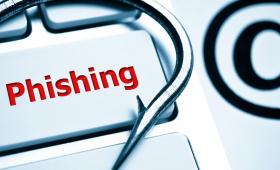
Security
As uncertainty and worry over the COVID-19 pandemic continue to mount, some scammers are capitalizing on the panic through phishing attacks designed to lure people into sharing sensitive information or downloading malicious software.
To keep yourself safe, here are some red flags to watch for as you sort through your inbox.
1. Emails that appear to be from trusted organizations
Cybercriminals often pose as officials from trusted organizations like the Centers for Disease Control and Prevention (CDC) or the World Health Organization (WHO). They buy domains that look legitimate, like cdc-gov.org, which is similar to the CDC’s real domain, cdc.gov. Before you click on any links, make sure the website matches the organization’s official domain.
2. Emails that request money or personal information
The COVID-19 outbreak is a rapidly evolving situation, and most emails you receive from trusted organizations will be informational. One sign of a phishing attempt is an email that asks for money or for sensitive information, like your bank account or social security number.
Don’t hand over any of your personal information or make payments or donations before thoroughly researching the source of the email. And remember: Neither the CDC nor the WHO accept payment via Bitcoin.
3. Emails offering cures or treatments for COVID-19
Some scammers are profiting off of fear by selling fake cures for the coronavirus. You may receive an email from someone offering a vaccine or treatment, but there are currently no over-the-counter products available in stores or online that will treat or cure COVID-19, according to the Federal Trade Commission.
4. Other warning signs.
If an email seems suspicious for other reasons, it could be a phishing attack. Phishing emails often have bad spelling and grammar, use generic greetings like “Dear sir or madam,” and create a sense of urgency by pushing users to act quickly, according to Norton.
For the latest official coronavirus information, head directly to the CDC or WHO websites. If you receive an email and you aren’t sure if it’s a phishing attempt, follow the FTC’s tips for recognizing and avoiding phishing scams.
 3 minutes read
3 minutes read
Finance
For most of us, a new car isn’t a purchase to take lightly. It’s a serious investment, and you want to be sure you’re getting the best price possible.
When you’re ready to buy a car, there’s more to consider than just the sticker price on the window. Here are a few things to keep in mind before you drive off the lot.
1. Ask about financing deals and other incentives.
If you plan to take out a loan to purchase a car, start researching the financing offers available from manufacturers and banks. If you’re buying a new car and you have good credit, many manufacturers offer low interest rates to entice customers, like 0.9 percent (or even 0 percent) for loans up to 60 months. Manufacturers may also offer discounts and rebates for recent college graduates or on certain makes and models.
If you’re buying a used car, interest rates tend to be higher, so you’ll have to decide if a used car is still a good deal at a higher interest rate.
2. Shop at the end of the year.
Year-end sales events are a great time to score a deal, according to Kelley Blue Book. By December, dealers are eager to turn over inventory and meet sales goals, which means they’re often willing to give buyers steep discounts in order to make a sale. Buying a car from the last model year can also lead to serious savings, especially if you’re not picky about the car’s color or special features.
3. Skip the add-ons.
Once you’re ready to buy your car from a dealer, the negotiation isn’t quite over. In many cases, dealers will try to sell add-on services like gap insurance and extended warranties for an additional fee. These add-ons can quickly drive up the price of your new car, and many of these services aren’t worth the extra money, or can be purchased at a later time for a better price.
4. Think twice before buying a car from a private citizen.
The FTC points out that buying a car from an individual doesn’t provide the same protections for buyers as purchasing from a dealer. During a private sale, the car is usually sold as-is. Even if the vehicle still has a manufacturer’s warranty, that warranty may not be transferrable to the new owner. So, do your homework ahead of time to make sure you know what you’re getting and that you’re comfortable with the potential risks.
 3 minutes read
3 minutes read
Finance
April 15 is fast approaching, but the looming deadline to file your tax return doesn’t have to be a source of stress. Here are a few ways you can ensure a smoother filing process for this year’s tax return.
1. Take inventory of all your documents.
Before you can get started on your taxes, you need to be sure you have all your important documents handy. These include forms that show your annual wages and income, like W-2 and 1099-MISC forms.
You’ll also need any documents that show social security or unemployment payments you received, or interest you earned on investments. If you run a business, you’ll also need your receipts for business expenses.
These are just a few of the possible documents you may need—if you own a home or pay interest on student loans, for example, you’ll need additional documentation. Check this list from the IRS for a full listing of the documents you may need.
2. See if you qualify for free tax prep tools.
You don’t necessarily need to hire an accountant or purchase software to file your taxes. Using IRS Free File, you can locate free tools that help make the process of filing your federal tax return a little bit easier.
If you earn less than $69,000 a year, IRS Free File can connect you to free software that helps you find tax breaks and fill out forms—some of this software can also provide free state tax returns.
If you earn more than $69,000, you can use the IRS’s forms to file your federal return online for free (although the IRS suggests only going this route if you have some prior experience filing taxes).
3. Set yourself up for success next year.
If this year’s tax return was a headache, learn from the process and start planning now for next year.
There’s no time like the present to clean up your record-keeping. If your taxes were more complicated than you expected this year, you may want to consider hiring a professional to handle your taxes next year.
By taking steps now to keep your tax information organized, you’ll be ready to dive into next year’s return with confidence.
 5 minutes read
5 minutes read
Banking
You try to stick to a monthly budget, but it seems like money comes out of your account faster than you can earn it.
If that sounds like a familiar situation, one of these expenses might be causing a silent but serious drain on your bank account.
1. Bank fees
Overdraft fees, ATM fees, international transaction fees, minimum balance fees—all of these charges add up to a lot of wasted money. To avoid getting hit with bank fees, look closely at your account’s terms and conditions. By choosing an account that fits your lifestyle and minimizes fees—and by knowing your account’s overdraft policies and ATM fees—you can keep more money in your bank account. To view the great account options at WaterStone Bank, visit https://www.wsbonline.com/.
2. Unused subscription services
Subscription services that automatically renew can sneak up on your budget. Ask yourself if you’re getting your money’s worth out of every streaming service, gym membership or subscription service you pay for. Also keep an eye out for free trials that are no longer free: To avoid making payments after your trial ends, set a reminder to cancel the subscription before the trial’s expiration date.
3. Credit card interest payments
If you only make the minimum payment on your credit card bill, you’ll pay handsomely for it in interest. To avoid interest fees, pay off your full credit card balance every month. If you’re too tempted to spend beyond your means, try paying off your credit card balance each time you make a new charge to help you stay on track.
4. New technology
Do you replace your smartphone like clockwork every year and jump at the latest model when a new gadget drops? These habits can be costly over time. You could save hundreds of dollars just by waiting a while to upgrade your gadgets.
When you decide it’s time for something new, take advantage of savings by opting for a slightly older model—something that’s still an upgrade from your old device, but not the newest (or priciest) technology on the block.
5. Extended warranties
Many big-ticket purchases, like cars or expensive electronics, offer extended warranties. The warranty might sound like a good idea, but a Consumer Reports survey found that more than half of people who purchase extended warranties never use them, and the people who use them end up paying more for the warranty than they receive in benefits. If you’re concerned about costly repairs, skip the extended warranty and set money aside in a savings account.
 3 minutes read
3 minutes read
Finance
As a homeowner, you know that your dwelling isn’t just a roof over your head—it’s a major investment. If you’re beginning to think about selling your home, now is the time to start tackling small home improvement projects that offer a big bang for the buck.
Whether you’re a renovation novice or the handiest homeowner on the block, here are a few projects anyone can tackle to help increase their home’s resale value.
- Put on a fresh coat of paint.
A fresh coat of paint is a low-budget way to revive your space, and you don’t need any special skills to do it. The supplies are inexpensive: All you need is paint, a few brushes, and tarps or plastic sheets to protect your flooring. For best results, be sure to prep the room and start with a coat of primer.
When resale is your objective, opt for neutral paint colors that will appeal to a variety of buyers. You may love that deep burgundy or bright neon green, but not everyone shares your taste. When in doubt, crisp white paint is a safe option.
- Update door and cabinet hardware.
Dated hardware on cabinets or vanities can look messy and unappealing to buyers. Luckily, swapping out your hardware is quick and easy—just be sure to measure your existing cabinet pulls before you head to the hardware store to buy replacements. You don’t want to end up with the wrong size. You may also want to update doorknobs if they look weathered or mismatched.
For a DIY hardware update that’s easy on the wallet, give your existing knobs and pulls a new look with a few coats of spray paint.
- Declutter your space.
When you’re ready to list your house for sale, spend some time decluttering. You’ll be amazed at the difference a little bit of tidying up can make. By clearing off kitchen counters, organizing closets and freeing up space throughout your house, you’ll help prospective buyers see the home’s potential, instead of getting distracted by the mess.
 3 minutes read
3 minutes read
Finance
Stuck in a budget rut? We understand. It can be a challenge to grow your budget while paying fixed expenses like rent or mortgage, auto loans, groceries and other bills, especially if you aren’t due for a big raise or promotion soon. But with a little creativity, it’s possible to find some extra wiggle room in your budget.
Here are a few easy ways to cut back on expenses and expand your budget—no side hustle required.
- Cut back on subscriptions.
When is the last time you took a good look at your subscriptions to streaming services like Netflix and Hulu? Are you paying for satellite radio that you barely listen to, or an expensive cable plan you hardly watch? What about all those free trials that stopped being free, and now you’re stuck paying fees each month?
Look through your bank statements to see if there are any services or subscriptions you can cut. The savings can add up quickly: By cutting just $20 per month in subscriptions, you’ll free up $240 per year to spend however you like.
- Take advantage of credit card rewards.
If you aren’t being rewarded for your purchases, you’re leaving money on the table. Consider opening a rewards credit card to accrue points and cashback for your everyday purchases.
WaterStone Bank offers three different types of rewards cards, with up to 3 percent cash back on eligible purchases. The more you use your rewards card, the more cashback you accrue, which is money in your pocket—and a serious boost to your budget.
Choose the card that best fits your lifestyle, from the Cash Rewards American Express® Card that offers tiered rewards with extra cashback on gas and groceries, to the Premier Rewards American Express Card that offers additional rewards for restaurant and airline purchases.
- Commit to one no-spend weekend every month.
How much do you spend on the average weekend? If your Saturday and Sunday plans usually include dinner, a movie and brunch, the bill can add up quickly, especially if you’re out with the whole family.
America’s Debt Help Organization suggests challenging yourself to a weekend of no spending. Enjoy a home-cooked meal, plan a picnic at the park, go for a hike or watch a movie on the couch. You’ll free up money in your budget while remembering that happiness doesn’t need to cost a thing.
 3 minutes read
3 minutes read
Banking
When it comes to investing, sometimes it’s good to find a middle ground. Perhaps you’re looking for a way to earn interest on your savings, but you don’t want to take on the risk of investing in volatile stocks.
A certificate of deposit—called a CD for short—might be the perfect Goldilocks solution you’ve been searching for.
What is a CD?
A CD is a type of savings account that lets you steadily earn interest on your money. By agreeing to keep your money in the account for a set period of time—anywhere from one month to five years—your investment earns a favorable interest rate.
How much will I earn on money in a CD?
CD interest rates are much better than the rates for general savings accounts.
For context, a traditional savings account offers an average interest rate of .09 percent, according to FDIC data from December 2019. A CD, on the other hand, can offer rates up to .97 percent. That means you could earn nearly eleven times more interest by opening a CD, rather than keeping your money in a general savings account.
CDs are also considered one of the safest savings options, according to the U.S. Securities and Exchange Commission. Your money earns interest without being exposed to the risk of the stock market.
What kind of CD is right for me?
Each CD comes with its own terms and interest rates. Check with your bank to see which products they offer and which CD best fits your lifestyle. Keep in mind, many CDs also require a minimum deposit—at WaterStone Bank, you can open a CD with as little as $100.
How can I maximize my return on a CD?
Shop around for CDs and select one that fits your goals. If you can set aside a large sum of money for a long period of time, you’ll be able to take advantage of higher interest rates, which means that over time, you’ll earn more money.
However, if you need access to your money soon, don’t open a five-year CD just because of a tempting interest rate. It’s better to earn a modest return on a CD with a short commitment than to spread yourself too thin.
Whether you’re working towards a short-term financial goal or growing your long-term savings, a CD can be a safe, reliable way to make your money work for you.
 3 minutes read
3 minutes read
Finance
For years, our smart phones have been more than just phones. We rely on them to take photos, check email and track our fitness. Now, you can use your smart phone as a payment tool with the power of mobile wallet technology.
Mobile wallets store your payment information on an app in your phone. When it comes time to make a payment, just wave your mobile device at a scanner and your phone will securely send your payment information to the merchant.
Many people are drawn to mobile wallet technology for the convenience: By simply swiping your device to make a purchase, there’s no need to dig through a wallet overflowing with plastic cards to find the right form of payment. All you need to do is download an app, enter your payment information and go.
Getting started with a mobile wallet
Common mobile wallet apps include Apple Pay and Google Android Pay. These apps come standard on iPhone and Android smartphones, but you can also use a third-party mobile wallet app, like Venmo or eWallet, which may offer additional features like payments between friends or the capability to store other personal information, including passport numbers and drivers licenses.
Keep in mind, not all types of mobile wallets are accepted by all retailers. Before deciding on a mobile wallet app, see which retailers and vendors will accept payments and make sure your favorite merchants are included.
Mobile vs. digital wallets: What’s the difference?
A mobile wallet is a type of digital wallet. A digital wallet (or e-wallet) is any encrypted system for storing payments online, whether that’s on your desktop, laptop or mobile device. A mobile wallet is an app that was created specifically for mobile devices, according to U.S. News and World Report.
Staying safe with mobile payments
Mobile wallet apps keep your information secure through encryption. But to be safe, Credit Karma suggests setting up two-factor authentication on your mobile device in case your phone ever ends up in the wrong hands; you may also want to install an app that can locate and remotely delete your personal data if your phone is ever lost or stolen.
 3 minutes read
3 minutes read
Finance
Hosting has its perks: When the party comes to you, you never have to leave the comfort of your own home.
But as your guest list increases, so do your expenses. The cost of food, drinks and décor adds up quickly when you’re hosting. If you’re entertaining on a budget, here are a few tips to keep costs in check so you can be the host with the most—without breaking the bank.
1. Make a grocery list and stick to it.
Before you step foot in the grocery store, make a shopping list and settle on your budget. If you head to the store without a list or a budget, it’s easy to get carried away and find yourself with a cart full of items you don’t really need.
Spend time putting together a menu using ingredients that offer the most bang for their buck so you can feed a crowd, even on a budget.
2. Think beyond sit-down meals.
Hosting your sister’s wedding shower but can’t afford to buy lunch for 20 people? Luckily, not all events need to revolve around meals. Host a mid-afternoon shower with tea and sweet snacks. By planning your party at a time when people don’t expect a full meal, you’ll save on food costs.
You can also host a potluck where everyone brings a dish to share. This frees you up to focus on the main course and leave the sides, appetizers and desserts to your guests.
3. Decorate on a dime.
Yes, it’s possible to create a picture-perfect party on a tight budget! Borrow décor from friends or whip up your own DIY projects to spruce up the space. Head to Pinterest to find decorating ideas, or start with this list full of low-cost décor inspiration for your next soiree.
Spend where it counts.
Will your guests remember your elaborate centerpiece for years to come? Probably not. There’s a better chance they’ll remember your delicious artichoke dip, or that awkward moment when the wine ran out. Better to put your money toward creating an amazing experience for guests than curating a beautiful space that’s more fashionable than functional.
At the end of the day, remember that your party is an opportunity to bring people together. Whether you host a picnic potluck or a five-course dinner, the lively conversation and memories you make don’t cost a thing.
 3 minutes read
3 minutes read
Finance
Between gift-giving, traveling and hosting, the most wonderful time of the year is also one of the most expensive.
During the holidays, it’s also dangerously easy to throw caution to the wind when it comes to your budget. After all, what’s another $50 on a treat for yourself when you’ve already spent $500 on everyone else…?
An occasional indulgence won’t break the bank, but if you succumb to too much spending temptation, your holiday budget could go off the rails. Here are a few tips to help keep spending in check this holiday season.
1. Build a budget with wiggle room.
Expect the unexpected and create a holiday budget that leaves room for surprise costs. You never know when you’ll need to buy a last-minute gift for an unexpected guest at family dinner.
If you’re traveling, remember to plan for expenses like gas, cabs or ride shares, and food at the airport. Decide in advance what you’ll spend on gifts; pick a dollar amount for each person on your list. If you shop with a plan to spend a maximum of $40 per person, for example, it’s easier to stick to your budget and avoid going overboard.
2. Use rewards to offset costs (or to treat yourself).
All year long, you earn points on bank cards and credit cards. Now, it’s time to put those points to work!
Check each of your cards to see if you’ve earned cashback or rewards that you can redeem for gift cards and retail goods. If you have a WaterStone Bank Debit Card, you can redeem your ScoreCard® Rewards Card points for branded merchandise and travel, which can make a serious dent in holiday expenses.
3. Find joy in the season without spending.
You don’t need to spend money to make the most of the holidays. Take a tip from Real Simple and resist the urge to stock up on seasonal décor that you don’t really need, or trendy toys that will only entertain the kids for a few hours. Instead, embrace the season’s joyful moments that don’t cost a dime, whether that means sledding with the family, sharing stories among friends or watching the snow fall from your window.
 3 minutes read
3 minutes read
Finance
Ah, the holidays. It can be the most joyful—and sometimes the most stressful—time of the year.
For many of us, the holiday season means a busy social calendar, long shopping lists, and extra travel to be close to loved ones for every occasion. You may already have a budget for gift-giving, but travel expenses can also stack up quickly, especially when you’re traversing the country to attend each celebration.
But holiday travel doesn’t have to be a drain on your bank account. Follow these tips, and you could save money as you move from one holiday event to the next.
Make it a road trip.
In general, driving is cheaper than flying. If your destination is close enough that you can get there by car, you could easily save hundreds of dollars on airline tickets. Find additional savings by carpooling with friends and family and splitting up the cost of gas (and the rental car, if you use one).
Book flights strategically.
If you choose to fly, don’t procrastinate when it comes to booking your flight. Experts agree that it’s wise to start keeping an eye on flight prices sooner rather than later. If you wait to book until a few weeks before Thanksgiving or Christmas, you could get stuck paying exorbitant prices. On the other hand, you could get lucky and score a last-minute deal—but it’s a gamble. If you know your holiday plans a few months in advance, booking early is generally a safer bet.
To save even more on flights, AAA suggests avoiding peak travel days. If you don’t mind spending time in the airport on a holiday, you could find cheaper flights on Thanksgiving or Christmas Eve.
Flying on Dec. 26, on the other hand, comes at a cost—it’s the most expensive day to fly during the week of Christmas, according to AAA.
Cash in on points and loyalty programs.
Being loyal to your favorite brands can pay off, especially when that loyalty earns you a free hotel stay or flight. Check your hotel and airline accounts to see if you have enough unused rewards to qualify for any freebies. Even small wins, like one free night of a four-night hotel stay, can add up to serious savings over time.
 3 minutes read
3 minutes read
Finance
If your car keeps making that rattling noise that just won’t quit, you might be wondering: Should you pony up and pay for the repairs? Or are you better off buying a new car?
The answer depends on your situation. After all, you don’t want to waste money fixing a car that will need to be replaced soon, but you also don’t want to splurge on a new ride if your car has a few good years left on the road.
To help make your decision, ask yourself these questions:
1. How frequently are you going in for repairs?
The cost of auto repairs can add up quickly. If your car’s list of problems is constantly growing, it may be time to consider buying something new.
On the other hand, if you’re facing a one-off maintenance issue, or an expense associated with normal wear and tear—for example, purchasing new tires—this comes with the territory of owning a car. If your car is only a few years old, you probably don’t need to buy a new vehicle yet. But you may want to set money aside in a rainy day fund so that you’re prepared to pay for the occasional repair.
2. Would repairs cost more than the value of your car?
Check the Kelley Blue Book to find the approximate value of your car. Then, consider the cost of repairs against the value of your vehicle. If you’d spend more money replacing the breaks than your car is worth, you’re probably better off buying something new. But if you have a newer car, it may be a better deal to pay for repairs than to start browsing the latest models on the lot.
To determine how long you can expect your car to be roadworthy, ask a trusted mechanic to examine it for problems. This appointment is a small price to pay for peace of mind, or for confirmation that it’s time to consider a new car.
3. Have car troubles endangered you or your family?
If frequent car trouble has left you stranded, late to work, or stalled in the middle of the road, it’s time for a new vehicle, according to Edmunds. Ultimately, your safety is worth more than trying to save a few bucks.
4. Does a new car fit into your budget and your lifestyle?
Whether you’re looking at buying new or pre-owned, consider if you’re ready for everything that comes with a new car: Can you afford the monthly payment? Would your insurance premium increase? What kind of loans and interest rates are available?
Do your research before you kick your old car to the curb and make sure that a new vehicle fits within your budget and in your lifestyle.
 2 minutes read
2 minutes read
Finance
Your credit score is one of the most important parts of your overall financial picture. A high FICO credit score can open doors: It makes it easier to attain loans, credit cards, and to secure lower interest rates.
If your credit history has a few blemishes, you might have a low credit score, which can make it harder to attain credit, loans or favorable interest rates. A high credit score is around 700 to 850, and a low score is around 300, according to the Federal Trade Commission. A good rule of thumb is that a score above 670 is good.
Luckily, there are ways you can improve your score. It doesn’t happen overnight, but with persistence and patience, you can recuperate your credit score by following these tips.
- Always pay bills on time. Payment history is the single largest factor in determining your credit score. Stay up to date on all your credit card bills, mortgage payments, and other bills to bolster your score.
- Avoid opening new lines of credit. It can damage your credit if you open too many new credit card accounts in a short period, according to Debt.org.
- But don’t be too quick to close old credit cards. Even if you hardly use your first credit card, leave the account open. Your length of credit history impacts your credit score; FICO awards a higher score to people with longer credit histories. It’s wise to keep your oldest account open, even if it sits unused.
- Be mindful of your credit utilization. The more of your credit you use, the more likely your credit score is to suffer. That’s because your credit utilization rate—the amount of credit you use divided by the amount of credit you have available, according to Experian—also plays a role in calculating your credit score. Aim to use no more than 30 percent of your total available credit. You can accomplish this by simply using less credit, or by asking for higher credit limits on your existing accounts.
- Correct errors in your credit report. Request your free credit report—you’re entitled to one every 12 months. Then, check for errors, and follow FICO’s guidelines for identifying and disputing mistakes. Common issues include clerical errors and missing account information, which can negatively impact your credit score. If you find errors, contact the credit bureau. These corrections can ultimately help increase your score.
 3 minutes read
3 minutes read
Finance
If you have a taste for the finer foods in life, you already know: Managing the cost of groceries can be tough.
But food expenses don’t have to eat through your monthly budget. With a little bit of planning and thriftiness, you can keep food costs in check while still satisfying your cravings and your nutritional needs.
- Buy seasonal produce.
Fresh fruits, vegetables and herbs are more affordable when you buy them in season. Check the U.S. Department of Agriculture’s Seasonal Produce Guide for guidelines, or use SeasonalFoodGuide.org to see which items are growing now in your area.
- Stock up on affordable pantry staples.
Shelf-stable pantry staples aren’t just convenient—they’re often even cheaper than their fresh counterparts. Canned vegetables, beans, and proteins like chicken and fish provide both ease and affordability. To save even more money, and to cut back on sodium, use dry beans instead of canned beans.
- Make friends with the freezer aisle.
If you struggle to finish all your fresh fruit and veggies before they go bad, the freezer aisle offers a budget-friendly solution. Stock up on frozen fruits and vegetables so that your favorites are always within reach. You’ll save money and avoid the guilt of throwing spoiled produce in the trash.
- Buy in bulk.
If your family goes through pounds of rice, pasta or other dry staples every week, think beyond pre-packaged foods and walk back to the bulk section. It’s generally a better deal to buy in bulk than it is to purchase in smaller quantities, especially for items you use often, from grains, nuts and cereal to paper goods, like toilet paper and paper towels.
- Be savvy with coupons.
Gather coupons from newspaper ads, store mailers and email promotions. Some grocery stores have their own shopping apps where you can gather digital coupons. While you’re at the store, the USDA recommends watching for deals right in front of you, like peel-off coupons on packages and coupons set up along the aisles.
- Compare your options.
Don’t just reach for the first package you see. The Academy of Nutrition and Dietetics suggests checking unit prices or prices per serving—these numbers can help you determine which item is really the best deal. In general, generic items are cheaper than name brands.
Your grocery trips may take a little longer as you start comparing your options and gathering coupons, but by following these tips, you’ll create smart shopping habits that can save you money in the long run.
 2 minutes read
2 minutes read
Finance
When your teen leaves the nest and heads to college, they are embarking on an exciting, independent next chapter in life. But are they ready to face a new financial reality after unpacking the dorm room and exploring campus?
As your child prepares for college, consider the financial lessons you want to impart before they strike out on their own. By stating important conversations about money now, you can be confident your child is equipped to make sound financial decisions that lead to a lifetime of success and prosperity.
Consider talking through these topics with your teen before they head to campus:
- Budgeting basics. Hopefully, your teen has watched as you’ve modeled good financial behaviors over the years, including keeping a budget to track expenses. A basic spreadsheet can go a long way in helping teens keep track of fixed costs, like rent, and variable costs, like food and shopping.
- Saving for a rainy day and other big-ticket expenses. If your teen is working while in school, it may be tempting to pocket extra cash for a dinner out or a shopping trip. While there’s nothing wrong with the occasional treat, remind your child about the importance of establishing an emergency savings fund for big-ticket items like a new laptop or a spring break trip that won’t be paid for by mom and dad.
- What credit can (and can’t) do. Encourage your child to start building good credit early. Talk about the dos and don’ts of credit cards, including the importance of always paying bills on time and avoiding carrying a balance. For teenagers who can’t get approved for their own credit card, NerdWallet offers a few tips on other ways to start building credit early.
- The long-term impact of student loans. Sit down with your teen and walk through the different options available for financing their education. Include them in the FAFSA process; fill out the forms together, and calculate what their loan payments could be after graduation. A school that requires a six-figure loan to cover tuition could translate into mortgage-size monthly loan repayments after your child graduates. Help your teen decide on a school that fits both their educational and financial goals.
 2 minutes read
2 minutes read
Finance
Every parent wants their child to grow up into a financially savvy adult. But for young kids, money can seem abstract and a little boring—especially when they’re used to toys and treats that seem to magically materialize without understanding what it takes to earn a dollar.
If you’re stumped on how to start teaching your kids about personal finance, consider assigning chores around the house and rewarding kids with an allowance. It’s a hands-on way to illustrate money lessons, even for the youngest members of your household.
But before you start doling out cash each week, think ahead about how you plan to approach chores and money with your kids:
- Decide which chores you’ll pay for—and which you won’t. Some chores, like making the bed, occur daily. Others might be sporadic, like shoveling snow or dusting picture frames. Chances are, you won’t pay for every chore. Decide which chores will be rewarded with an allowance, and use a chore chart to make it easy for you and your kids to keep track of progress.
- Help kids decide how they’ll use their earnings. Instead of handing over cash without any limitations, work with your kids to come up with a savings and spending plan for their allowance that you can both agree on. Maybe half of their earnings go toward saving and the other half can be spent as your child pleases. The American Bankers Association also suggests the “three jars” method: One jar for spending, one for saving, and one for making contributions to your child’s favorite charity, to start instilling a philanthropic attitude early in life.
- Be a model of good spending and saving habits. Young kids are sponges and they learn by example, so it’s important for you to model good habits like paying bills on time and sticking to a budget. The ABA also recommends opening a savings account in your child’s name and making regular visits to the branch together to make deposits. At WaterStone Bank, our Blue's Jr. Bankers Savings Account teaches kids to master the art of saving and establish good financial habits while they earn rewards. Even something as simple as giving your child a wallet or piggy bank can make personal finance more interactive, fun and memorable for children.
 2 minutes read
2 minutes read
Banking
Your relationship with your bank isn’t so different from the other relationships in your life—and despite our best efforts, some relationships must ultimately come to an end.
A break-up with your bank doesn’t usually happen out of the blue. It might start with a small frustration—why aren’t there any ATMs nearby? Why is it so hard to get ahold of customer service?—and then escalate as your frustrations continue to mount. But you don’t have to stick with a bank that doesn’t meet your needs; you should feel empowered to switch banks if your current bank isn’t giving you everything you need.
Wondering whether it’s time to call it quits with your bank? If you’re facing any of these issues, it may be time to move on:
- High fees. If you’re paying an arm and a leg in annual fees, it never hurts to shop around for a better deal.
- A lack of products that fit your lifestyle. Sometimes, a simple checking and savings account don’t cut it. If you’re an entrepreneur and your bank doesn’t offer products for small business owners, for example, search for a bank that can provide all the products and services you need under one roof.
- Poor service. It’s simple: You deserve attentive customer service with a personal touch. If the customer service is lacking at your current bank, it’s time to call it quits.
Luckily, switching banks doesn’t have to be a painful process. Follow three simple steps for a seamless transition:
- Open your new bank account.
- Transfer your money and update your automatic payments and deposits. Many banks go the extra mile to make this step painless for customers. At WaterStone bank, our QuickSwitch forms help you cover all your bases, so you won’t miss a single paycheck or utility payment after you finalize the switch.
- Close your old account. Just make sure any outstanding checks or transactions have cleared before you take the final plunge.
Thinking of switching to WaterStone Bank? Give us a call at 414.761.1000 (toll-free at 888.686.7272) or visit your nearest branch to meet with a representative who can help you create a personalized banking solution to achieve all your financial goals.
 2 minutes read
2 minutes read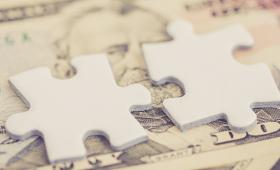
Banking
There are countless banks and financial institutions vying for your business every day. But how do you determine which type of bank is the best fit for your needs and goals?
To make the process of choosing a bank a little easier, we’ll walk through the differences between three of the most common players: Large banks, community banks and credit unions.
Large banks are national banks with a vast presence around the country (and sometimes around the world). Large banks usually offer a variety of products and services, which can be ideal for the customer who knows exactly what they need. Frequent travelers may also find that large banks have a larger ATM network than smaller banks. On the other hand, large banks offer less personalized customer service than smaller banks that are rooted in the community.
Community banks are locally owned and operated banks. These institutions are quite literally invested in the local community by providing loans to neighborhood businesses and bolstering the local economy. For entrepreneurs and small business owners, community banks like WaterStone Bank rank highest in customer satisfaction compared to large banks and online lenders. For individuals, community banks offer a more personal and relationship-focused approach to banking than larger institutions.
Credit unions are not-for-profit financial cooperatives. MyCreditUnion.gov points out a few key differences between credit unions and banks, including the member-owned and cooperative structure of credit unions, which means members vote to elect a board of directors and can take out loans against each other members’ deposits. Credit unions provide many of the same services as banks but sometimes offer better interest rates on loans and lower fees.
Ultimately, each bank and credit union is a little bit different. It’s important to ask questions, compare your options and shop around before deciding which bank or credit union is right for you.
Want to learn more about personal or business banking with WaterStone Bank? Give us a call at 414.761.1000 (toll-free at 888.686.7272) or visit your nearest branch to learn more about how WaterStone Bank is committed to providing banking solutions to individuals and entrepreneurs while also supporting southeastern Wisconsin community.
 1 minutes read
1 minutes read
Finance
Have you ever wondered whether a spending plan is right for you? By answering a few simple questions, you may have a better sense of the control you could gain in your financial life.
- Would you like to know whether you will have enough money to pay your bills come their due date?
- Are you looking for a better sense of management of your money?
- Do you hope to build assets that will improve your quality of life?
If you answered yes to any of the above questions, keep reading!
Financial goals are specific to how you want your money to work, within a desired time period. To begin, you must clearly identify your financial goals, continually educate yourself on additional ways to achieve your goals, and routinely evaluate your progress.
Once you have made the commitment, it is time to begin!
- Create a 30-day spending diary and keep track of where you spend your money each day.
- Determine your monthly income and expenses.
- Identify ways to decrease spending.
- Find ways to increase income.
It is important to note that income may come to you from a variety of sources including wages, public assistance, alimony, interest and dividends, and social security.
It is also important to differentiate the two categories of expenses: fixed and variable. Fixed expenses do not change from month to month. This would include your rent or mortgage payment. However, you are in the driver’s seat with variable expenses! For instance, you may choose to lower your thermostat during the winter to save on heating costs, or to carpool or walk to your destinations to decrease fuel expenses.
There are a multitude of ways to save money by decreasing your spending. You may eliminate or control your credit card use to avoid interest expense, use coupons to save money on items you already purchase, take your lunch to work instead of eating out, or pay your bills on time to avoid late fees.
One of the most obvious ways to increase your income is to get a second job. However, there are also tax credits that you may consider:
- Earned Income Tax Credit (EITC)
- Child tax credit
- Credit for child and dependent care expenses
- Education credits
- Tax credits for retirement savings contributions
Whatever your goal, take the first step today in creating your spending plan. You won’t regret it!
 1 minutes read
1 minutes read
Finance
It’s not an easy process and may include outcomes that evolve over time, but defining your goals early can help you achieve sustained financial success. Below are some common inputs to a desirable financial life that may help you get started!
- Owning a home
- Traveling without going into debt
- Saving for a financially secure retirement
- Paying less in income tax
- Earning more on investments
- Being able to afford college education for self or family
- Having assets to pass on to heirs
These are relatively concrete concepts with costs that can be calculated. However, there is more to a good financial life than just long-term goals. Short-term and intermediate-term goals can help ensure you are on the right path and making smart decisions.
- Living in a safe, comfortable home (whether owned or rented)
- Having reliable transportation
- Affording gifts for loved ones
- Taking nice vacations
- Accumulating net worth
- Reducing or eliminating debt
- Saving for retirement and college education for family
There are also intangibles that should be considered on your journey:
- Feeling in control of your finances
- Handling financial decisions without too much stress
- Making progress toward your long-term goals
All of these things are within your reach, but each takes time and effort. The key is to start early, learn as you go, make fully informed decisions, avoid major mistakes, and balance your goals.
Learning to manage your finances intelligently can be challenging and different than mastering most skills. There are many variables, and those variables change over time. You have different jobs and income levels, your expenses change, unexpected expenses arise, investment markets fluctuate, tax rules change, and your goals change.
In addition, our minds may not be naturally accustomed to thinking about finances the way we should. We all tend to want immediate gratification and believe we are in control of all aspects of our lives. Achieving financial goals, whether long-term, short-term, or intangible requires that we make decisions that balance our priorities.
The good news is that all of the tools and information you need to improve your financial literacy are readily available, and you have access to all the products and services you need. If you ever feel you need some assistance along the way, we’re here for you! Stop into a branch today and meet with our friendly and knowledgeable staff.
 2 minutes read
2 minutes read
Finance
Teaching kids about money is something that can begin as early as pre-school. After all, money habits form in children by the time they are 7 years old, mostly by observing you. Those little eyes are always watching!
A budget is a great place to start. Create a game by taking your child to the grocery store with $100 to spend and a food list for the week. Let them help you add the cost of the groceries and determine how to cut back where appropriate. This will teach them that money doesn’t always cover every want. It can also demonstrate ways to save such as purchasing generic brands and using coupons when available.
Another strategy is to encourage your children to start saving money on a regular basis. When they receive money as a present or weekly allowance, they may immediately think of ways they can spend it. Introduce the “Save, Share, and Spend” model by labeling three jars. To start, you may instruct them to put 10% in the “Share” jar, and split the remaining 90% between the “Save” and “Spend” jars based on their goals. Help them create their own budget by determining what they would like to save for with the money in the “Save” jar. Each week you can review together how much they have saved to date and how much they need to accomplish their goal.
Teach your children about the stock market and ways they can invest money. Is there a particular brand, store, or restaurant they enjoy? Start by purchasing a share or two and show them the daily fluctuations in the stock price. Let them see that while you may lose money at times, eventually most stocks increase in value.
Helping your kids learn the basics of finances at a younger age will instill financial values so they make smarter money decisions as adults.
 2 minutes read
2 minutes read
Banking
Given today’s fast-paced, technology-driven world, it’s no wonder that banking activity has shifted to electronic and paperless, especially when convenience is a factor! We’re all strapped for time and looking for any way to gain a few extra minutes in our days.
For many of us, we fall into a habit because it’s easy. We don’t take the steps to change without some type of incentive. When you consider the incentives below, you should understand why you need to change to mobile, paperless banking (if you haven’t already)!
Around-the-clock access to banking information, allowing you the freedom to view account balances, check on the status of a transaction, pay bills, and more from any mobile device. You may even deposit checks without ever having to step foot into a bank! Talk about a huge time savings!
View up to 90 days of account activity anytime, anywhere without waiting for your monthly account statement.
Quickly identify potentially fraudulent activity on your account, and address the situation before it escalates.
Pay your bills online. Never order another box of checks again (not to mention stamps to mail those checks)!
Eliminate your paper trail and the need to shred confidential materials. Save the trees!
Still on the fence? Give us a call at 414.761.1000 (toll-free at 888.686.7272). Our Customer Service Team would be happy to discuss how mobile banking can work for you!
 2 minutes read
2 minutes read
Community
Do you have a worn U.S. flag? Customers are invited to bring their flags to their local branch to receive a free flag retirement ceremony and proper disposal (no limit).
Thank you for helping assure that the U.S. flag receives deference and respect during its display and at the time of its retirement.
Special thanks to American Legion for performing the retirement ceremonies.
If you are a veteran, we invite you to take advantage of the many benefits of our Military Valor Program, including a complimentary U.S. Flag.
For more information, please call Customer Service at 414.761.1000, or toll-free at 888.686.7272.
 2 minutes read
2 minutes read (888) 686-7272
(888) 686-7272

